Tanzania 2012 February
Photo Safari
Trip Report
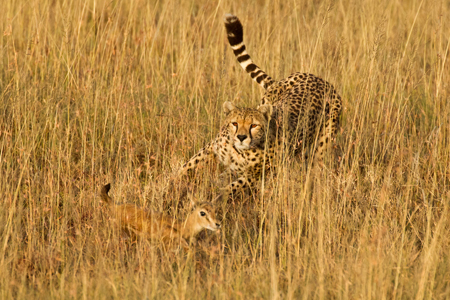
Read our Complete Trip Journals,
of our 2011 Trips
2011 Trip Report Summary
Safari One
Safari Two
Read our Brochure for 2012
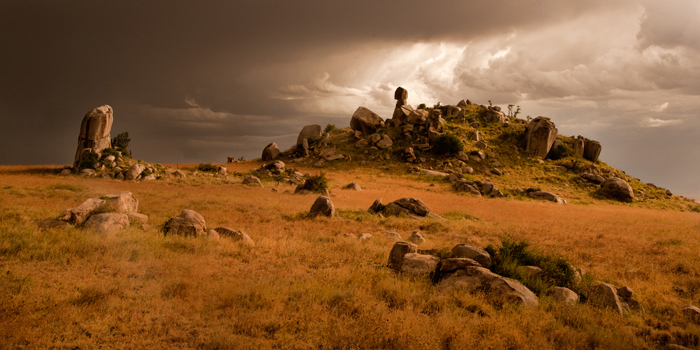
Ever since I was in high school and read The Tree Where Man Was Born, written by Peter Mathiassen with photos by Eliot Porter, I've been enchanted by kopjes, and the Gol Kopjes in the Serengeti are perhaps the best of several scattered throughout the park. Kopjes are literally islands in a sea of grass, a separate ecosystem due to the soil, rocks, and water collection, and are favorite haunts for cheetahs, lions, and other wildlife.
Our only Serengeti Trip this year followed our special Kenya Photo Safari for predators, where we had spent ten days in the predator-rich Masai Mara. Photographing in the Serengeti is usually harder and a bit less productive on an hour-to-hour basis compared to Kenya, but the experience is different - wild, less crowded, and with each wildlife encounter a new, special and rewarding tree. For whatever reason Mary and I enjoyed this trip as much, or more, than we had any other Tanzania trip. It was spectacular.
While the following account is my day-to-day journal, as I write this foreword several memories and visuals come to mind. Hundreds of Abdim’s and European White Storks winging their way overhead at dawn, their colors a subtle suggestion in the early predawn light. A visual tsunami of herbivores, a tidal wave of gnus and zebras sweeping across the yellow sea of grass, the beginning of the great migration as a united front miles long and a half mile wide. Cheetah families, less than two months old, at dens, seeking shade beneath our vehicles, capturing prey. While not a shooting opportunity, one of my most enjoyable moments was simply watching a cheetah stalk, chase, and catch a Thompson’s gazelle out of a huge herd. As photographers, these observable moments are too few, but precious, as there was no distractions in trying to get the shot. Leopards – the best we’ve ever had in the Serengeti, with three different wonderful opportunities.
Coming right from the Mara, where we always expect action and plenty of subjects, we were, mentally, prepared for a slower pace. We didn’t have one. And, in contrast to Kenya where, in a very small area, far too many tourist vehicles, too many camps, and too many lodges threaten to ruin the experience, the Serengeti offered a vastness, an emptiness, a sense of wilderness that is truly unique. On many days ours’ were the only vehicles we’d see, and on others we saw only a few. Only in the heart of the park, at Seronera, did we experience terrible crowds, and then only one day after we were first at a great leopard!
We’ll be doing this trip, and Kenya, again next year, but here’s the Journal from this year’s trip:
Day 1-2.

Most of us commuted from Nairobi to Arusha via a private bus charter, making the transport of luggage and the border crossing easy. Two in our group, Tom and Natalia, arrived early, and visited Arusha National Park, where they had some luck with colubos monkeys, zebras, and giraffes. We arrived without event, had a welcome dinner near the pool of surprisingly good pizza (for most), and prepared for our travels to Ngorongoro.
The drive to the crater, once a gauntlet of miserable, dusty, minefield-like potholes that required hours of bouncy, insufferable travel, is now a paved, smooth, well-drained road right up to the entrance gate to the crater. This year, we were using specially modified vehicles for easy window-level shooting, which are prohibited in the crater because of a worry about lions. Our outfitter pulled strings, and we were granted access, which is not a problem in the Serengeti – different rules!
We stopped at several overlooks where we could see much of the floor of the ten mile wide caldera. The crater is the remnants of a volcano that was at least 13,000 feet high, and may have been over 18,000 feet, higher than Kilimanjaro. The volcano, instead of blowing off its top like Mount St. Helens in Washington, simply collapsed upon itself, leaving a canyon-like wall completely encircling the crater floor. The floor is relatively flat, probably from the accumulation of volcanic ash, either from what cones were produced after the collapse, or from the eruption of other nearby volcanoes. At any rate, the view is spectacular, framed by moss and lichen festooned trees, or by a tree-like Euphorbia tree that resembles a large cactus.
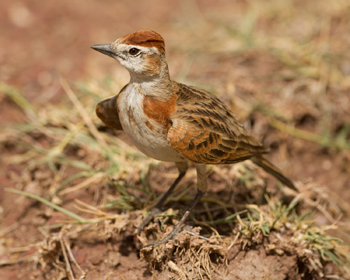 We stopped several times in our descent, photographing the crater as panoramas or as vignettes where trees or euphorbias framed the distant views of the steep slopes. We soon spotted baby gnus, and we hope that we’re not too late to photograph some of the birthing that, when the timing is right, is so easy to get here. Last year, at this exact time, barely a gnu baby could be seen, while two years earlier these same dates were dead-on at the peak of birthing. We’ll see tomorrow if we’re near the peak.
We stopped several times in our descent, photographing the crater as panoramas or as vignettes where trees or euphorbias framed the distant views of the steep slopes. We soon spotted baby gnus, and we hope that we’re not too late to photograph some of the birthing that, when the timing is right, is so easy to get here. Last year, at this exact time, barely a gnu baby could be seen, while two years earlier these same dates were dead-on at the peak of birthing. We’ll see tomorrow if we’re near the peak.
The shooting was good, although in the high light of mid-afternoon I didn’t shoot much, although the group had great opportunities with warthogs, bushbuck, baboons, and various birds. We saw four of the Big Five, spotting two distant black rhinos, and four lions, in addition to the elephants and buffalo that were scattered across the plains.
We raced up the north-eastern slope of the crater to our lodge, passing through the gate just before 6, giving Mary and I time for a shower and a glass of wine as we watched the sun disappear behind the crater’s rim.
Day 3, Ngorongoro Crater.
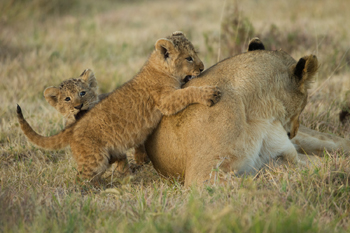
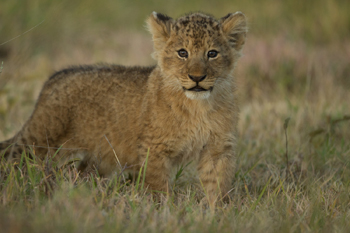
We loaded our vehicles at 5:45, in complete darkness, but by the time we descended the long winding road into the crater first light was brightening the eastern sky. The descent is nearly 2,000 feet, going through a magical acacia forest before transitioning to a scrubby/shrub zone, and then the grasslands of the bottom.
We encountered lions early, and while we watched a beautiful black maned lion, that did not cooperate but instead walked off, we spotted a lioness and two small cubs. The lioness ended up walking directly to our vehicle – an open windowed Toyota – and drank behind our vehicle. The family continued, and in the first light of sunrise we had a nice sequence with the three.
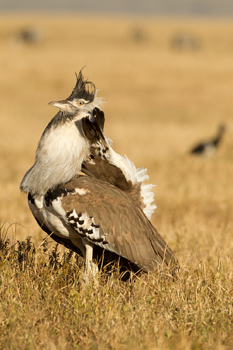 Later we had an excellent kori bustard, Africa’s heaviest flying bird at over 30 pounds, in full display. The display of the kori involves a fluffed up white neck and a puffed up white tail, really the undertail coverts, creating either a sharp white V or, more often, two bright parallel white posts moving through the grasslands. The display is usually just visual, alerting rivals, or interested females, but the males can create a loud booming noise as well.
Later we had an excellent kori bustard, Africa’s heaviest flying bird at over 30 pounds, in full display. The display of the kori involves a fluffed up white neck and a puffed up white tail, really the undertail coverts, creating either a sharp white V or, more often, two bright parallel white posts moving through the grasslands. The display is usually just visual, alerting rivals, or interested females, but the males can create a loud booming noise as well.
As we headed towards breakfast we spent a lot of time with a large herd of common zebras, many of which briefly sparred, or chased one another about. At breakfast, a large, one-tusked bull elephant walked closeby, going right through the picnic area quite close to vehicles and to the tourists that made room.
Lions, a distant rhino, and bull elephant, and various birds rounded out the morning, before a noon siesta while we waited out the heat of the day.

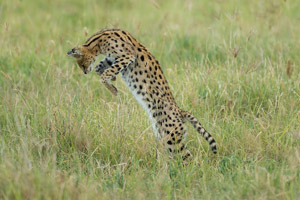
The serval was shy, and hunkered down whenever more than one vehicle was present. My vehicle drove off, but the cat stayed hidden. Just before Mary left the serval rose again from the grasses and proceeded to leap, trying to catch a mouse.
After lunch, nearly 3PM, we headed to the westernside of the crater, filming zebra and baby gnus. The afternoon ended with three Serval Cats – Ron spotted one, and when we stopped another popped up beside the road, but the two were not cooperative. Within a mile of that spot, I saw another, just as it ducked back into the grasses. All of our vehicles waited but the cat stayed hidden, but we waited, and backed off, and the serval reappeared, now unconcerned. We made some nice portraits, before it disappeared when Mary’s vehicle returned. We left, and she had the serval leaping for prey. A very rewarding day.
Day 4, Ngorongoro Crater to Naabi Hill, Serengeti
We loaded at our usual time, 5:45AM, and packed our vehicles for our move from the lodge to our tented camp in the Serengeti. The drop from the crater rim and our lodge to the crater floor is about 2,000 feet, on a somewhat winding road that brings us down to the crater floor shortly before sunrise. I spotted two lions walking along the crest of a hill, a lioness and a 4 or 5 year old male that I can only assume was part of the pride we had yesterday close by. The pair walked by, close to the water puddle that we anticipated they’d visit, but didn’t, and they continued on, uphill, through a trackless area.
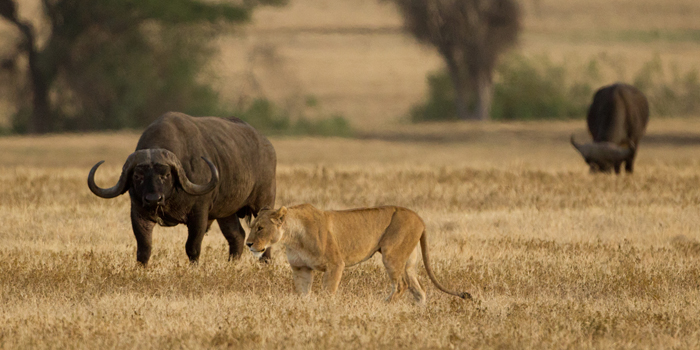
Three lionesses showed interest in some buffalo, but with a herd lions have virtually no chance of success. Instead, buffalo become the aggressors, and these chased the lions off.
We continued, looking for gnu’s about to give birth, and encountered three lionesses that appeared to be hunting a buffalo a short distance from the rest of the herd. Buffalo are team players, and will defend one another if attacked, and we suspected their efforts were either practice, play, or simply futile, as it ended up that the buffalo chased the lions, and the lions rarely disturbed the buffalo. After a short time everyone settled down, and we moved on.
We drove up on two Bat-eared Foxes that were skittish and ran up the rode as we continued on our way. Eventually they veered off and settled at a den, giving everyone their first good views of the foxes, although the shots were mediocre at best. Later, we encountered a large group of young hyenas of various ages, with the two youngest playing and wrestling continually. This shooting was better, but still a bit distant.
Mary found a gnu that appeared to be about to give birth, as she was dripping amniotic fluid and lying on her side. No legs were visible, but we thought that next step would be soon, but we waited an hour and the female showed no further progress. We suspect she was going to have trouble, and we moved on to a 9AM breakfast.
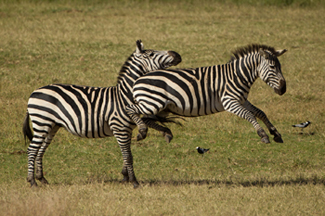
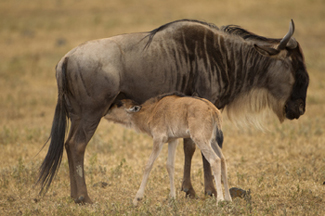
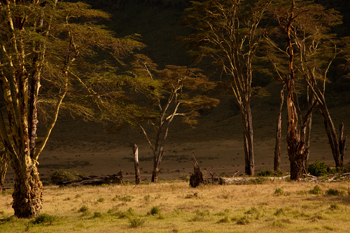
 Common zebras chased one another and occasionally fought -- this one kicked, rising completely off the ground; Gnu mother and calf; the yellow fever or yellow-barked acacia trees near Lerai Forest; and one of many flights of Crowned Cranes soaring into a marsh.
Common zebras chased one another and occasionally fought -- this one kicked, rising completely off the ground; Gnu mother and calf; the yellow fever or yellow-barked acacia trees near Lerai Forest; and one of many flights of Crowned Cranes soaring into a marsh.
At breakfast we met Mark and Jocelyn from our Kenya trip who were now doing a private safari, as, apparently, the other participants had cancelled and they now had a vehicle to themselves. For the second day in a row a huge flock of Crowned Cranes flew overhead, around 11AM, to settle into the marshes. After breakfast we headed towards the crater rim, stopping en route several places for landscape images, and, to my surprise, we didn’t arrive at the gas station at the top until 1PM. Where did the time go?
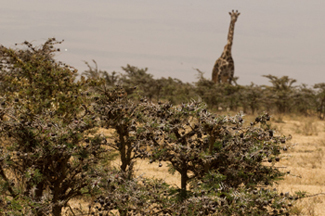
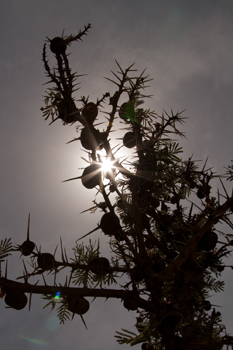
The whistling thorn acacia tree hosts a symbiotic ant that protects the plant from grazers, while providing the ant colony with shelter in the form of these black galls.
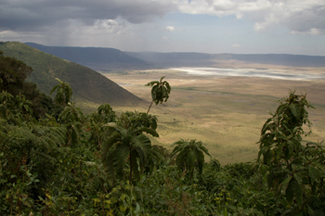 En route to the Serengeti we stopped at a pullover where we filmed the Whistling Acacia Trees, with the black galls that house a symbiotic ant. Apparently the ants bite or inject the plant to stimulate a gall, which the ants then use as a home or base. If tapped, the ants swarm out, ready to protect the acacia plant by either biting or firing formic acid (the adults point their abdomen’s skyward, so I’m assuming that they are going to spray).
En route to the Serengeti we stopped at a pullover where we filmed the Whistling Acacia Trees, with the black galls that house a symbiotic ant. Apparently the ants bite or inject the plant to stimulate a gall, which the ants then use as a home or base. If tapped, the ants swarm out, ready to protect the acacia plant by either biting or firing formic acid (the adults point their abdomen’s skyward, so I’m assuming that they are going to spray).
We stopped for lunch at Oldupi Gorge where we had the lecture on man’s early history, then continued on a dusty but relatively smooth (by Kenya’s standards) dirt road to the Serengeti gate and on to Naabi Hill and our camp. Here we found new, extremely spacious tents, and the ambiance was simply wonderful. We arrived by 5, and now, at 6:30PM, in the sweet golden light twenty minutes before sunset, I’m writing today’s report as Mary takes a shower. Wonderful!
Day 5, Ndutu Plains and forest
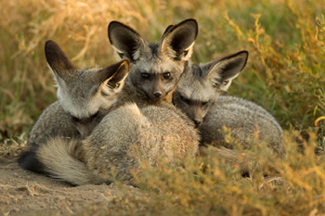 We loaded in the dark and drove southwest into the Ndutu forest, hoping for a sunrise but we couldn’t find a suitable tree and continued on to the lake, where we shot a yellow fireball, a non-sunrise, really, in the clear atmosphere. We continued on to a Bat-eared Fox den with 5 members, and although they were running about when we drove up they quickly adopted a sleeping huddle and the best we could manage where shots when one or more of the adults would periodically wake up and look about momentarily.
We loaded in the dark and drove southwest into the Ndutu forest, hoping for a sunrise but we couldn’t find a suitable tree and continued on to the lake, where we shot a yellow fireball, a non-sunrise, really, in the clear atmosphere. We continued on to a Bat-eared Fox den with 5 members, and although they were running about when we drove up they quickly adopted a sleeping huddle and the best we could manage where shots when one or more of the adults would periodically wake up and look about momentarily.

One of our vehicles had a mother cheetah with fully grown babies, and we headed in that direction, but another mother Cheetah with four 2 month old cubs was spotted first. The shooting was good, and Donna and Ron’s vehicle had the cheetah, twice, approach their vehicle and lie down in the shade. I was out of position most of the time, but we stayed with the cats and eventually got some nice images as the mother approached and the babies ran by.
At the marsh, one of the few standing bodies of water in this very unseasonably dry year attracted a lot of birds. Collared Pratincoles, a brown, nocturnal tern-like bird, were gathered along the shoreline by the hundreds. The most I’ve seen of this bird in the past may have been a group of less than a dozen. Maribu Storks, Black-headed Herons, Sacred Ibis, three-banded plovers, hammerkops, and multiple songbirds all 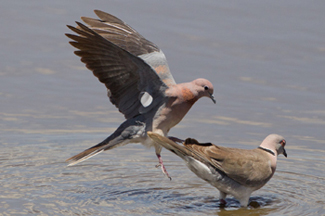 came to feed or drink. I did a series with Mourning Doves and Ring-necked Doves flying in, occasionally landing atop one another before stepping into the shallows for a drink or bath.
came to feed or drink. I did a series with Mourning Doves and Ring-necked Doves flying in, occasionally landing atop one another before stepping into the shallows for a drink or bath.
We finished the morning with a pride of 11 sleeping lions, and a very rare sighting here, a Leopard, that was lying flat beneath an acacia but stood and switched positions once all of our vans arrived. As we drove back to camp for lunch cumulous clouds were building, and to the east verga or rain was falling. Now, at three, distant mountains are obscured by a veil of rain and most of the sky is covered in clouds, although our campground still bakes in the afternoon sun.
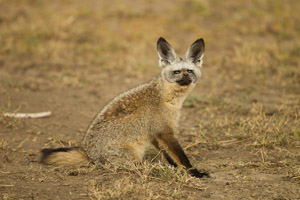 PM. We left at 4, driving directly to the leopard, which had traveled about 25 yards, from the shade of one tree to another, since our departure. About a half dozen vehicles had formed a semi-circle around the sleeping cat, and we joined the line, positioning ourselves where I hoped the leopard would appear once it awoke and arose. It was past 6, well over an hour later, when the cat finally started stretching and yawning and eventually sitting up, and it turned to face all directions at one point. The cat moved off at a slight angle to us, but veered left, walking right next to the vehicle behind us and directly towards our’s, and we managed some facing, approaching images.
PM. We left at 4, driving directly to the leopard, which had traveled about 25 yards, from the shade of one tree to another, since our departure. About a half dozen vehicles had formed a semi-circle around the sleeping cat, and we joined the line, positioning ourselves where I hoped the leopard would appear once it awoke and arose. It was past 6, well over an hour later, when the cat finally started stretching and yawning and eventually sitting up, and it turned to face all directions at one point. The cat moved off at a slight angle to us, but veered left, walking right next to the vehicle behind us and directly towards our’s, and we managed some facing, approaching images.
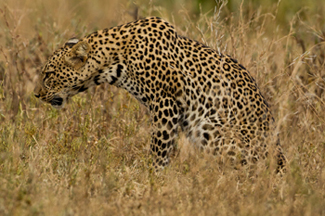 Over the next 30 minutes we followed or got ahead of the cat as it walked and sat and watched, and, at one point, startling a nearby Steinbok that it chased, unsuccessfully. As our time ran out the leopard sat and started roaring, leaning forward (from either a sitting or a lying down position – it did both) as if it were about to spit up a hairball, and then with jutting chin jerks it proceeded to call, giving the distinctive ‘sawing’ deep throated call. I’ve heard this several times but never saw it, and I couldn’t distinguish, in my memory, a male’s call from a female’s. I suspect they do indeed sound similar, and both sexes serve notice. A female’s call will alert a male, and probably signify, by its calling, that she is in heat. A male’s call advertises his territory, and serves as a warning to other male leopards. Should another male respond, either by approaching or by calling, that male is signaling that he acknowledges the other and accepts the challenge, and a fight over territory would ensue. Our female called several times, but it might be hours or days before a wandering territorial male hears the call and responds.
Over the next 30 minutes we followed or got ahead of the cat as it walked and sat and watched, and, at one point, startling a nearby Steinbok that it chased, unsuccessfully. As our time ran out the leopard sat and started roaring, leaning forward (from either a sitting or a lying down position – it did both) as if it were about to spit up a hairball, and then with jutting chin jerks it proceeded to call, giving the distinctive ‘sawing’ deep throated call. I’ve heard this several times but never saw it, and I couldn’t distinguish, in my memory, a male’s call from a female’s. I suspect they do indeed sound similar, and both sexes serve notice. A female’s call will alert a male, and probably signify, by its calling, that she is in heat. A male’s call advertises his territory, and serves as a warning to other male leopards. Should another male respond, either by approaching or by calling, that male is signaling that he acknowledges the other and accepts the challenge, and a fight over territory would ensue. Our female called several times, but it might be hours or days before a wandering territorial male hears the call and responds.
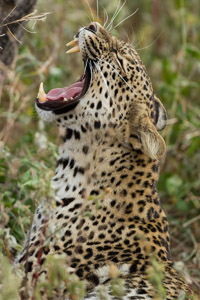
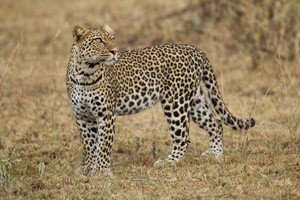
Day 6, Gol Kopjes
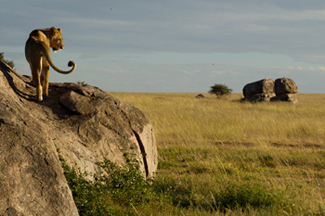
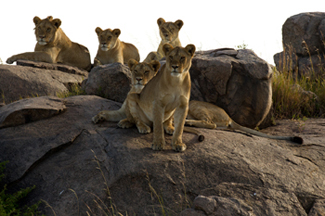
We left in the dark, arriving at the first kopje just as the first color appeared in the eastern sky. Mary’s vehicle stayed there, concentrating on the changing colors of rock and sky, but my vehicle moved on, as I tried to maximize the color and opportunity with as many vantages, angles, and kopjes as possible. It made for hectic shooting, requiring those in my vehicle to shoot and move, but the alternative – staying in one spot and shooting the same scene again and again – was silly, and our work was worth it.
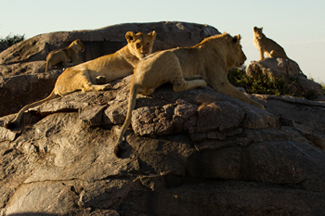
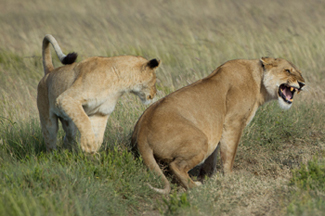
When we first encountered the lions they were perched like wonderful statues on small kopje rocks close to the track. Later, they walked through the grasslands for nearly 2 miles before settling in the shade of a fig tree at another kopje, within a quarter mile of a cheetah with four cubs. When the oldest lioness rejoined her pride she was greeted with curiosity or affection, but she responded quite aggressively, as if she were a stranger.
We stayed with the kopjes as the sun intensified, although the light was still low, until Mary’s vehicle radioed that she had a group of lions perched upon another set of kopjes. We raced to the location, finding 6 lions that, at various times, posed on several different rocks. Their attention was intently focused in the distance, and later a lioness appeared, easily a quarter mile off and probably more like a half. The 6 lions, a lioness and several two year old cubs, hopped off the rock and trotted or ran to join her. We sped ahead, hoping to catch the greeting.
That encounter wasn’t what we expected, as the greeting wasn’t friendly and full of playful jumps and head bumps. Instead, the lioness flattened her butt to ground and snarled, as if she 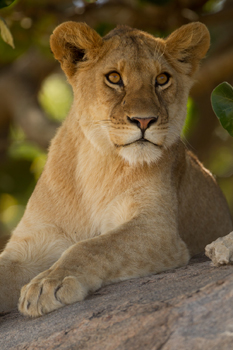 was an intruder. We suspect she was pregnant and bitchy, but as she moved off the other 6 tagged along, and we did several series of the pride walking along, following a vehicle track or a game trail, towards us or away. We suspect that the lioness had walked at least two miles, and the 6 at least one mile since they left the rocks, and they covered the ground at an easy walking pace surprisingly quickly. I’d guess about 5-6 miles per hour. The pride eventually settled beneath a fig tree on the top of a rounded boulder in a kopje where, after a series, we left them as we headed for a 10AM breakfast.
was an intruder. We suspect she was pregnant and bitchy, but as she moved off the other 6 tagged along, and we did several series of the pride walking along, following a vehicle track or a game trail, towards us or away. We suspect that the lioness had walked at least two miles, and the 6 at least one mile since they left the rocks, and they covered the ground at an easy walking pace surprisingly quickly. I’d guess about 5-6 miles per hour. The pride eventually settled beneath a fig tree on the top of a rounded boulder in a kopje where, after a series, we left them as we headed for a 10AM breakfast.
En route Mary spotted a cheetah running, a young male that was being trained by its mother with a gazelle calf she had captured. The cheetah was shy and dropped the prey, which the mother quickly grabbed and dispatched, and the other cub began eating. Not wanting to deprive the shy cheetah of its share, we drove off without photographing.
After breakfast, now 11, we headed back to camp, stopping when Pokea spotted another cheetah in a small kopje. It was at its maternal den, and behind her two 3 week old cubs teetered about. The light was harsh, 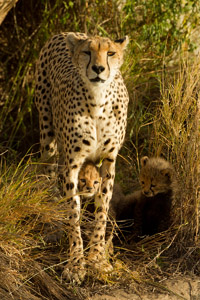 but we shot anyway, and hopefully got some images. With several more days in this area we plan on returning later, hopefully as the cubs are a bit more venturesome and visible.
but we shot anyway, and hopefully got some images. With several more days in this area we plan on returning later, hopefully as the cubs are a bit more venturesome and visible.
PM. Peter came to our tent around 3PM, excited, as he’d just left a huge python and wanted me to see it and perhaps detain it for the group. The snake was just a short distance from camp and when I arrived I could see its huge, 6 inch long head sticking up from the grass. We pulled up adjacent to the track but the snake ducked into cover and crawled into a tangle of dead limbs. I followed, and grabbed a hold of its tail, wondering if it might turn back. It didn’t, but instead simply braced itself and pulled, pulling me forward and the tail out of my grip. The snake was truly huge, about the length of the vehicle or longer, and I’m guessing it was over 15 foot long.
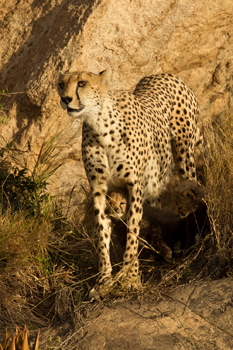
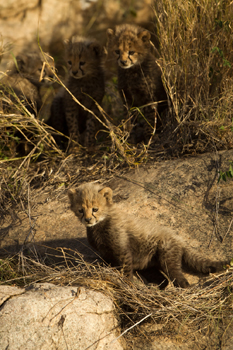


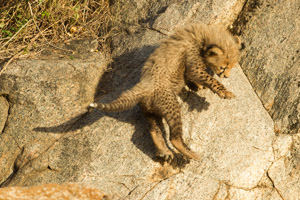
At the den, the mother cheetah eventually rose from her bed of grasses and climbed down from the rocks. To our surprise, the babies stepped to the edge of the den and, after a moment's hesitation, followed. The first, and most adventurous, slid down the slick gneiss and granite rock face, landing unharmed a few feet down.
We headed back to the cheetah den, but the cubs were hidden and the mother was lying beneath a tree, offering no shots. We moved on to the lions, only a quarter mile away, but they were still dead asleep. We headed deeper into the kopjes, but Pokea, who stayed back, reported that the cheetah had moved into the grasses and one of the lionesses nearby had spotted it. Fearing the worse, we drove back, as a lioness would kill a cheetah if it had the chance.
When we arrived back at the den one of the babies was perched on a rock in full view, and for several shots we had great shooting. 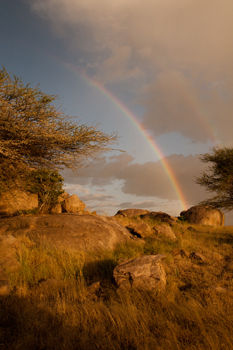 The cub disappeared into the grasses, and we noticed the spots of an adult – the mother had returned when everyone’s attention was directed at the lions. The cubs came out to play, and after a short time the mother got up and left the rocks, resting behind an agave plant. Later she returned, and the cubs resumed their play. Later the mother moved out, and the cubs followed, this time, with two cubs sliding down a slick rock face in order to follow mom. An advancing storm and thunder frightened one of the cubs, who ran at full speed right to and past our vehicle, before disappearing in the high grass. The female, with the three other cubs, followed at a distance, but united later and the entire family moved off, hopefully out of the danger posed by the lions.
The cub disappeared into the grasses, and we noticed the spots of an adult – the mother had returned when everyone’s attention was directed at the lions. The cubs came out to play, and after a short time the mother got up and left the rocks, resting behind an agave plant. Later she returned, and the cubs resumed their play. Later the mother moved out, and the cubs followed, this time, with two cubs sliding down a slick rock face in order to follow mom. An advancing storm and thunder frightened one of the cubs, who ran at full speed right to and past our vehicle, before disappearing in the high grass. The female, with the three other cubs, followed at a distance, but united later and the entire family moved off, hopefully out of the danger posed by the lions.
The storm had produced a double rainbow, and our last shots of the day had us framing the rainbow against the golden rocks of the very late afternoon. With the storm looming, we closed our vehicle hatches and headed home.
Day 7, Simba Kopjes
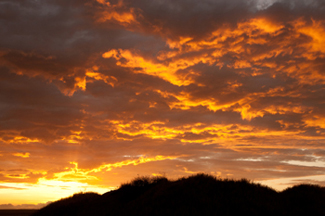 The sky was partly cloudy and, during the night, it had rained. We planned on heading northwest, towards Simba Kopjes, and in anticipation of the tardy gate guards we did not leave until 6. Nonetheless, no one was manning the opened gate and our vehicles, and two film vehicles (possibly paying as much as $1,000/day in permit fees) waited for someone to wake up or show up. At 6:30 a young man with a bucket walked by, and after some words we passed through, without any paperwork or authorization other than the bucket man’s verbal OK, something we probably didn’t need.
The sky was partly cloudy and, during the night, it had rained. We planned on heading northwest, towards Simba Kopjes, and in anticipation of the tardy gate guards we did not leave until 6. Nonetheless, no one was manning the opened gate and our vehicles, and two film vehicles (possibly paying as much as $1,000/day in permit fees) waited for someone to wake up or show up. At 6:30 a young man with a bucket walked by, and after some words we passed through, without any paperwork or authorization other than the bucket man’s verbal OK, something we probably didn’t need.
We headed north with a spectacular dawn sky developing, with nothing to set in front. The Simba kopjes were too far away and the muram pit, where we stopped, did not have a lion or cheetah as we had hoped, so Steve and I just used a grassy hill for our frame. Very disappointing.
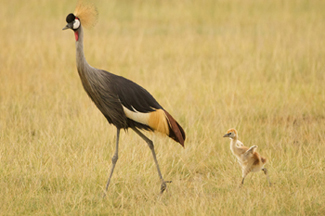 When we reached the kopjes the sliver of gold light was fading into clouds, so an otherwise beautiful scene of golden rocks set against a black sky was missed by minutes. The kopjes were lion-free, and in the now dark, flat light we proceeded up a stream bed looking for game.
When we reached the kopjes the sliver of gold light was fading into clouds, so an otherwise beautiful scene of golden rocks set against a black sky was missed by minutes. The kopjes were lion-free, and in the now dark, flat light we proceeded up a stream bed looking for game.
It was a slow morning, with two baby Crowned Cranes and their parents being my highlight, and another vehicle a Shrike feeding at a butchering-station where it had impaled some prey, a frog we suspect. We did see 16 lions and a cheetah, but most were too far away. The lions were a new honeymoon couple and mated twice in a half hour, but she was benign, and barely a growl came from either after each mating.
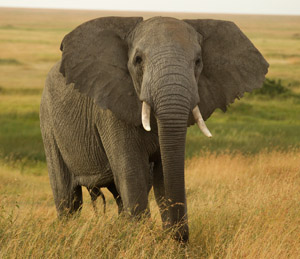

A bull elephant at Simba Kopjes, and a lone Hartebeest on the Serengeti, framed by an advancing storm.
We were back to the camp by noon, giving us several hours to rest or edit, while to our south, this afternoon’s destination, rain shrouds the Ndutu forest to invisibility. It may be interesting there, later.
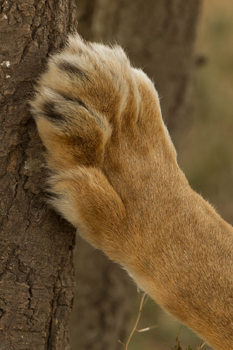 PM. After a short stop at the interpretive center at Naabi Hill, where a panel explains the formation of kopjes, we headed southwest towards the Ndutu forest. Along the forest edge we found 8 lions, all well fed, including one very good male that, despite its satiated state, was awake.
PM. After a short stop at the interpretive center at Naabi Hill, where a panel explains the formation of kopjes, we headed southwest towards the Ndutu forest. Along the forest edge we found 8 lions, all well fed, including one very good male that, despite its satiated state, was awake.
Later we found another Cheetah female, but we left it before it got up, scratched, and walked to the road where Mary’s vehicle still waited. We had moved on, discovering 7 Bat-eared Foxes at a den. We parked nearby and waited, and in both sunlight and in nice overcast light we had a wonderful show, with the full-size young coming out of the den and greeting their parents, mutually grooming, scratching, and, at the end, a short run about before they headed out onto the plains.
On the return to camp we had very close encounters with three Golden Jackals. One was drinking along a roadside pool and was quite tame, and I, stupidly, had already put down my beanbags and packed up my gear, consequently missing most of that shoot. Fortunately another pair were just a short distance further down the road and although we parked almost too close for my 500mm, we all managed good shots.
As we returned to Naabi Hill a black, tortured  cloud hung overhead, and soon after we were in our tents a hard rain blew in. I had had my camera set up on a distant thunderhead for lightning – and managed some shots, but the storm was blowing and I had to quit. Later, I repositioned and tried again, but most of the storm was far to the west and although the sky brightened, I did not capture another bolt. By the end of dinner the storm was past, and we walked back to the tents under a bright, clear, starry night sky.
cloud hung overhead, and soon after we were in our tents a hard rain blew in. I had had my camera set up on a distant thunderhead for lightning – and managed some shots, but the storm was blowing and I had to quit. Later, I repositioned and tried again, but most of the storm was far to the west and although the sky brightened, I did not capture another bolt. By the end of dinner the storm was past, and we walked back to the tents under a bright, clear, starry night sky.
Day 8, Moru Kopjes and Seronera
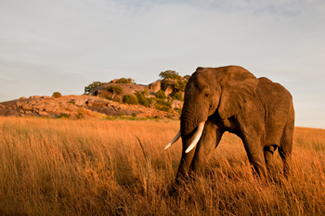
The Naabi Hill gate was open this morning, on time, and we headed north, hoping to arrive at Simba Kopjes before sunrise. We did, but the sky was a bit muted, with a very thin veil of cloud cover, enough to soften the light once it struck a kopje and thus reducing its effect. Yesterday morning the cloud cover, though heavy, produced a spectacular sunrise … not today.
We did manage a bull elephant against the largest of the Simba Kopjes, which walked quite close to us, giving us a nice foreground for the kopje. We continued towards Moru, stopping numerous times for birds, and going so slow that the vehicles ahead of us saw several subjects we completely missed – a male lion drinking, a lioness tight-roping on a long tree limb, etc.
Breakfast wasn’t until 10, in an open field, and from there we headed, slowly, towards the Maasai paintings where most everyone tried an HDR from inside the cave, looking out on the Serengeti. Later, we spent a good deal of time at the Gong Rock Kopje, where we decided to wait until Seronera for lunch – some time after 2. We never made it.
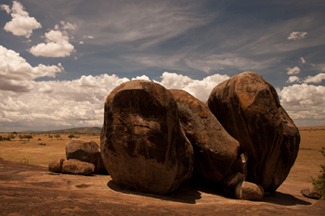
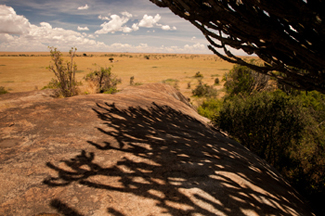
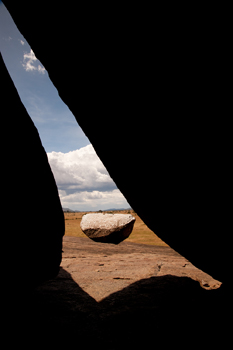
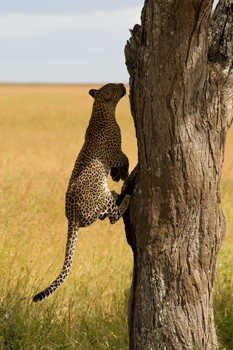
One of our favorite kopjes is the gong rocks in Moru kopjes, where it is common and fairly safe to climb up and overlook the Serengeti. The boat-like rock, framed by the silhouettes of other boulders, is indented from the blows of uncounted and countless rocks, creating the 'gong' that brought the Maasai atop these kopjes. In the afternoon, although my vehicle was out of position, I did manage a shot as the leopard leaped into the roadside tree where our other two vehicles did quite well.
Our two other vehicles had stopped for zebras but my vehicle had moved on, and fortunately by doing so we encountered a Leopard at Seronera that walked through the grass almost directly to us, then crossed the road, moved through the grasses, crossed the road again, and started following a lugga. I correctly read, or guessed, where the leopard would go and we positioned ourselves for several shooting opportunities, before we lost the leopard. I suspected she might go to a tree ahead of us and we moved there, but stopped just short of the tree. The leopard appeared out of the grasses, going right for the tree, but vehicles that had pulled up now blocked our moving closer. We did manage a sequence as the leopard leaped up the tree trunk, but from that point we were blocked. Fortunately, Tom and Bob’s vehicle had moved up close, and they were directly across and in front of the leopard as she posed beautifully on the tree trunk. Later she climbed higher and we managed some shots, but the crowd of vehicles was almost over-powering. We had to shift positions several times in order for the guides to avoid a riot, and in doing so we missed a few chances. Eventually, with the leopard facing away from us, we gave up, and moved off for a 4:30PM lunch – perhaps a new record!
Jokingly, that was my highlight, as Mary had stayed in because she was sick, and now I was in charge of the domestic logistics, which, I guess, I pretty much ignored as a shooting opportunity – the leopard – arose. We headed towards camp by 5, nearly 21 miles away, although we stopped for more birds en route.
To the south, near Ndutu, the sky was black with rain clouds nearly the entire afternoon, and as we neared Naabi a huge dust and rain storm loomed to the south. We made it into camp without rain, although lightning, and a storm hid all of the Ndutu forest and much of the plains from view. For two afternoons this area has had rain, and now it is just a question of when will the gnus migrate in, and will we still be in this area when they do so?
Day 9, Gol Kopjes
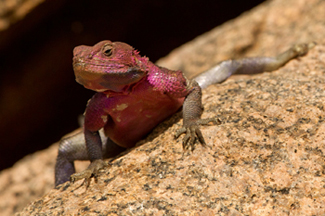 The eastern horizon had a low bank of clouds, obscuring the first light of dawn, and with the rain yesterday the air was cool and heavy, and, as the sun broke free of the clouds, the light was the same muddy dullness of yesterday. We had raced deep into the kopjes for some new rock subjects, but we were frustrated in not finding a suitable acacia or rock outcrop, and with muddy light, the rocks themselves were poorly defined.
The eastern horizon had a low bank of clouds, obscuring the first light of dawn, and with the rain yesterday the air was cool and heavy, and, as the sun broke free of the clouds, the light was the same muddy dullness of yesterday. We had raced deep into the kopjes for some new rock subjects, but we were frustrated in not finding a suitable acacia or rock outcrop, and with muddy light, the rocks themselves were poorly defined.
We did manage a few compositions, with some huge tabular boulders that resembled tombstones, and a foreground rock where Agama Lizards, fresh from sleep, basked in the early light. On first emerging, agamas are blackish in color, and sprawled out on a rock they resemble Galapagos marine iguanas. Black absorbs heat and light, and as the lizards warm up their colors begin to intensify, where, with the male, the color transitions to a pinking orange head and shoulders and a maroon blue body.

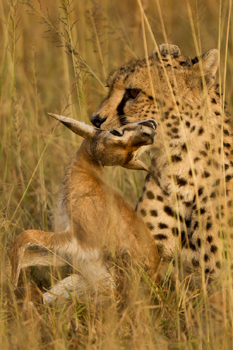
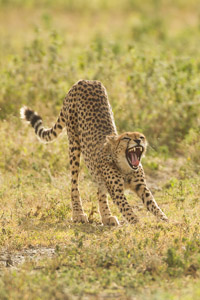
Quite unexpectedly, the mother cheetah and cub had a hunting opportunity before them. A baby Thompson's gazelle, possibly an orphan, walked across the grasslands, directly to the cheetah, stopping when it was less than six feet away. At that distance the cheetah charged, but the gazelle was still fast enough to elude the mother cheetah for a few hundred yards. Ultimately, the cheetah prevailed.
Mary and Pokea spotted a mother cheetah and cub, and we drove over for some portraits in the high grass in the low light. While we photographed, a baby Thompson’s Gazelle materialized in the grasses behind my vehicle and began walking towards us. We suspect that the baby had seen the cheetah’s outline, and mistook that shape for a gazelle and this misidentification was costly. 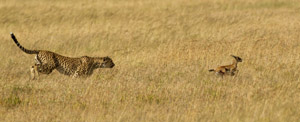 The fawn was about fifty yards out when the mother cheetah saw it, and she stalked forward a few paces and lay flat. The fawn kept coming, and approached to within four feet of the cheetah.
The fawn was about fifty yards out when the mother cheetah saw it, and she stalked forward a few paces and lay flat. The fawn kept coming, and approached to within four feet of the cheetah.
At that point the cheetah charged and, like lightning, the baby spun and ran, with the mother in close pursuit. The pair ran almost directly at our vehicle, and I, stupidly, had set my motor drive on continuous low because I was firing too many shots of the same boring sunrise! My camera clunked along, but the AF did keep up and I did manage a few nice shots. The cheetah and fawn ran behind and around our vehicle, where she finally knocked it down after a 200 yard chase. Her 9 month old cub was right behind, and the mother released the fawn for the cub to chase and learn to hunt. However, the cub was inept, and the fawn sped away, prompting the female to give chase, and, upon catching it, delivering a killing stranglehold. We left as they began to feed.
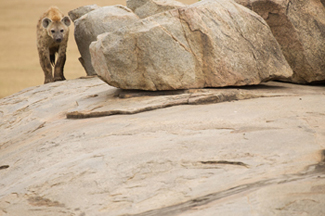 Other morning highlights included hyenas,Thompson’s gazelles, and a Golden Jackal on the kopjes, and while we had breakfast we watched a golden jackal in pursuit of a female gazelle who just barely kept ahead of the racing jackal. I suspect a fawn was hidden nearby and the female was purposefully slowing to draw the predator further and further away from the fawn. Eventually, a good half mile further, the jackal gave up, and continued in its direction.
Other morning highlights included hyenas,Thompson’s gazelles, and a Golden Jackal on the kopjes, and while we had breakfast we watched a golden jackal in pursuit of a female gazelle who just barely kept ahead of the racing jackal. I suspect a fawn was hidden nearby and the female was purposefully slowing to draw the predator further and further away from the fawn. Eventually, a good half mile further, the jackal gave up, and continued in its direction.
We headed back to the original ‘den site’ of the cheetah where, earlier in the day, no cats were present and we discovered the den was not a cave or ledge at all, simply a depression in the high grasses forming a little hollow. Three hours later, the cheetah mother and one cub were back on the same rocks, and Mary worried that the other three cubs were killed. In fact, 90% of cheetah cubs die in their first year, and when we last saw the cheetahs a pride of lions was just a half mile away. We suspected they had chased and killed the other cubs.
Soon, however, the other three cubs appeared, and after a short walk through the grasses the  mother settled into a hollow and began to nurse, providing some distant and limited shots.
mother settled into a hollow and began to nurse, providing some distant and limited shots.
The cheetah chase/kill was extraordinary, but had we visited Ndutu today instead we may have witnessed a truly unusual event. A pride of lions (the guides didn’t ask how many!) killed a giraffe in the Ndutu forest, but we had no further details. I’ve only seen one giraffe definitely killed by lions, and another two that may have been killed, or died naturally, in 25 years! We’ve never seen a hunt, but we didn’t stress much, since we did not know if the kill occurred in the open or in very thick woods. Still, it is good to know that the Ndutu pride will kill giraffes, and may do so again on a future trip.

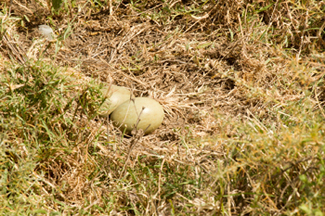
This was the first time I've seen a kori bustard on the nest and, I later learned, only one guide I've had in Kenya or Tanzania has seen one. The photos are not spectacular because we left the area almost immediately, and the bird returned back to the nest as soon as we drove off.
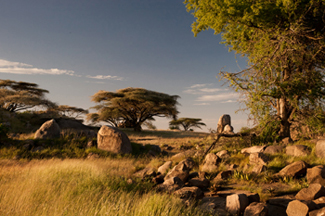 PM. We headed back to the cheetah kopje, hoping to find the mother and four cubs. En route, as we sped along I spotted the head of a Kori Bustard just above the grasses. Earlier we’d seen a female and a one-third grown chick, a perfect miniature of the adult, and I suspected this one was on a nest. We drove up, and she was, sitting quietly and apparently unconcerned. When we restarted the engine she jumped from the nest – a flattened, hollow amidst the grasses – and we saw two emerald green eggs. I’d seen what I suspected was a kori egg one other time, in the Mara, but this was the first nest I’ve seen, and I’d never had a driver/guide who had seen one either, so I was thrilled. The kori didn’t go far, and we immediately drove off, and as we left I could see the bird turning back to return to her eggs. Koris encounter vehicles regularly, so I’m sure it was the motor that spooked her, and with us gone the nest was safe.
PM. We headed back to the cheetah kopje, hoping to find the mother and four cubs. En route, as we sped along I spotted the head of a Kori Bustard just above the grasses. Earlier we’d seen a female and a one-third grown chick, a perfect miniature of the adult, and I suspected this one was on a nest. We drove up, and she was, sitting quietly and apparently unconcerned. When we restarted the engine she jumped from the nest – a flattened, hollow amidst the grasses – and we saw two emerald green eggs. I’d seen what I suspected was a kori egg one other time, in the Mara, but this was the first nest I’ve seen, and I’d never had a driver/guide who had seen one either, so I was thrilled. The kori didn’t go far, and we immediately drove off, and as we left I could see the bird turning back to return to her eggs. Koris encounter vehicles regularly, so I’m sure it was the motor that spooked her, and with us gone the nest was safe.
 A few minutes later we encountered an old Leopard Tortoise on the track, which, as usual, turned away from us when we stopped. Mary’s vehicle came nest, and the tortoise turned away, this time facing us. It proceeded to walk towards us, giving us some nice shots.
A few minutes later we encountered an old Leopard Tortoise on the track, which, as usual, turned away from us when we stopped. Mary’s vehicle came nest, and the tortoise turned away, this time facing us. It proceeded to walk towards us, giving us some nice shots.
To the east a huge storm advanced, and we drove into the kopjes first looking for the cheetah mother, and then on for scenics. The cheetah family had disappeared, although we scouted every kopje, and I suspect she had moved to one of the higher ledges or the top of one of the large, flat kopjes. Our next hour was spent chasing the light, attempting to get a scenic kopje against the black 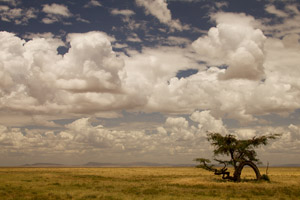 storm clouds, and at the end, just as the light began to fail, we had some good luck.
storm clouds, and at the end, just as the light began to fail, we had some good luck.
Starting our drive back our guide spotted the mother cheetah and large cubs we’d seen a few days earlier. A large herd of Thompson’s Gazelles were moving towards her and she began a stalk. At thirty yards she charged, and the herd spun back the way they came. The cheetah singled out a female, gained ground, reached out a paw to trip her, missed, lost ground, and quickly regained it to finally trip up the gazelle and pounce upon it. She’d left her cubs far behind, and by the time they joined her she had killed the gazelle. For us, it was much too far for any photos, and it was a real joy to simply be in a position to watch a 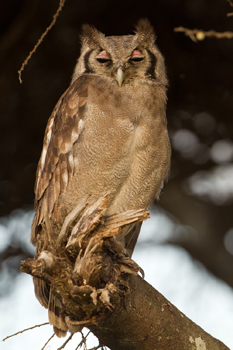 hunt take place without any of the stress associated with photographing. It was truly a memorable view.
hunt take place without any of the stress associated with photographing. It was truly a memorable view.
On the way back we spotted another cheetah – just a head above the grasses, but when we drove closer for a better look she literally vanished in the high grasses. We suspect she simply flopped on her side to lay down, and did so in some taller vegetation where she was completely hidden from view. Mary radioed that the Verreaux’s Eagle Owl was out in the open, and when we arrived the adult was in the open in good light, giving us the best shot of this owl I’ve ever had in Tanzania.
Another radio call – a Caracal had been spotted. The cat was near the barn owl kopje, and when we arrived we pulled up and spooked a second cat lying hidden right beside the road. The first caracal disappeared in a burrow and two vehicles moved out to find the second cat, which ended up cooperating for some nice shots as it jogged off into the grasses. All of this in Gol, our favorite location in the Serengeti.
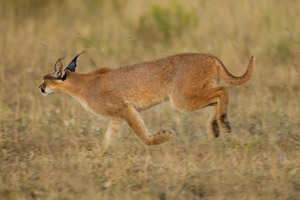
One of the two Caracals we saw on our last afternoon in the Gol Kopjes. Caracals are sometimes referred to as lynxes, for their resemblence, mainly via the ears. They are mostly nocturnal and rarely seen, but we've seen pairs on our last three safaris in Tanzania.
Day 10, Ndutu area
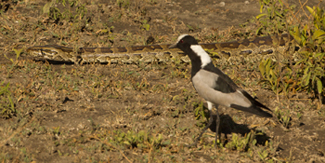 The storms of last night cleared and we headed south towards the Ndutu forest under open, chilly skies. Abdim’s and European White Storks sailed overhead as we neared the forest, the birds leaving their night time roosts for their day’s feeding in the plains. We did a sunrise near the lake, in a fresh pool that, just days earlier, was a dry, dusty lake bed.
The storms of last night cleared and we headed south towards the Ndutu forest under open, chilly skies. Abdim’s and European White Storks sailed overhead as we neared the forest, the birds leaving their night time roosts for their day’s feeding in the plains. We did a sunrise near the lake, in a fresh pool that, just days earlier, was a dry, dusty lake bed.
The first part of the morning was rather uneventful, with Mary’s vehicle spending some time with 9 lions at the marsh and my vehicle working some birds. We found a group of 7 Bat-eared Foxes that 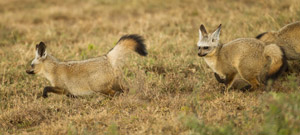 were all strangely alert, their posture erect and their attention aimed one-way. I figured they had spotted some predator, perhaps a leopard in the distance. Two vehicles from other companies were parked not too far away and behind them we could see blacksmith plover’s flying about, and I wondered if they were harassing a python. We drove over to check.
were all strangely alert, their posture erect and their attention aimed one-way. I figured they had spotted some predator, perhaps a leopard in the distance. Two vehicles from other companies were parked not too far away and behind them we could see blacksmith plover’s flying about, and I wondered if they were harassing a python. We drove over to check.
An eight-foot long Rock Python was indeed crossing the lakebed, its sinuous track leading across the mudflats to a den hole of possibly another fox. The plovers were circling the snake, keeping track of it until it finally settled into some high grasses beneath a tree. Then, out of sight, out of the bird’s minds, and they wandered off. We got out of the vehicle for a closer look, and the snake stayed coiled, and was incredibly difficult to see, even though the vegetation was barely 12 inches high, and not too thick. We called in the other vehicles.
Once they arrived, Mary and I grabbed the snake, and between us we brought it out for the group to see. I was surprised at how easy it was; I expected a lightning-fast strike, and greater strength. Instead, it was quite easy to hold the python and soon most people crowded in to have 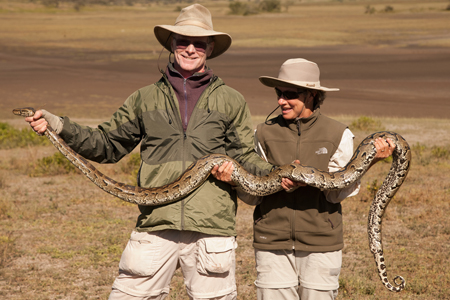
While we didn't measure this python, we know it was at least 8 feet long.
their picture with the snake. Afterwards, I set it down and it slithered back to the tree where, just seconds later, it had resumed its coiled position, much as how we found it. Nonetheless, for me, handling a wild rock python for the first time was a real thrill, and probably my trip highlight, especially since my backup man was Mary, securing the back end of the snake.
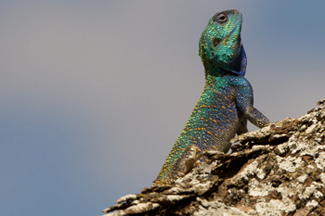
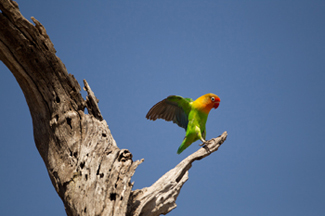
Tree Agamas are one of the more colorful species, with a turquiose head and neck. Normally an insect eater, in the rainy season I've seen this lizard eat the tissue-paper flower that dots the low grass plains. Fischer's Lovebirds are usually extremely wary, but several birds investigating a nest tree returned continually, provided we stayed quiet and still.
After breakfast we started towards Mtiti Hills, stopping en route for the 3 cheetah brothers, 9 lions that appeared to be hunting gnus, but gave up, and a lioness with 3 cubs. We had some great luck with a Tree Agama, other birds, and a Steinbok right before a 2:30PM lunch. Afterwards, we headed back to both sets of lions, and for a short time the 9 lions beneath their shade tree awoke and put on a little show, yawning repeatedly.
We had planned to be in by 6PM to enjoy our last evening at this camp at a campfire, but we didn’t leave for home until nearly 6, stopping for more bat-eared foxes and a good tawny eagle. 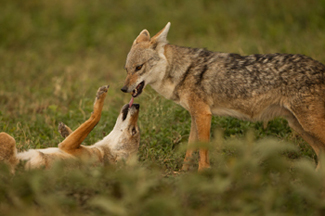 On the main road from Ndutu we had a very cooperative Golden Jackal that we kept pace with, and who eventually met a nearly full-grown young, precipitating a great session of jackal interaction, with submissive behavior, mutual grooming, etc. The best golden jackals I’ve ever shot.
On the main road from Ndutu we had a very cooperative Golden Jackal that we kept pace with, and who eventually met a nearly full-grown young, precipitating a great session of jackal interaction, with submissive behavior, mutual grooming, etc. The best golden jackals I’ve ever shot.
Just after we arrived in camp a tremendous thunderstorm enveloped us, creating something of a farce for Mary and I as we tried to close tent flaps, retrieve my camera (set for lightning), and deal with a shower head that fell off while we showered. The storm abated right before dinner, but we missed the campfire. The evening finished with a going-away party hosted by the camp, with cake, a song, and champagne, and a yellow-winged bat flying about, catching moths before me. For once, I did not set up a camera for lightning, and tonight’s display was simply spectacular. Irony, and a near perfect day.
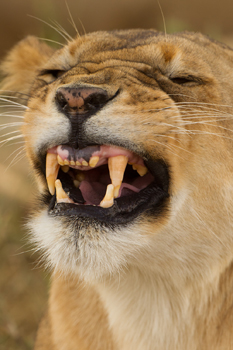

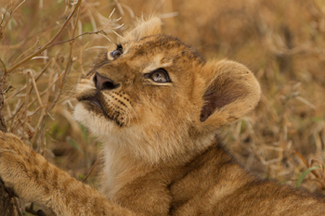
Our last afternoon in the Ndutu area was productive, with a lioness that yawned repeatedly. At the end of a yawn the motion looks like a mean snarl. A very cooperative Tawny Eagle perched on a sandy stretch of the once dusty river bed in Ndutu, and a small cub looks upward at a tempting tree limb to climb.
Day 11, Naabi to Sametu Camp
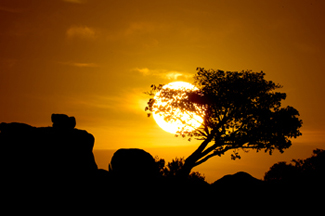 We packed and headed north to our new camp, stopping at Simba Kopjes for a sunrise before continuing on the same route we took to Moru. The morning was fairly slow, although Don may have achieved his goal of catching a lilac-breasted roller in flight, after nearly a half hour wait. The bird just didn’t move! Other vehicles had a nice black-shouldered kite, and we had a funny encounter with a very animated baby elephant at a waterhole, although that didn’t last long.
We packed and headed north to our new camp, stopping at Simba Kopjes for a sunrise before continuing on the same route we took to Moru. The morning was fairly slow, although Don may have achieved his goal of catching a lilac-breasted roller in flight, after nearly a half hour wait. The bird just didn’t move! Other vehicles had a nice black-shouldered kite, and we had a funny encounter with a very animated baby elephant at a waterhole, although that didn’t last long.
The most unusual highlight occurred at a series of pools along the tire tracks. A Hyena was sitting in a pool and after a few minutes it rolled onto its back, or dipped its head, giving itself a  complete bath. Another, smaller hyena trotted in from the grasses, and immediately dropped into another puddle further up the road. This puddle had little water, mostly mud, and the hyena immediately flopped down and rolled repeatedly, coating itself almost completely in black mud, except for a brown strip of fur running down its back. When it left the water it was fairly comical, a dripping black bear-like animal, and when it approached the other hyena it was greeted by growls, then a chase that elicited the typical hyena laughing giggle. Later, two other hyenas came in, but their soaking was rather conventional and boring, and they also growled at the muddy, black hyena when it approached.
complete bath. Another, smaller hyena trotted in from the grasses, and immediately dropped into another puddle further up the road. This puddle had little water, mostly mud, and the hyena immediately flopped down and rolled repeatedly, coating itself almost completely in black mud, except for a brown strip of fur running down its back. When it left the water it was fairly comical, a dripping black bear-like animal, and when it approached the other hyena it was greeted by growls, then a chase that elicited the typical hyena laughing giggle. Later, two other hyenas came in, but their soaking was rather conventional and boring, and they also growled at the muddy, black hyena when it approached.
The drive through Seronera produced one distant tree-climbing lioness, perched uncomfortably in a tree, but otherwise the grasslands were almost bare. I could appreciate the expanse, and the emptiness, and the difficulty of surviving here as a predator when the herds are absent. Starvation must be the norm.
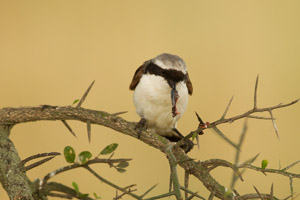
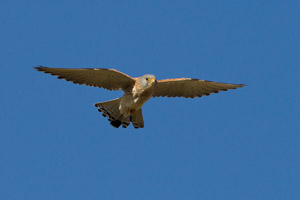
A gray-backed fiscal shrike, one of the 'butcher birds' for its habit of impaling prey upon thorns, and from this position the bird tears apart its prey. Shrikes are actually songbirds, not birds of prey, and are closely related to thrushes like the robin, and not at all related to a similar sized bird, the Lesser Kestrel, right.
Our new camp at Sametu is billed as a permanent luxury tented camp, and that is an understatement. It is the fanciest, nicest camp I’ve ever been in in all of East Africa, and certainly rivals most of the places I’ve been to in Botswana or Zimbabwe. The bed is huge, the sink built in as if from a house, I’m typing at a nice accountant-style desk, while Mary works on her computer on a thick two-person sofa, and the toilet is a water-flush style, unlike the chemical toilet at our last camp. The bar/greeting area is spacious with great chairs and sofas, and the dining area is great. Everyones’ 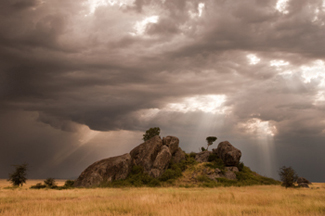 comments – only two nights!
comments – only two nights!
As our next game drive approaches we are surrounded by storms, with thunder rolling across the grasslands and a cool breeze rolling through the red oat and buffalo grass. Hopefully, we’ll have a great lightning show this evening.
PM. We headed to Masai Kopjes in a light rain, which stopped shortly after the game drive started. Game was scarce, and we worked a double rainbow and God beams over kopjes. Otherwise, a rather slow afternoon.
Day 12, Seronera Area
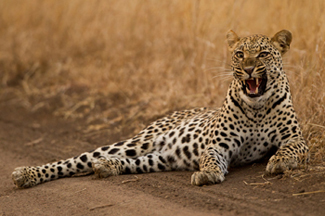
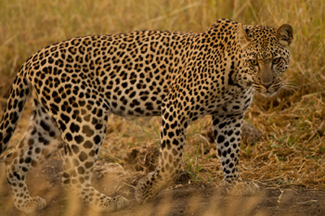
For the first time on this trip, we started our game drive in a light drizzle, with overcast skies that boded a dull, unproductive day. We passed on doing kopjes in the early morning light, as we had planned, and instead headed directly to Seronera where we hoped to beat the crowds and perhaps have some luck with leopard.
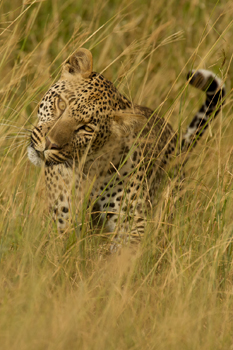 We succeeded on both counts. We had just driven into the ‘16’ area of Seronera when we encountered a leopard lying relaxed on the shoulder of the road. Another leopard moved through the tall grasses nearby. Not too much later ‘our’ leopard got up and disappeared into the grasses, but we could follow its progress by an off-road permitted photography vehicle that kept pace, and was an eye-sore for us. The leopards headed to the long lugga that marks this area of Seronera, and we drove to the other side. From our fairly distant views we could see the cats moving and playing in the grasses, and eventually both climbed a sausage tree where they ran and jumped about the branches, sometimes playing and grabbing at the sausage fruit. We were shooting against the light but the shooting was still better than I’d expect, but more importantly, we were treated to wonderful views of the playing cats.
We succeeded on both counts. We had just driven into the ‘16’ area of Seronera when we encountered a leopard lying relaxed on the shoulder of the road. Another leopard moved through the tall grasses nearby. Not too much later ‘our’ leopard got up and disappeared into the grasses, but we could follow its progress by an off-road permitted photography vehicle that kept pace, and was an eye-sore for us. The leopards headed to the long lugga that marks this area of Seronera, and we drove to the other side. From our fairly distant views we could see the cats moving and playing in the grasses, and eventually both climbed a sausage tree where they ran and jumped about the branches, sometimes playing and grabbing at the sausage fruit. We were shooting against the light but the shooting was still better than I’d expect, but more importantly, we were treated to wonderful views of the playing cats.
One eventually climbed down the tree and our guide suspected it might climb a distant tree close to the road, on the opposite side of the  lugga. We said, let’s go for it, and we sped off, taking a mile long route and eventually arriving at the tree – and the leopard was already there! The view was perfect, the light great, and we were the first vehicles in position. Later the cat climbed back down and moved through the grasses, against the light and off-track, where it eventually climbed a distant tree.
lugga. We said, let’s go for it, and we sped off, taking a mile long route and eventually arriving at the tree – and the leopard was already there! The view was perfect, the light great, and we were the first vehicles in position. Later the cat climbed back down and moved through the grasses, against the light and off-track, where it eventually climbed a distant tree.
Soon the other leopard, its male brother (we’d seen these cats in this area last year, as kittens) climbed down its tree and followed the route of the other. It reached the same tree, where we sat waiting, and paused for nice portraits, but did not climb. Instead, it walked directly to our vehicle before moving on, joining its brother in the tall grasses.
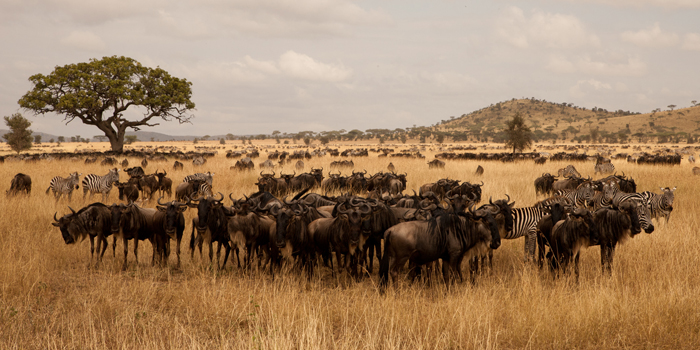
Rounding a hill we saw before us the gray-black wall of a tide of wildebeest, the advancing wall of a herd thousands strong. The Serengeti, so empty for so long, now showed its promise, as the herds were back, and in such a thrilling first sight.
We headed for breakfast and, rounding a rise, we came upon the forerunners of the wildebeest migration. Thousands of animals stretched before us in a dense herd, and we spent the next hour before breakfast, and again after, working the herd, shooting gnus running past, mixed herds of zebra and gnus, and general herd shots. We positioned ourselves at the front, and it was almost as if we were photographing a mudflow or stream or tide, as the animals moved in this dark gray-black mass through the yellow grasses before us. Our last morning, and finally, after ten days, we had the migration!
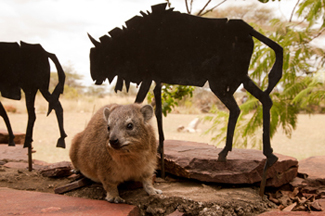 We visited Seronera and the interpretive center next, photographing hyrax and birds while the guides gassed up their vehicles. We did not arrive back to camp until 2:30, when we had lunch, and distributed our tips and shared trip highlights with the group and guides.
We visited Seronera and the interpretive center next, photographing hyrax and birds while the guides gassed up their vehicles. We did not arrive back to camp until 2:30, when we had lunch, and distributed our tips and shared trip highlights with the group and guides.
Mary and I, and Don, Bob, and Natalia, sat out the afternoon game drive, while Tom, Steve, Ron and Donna did a last drive in surprisingly good afternoon light, with their highlight being the rainbows over the kopjes. We had sent one vehicle on ahead, to overnight at Naabi Hill at another camp with our luggage and camera gear, leaving us with just two vehicles, and making ‘sitting out’ almost a necessity. For Mary and I it was simply a nice time to relax and enjoy the view, our tent, and Africa in the quiet of a nearly deserted camp on our last night on safari in East Africa until the fall.
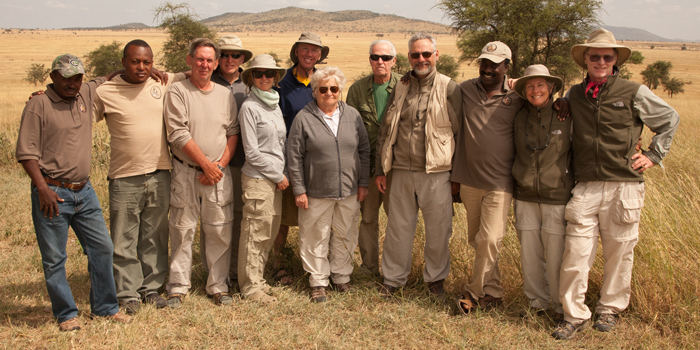 Our group: Pokea, Engleburt, Bob, Ron, Donna, Steve, Natalia, Don, Tom, Petro,
Our group: Pokea, Engleburt, Bob, Ron, Donna, Steve, Natalia, Don, Tom, Petro,
and on the far right, Mary Ann and Joe.
Day 13, to Arusha
Hyenas called during the night but I was too tired, and too lazy, to activate the tape recorder I had waiting by our bedside. Dawn broke clear, with a golden brilliant sun, but we unzipped the flaps of our tent minutes too late.
After breakfast we headed to the Seronera airport, passing through scattered herds of gnus and zebras, and two young male lions lying along the road, two and a half year olds that we suspect were cast-outs from a pride and were now nomads. Our flight, oddly enough, was on time and with great weather we flew over the Serengeti towards Arusha.
In contrast to our recent flight out of the Masai Mara, where within minutes we’re out of the Mara and into Masai country, our flight from Seronera seemed to go on for hours as we flew across the Serengeti. Actually the flight was only fifty minutes long, but for the longest time it seemed as if we were flying first over unfamiliar grasslands, then directly over the Gol Kopjes where we recognized the rocks where we had our lion prides, the mother cheetah and cubs, and our breakfast spots. The transition from the Serengeti to the Ngorongoro Conservation Area was seamless, just one continuous stretch of wild land, until we reached the snaking corridor of  the Oldupai Gorge. In the distant we could see the dusty shores of Lake Ndutu, and below us the visitor center of the Gorge. Soon we were up into the Ngorongoro highlands, where scattered Maasai manyattas dotted the hillsides, and then we were over the Crater itself. Although only 13 miles across from rim to rim, the cross over seemed to take a long time, as we continued over the thickly forested slopes of the eastern rim, leading north and continuing south to Lake Manyatta. Seeing the forest from the air it was easy to see that this was still prime elephant habitat, accounting for the elephants we often see along the rim.
the Oldupai Gorge. In the distant we could see the dusty shores of Lake Ndutu, and below us the visitor center of the Gorge. Soon we were up into the Ngorongoro highlands, where scattered Maasai manyattas dotted the hillsides, and then we were over the Crater itself. Although only 13 miles across from rim to rim, the cross over seemed to take a long time, as we continued over the thickly forested slopes of the eastern rim, leading north and continuing south to Lake Manyatta. Seeing the forest from the air it was easy to see that this was still prime elephant habitat, accounting for the elephants we often see along the rim.
As we neared Arusha forest gave way to farm land, a patchwork/quiltwork of farm fields, and as we continued east, traustnsitioning to dry scrubland. Near Arusha the air was obscured by a haze of dust, a product of the drought hitting this area.
In the afternoon I met with the owners of the safari company we use, and I was able to give an extremely favorable report on the trip, the accommodations, and the driver/guides. We plan on returning again next year.
We can’t wait to return.
Tanzania 2012 February
Photo Safari
Trip Report

Read our Complete Trip Journals,
of our 2011 Trips
2011 Trip Report Summary
Safari One
Safari Two
Read our Brochure for 2012

Ever since I was in high school and read The Tree Where Man Was Born, written by Peter Mathiassen with photos by Eliot Porter, I've been enchanted by kopjes, and the Gol Kopjes in the Serengeti are perhaps the best of several scattered throughout the park. Kopjes are literally islands in a sea of grass, a separate ecosystem due to the soil, rocks, and water collection, and are favorite haunts for cheetahs, lions, and other wildlife.
Our only Serengeti Trip this year followed our special Kenya Photo Safari for predators, where we had spent ten days in the predator-rich Masai Mara. Photographing in the Serengeti is usually harder and a bit less productive on an hour-to-hour basis compared to Kenya, but the experience is different - wild, less crowded, and with each wildlife encounter a new, special and rewarding tree. For whatever reason Mary and I enjoyed this trip as much, or more, than we had any other Tanzania trip. It was spectacular.
While the following account is my day-to-day journal, as I write this foreword several memories and visuals come to mind. Hundreds of Abdim’s and European White Storks winging their way overhead at dawn, their colors a subtle suggestion in the early predawn light. A visual tsunami of herbivores, a tidal wave of gnus and zebras sweeping across the yellow sea of grass, the beginning of the great migration as a united front miles long and a half mile wide. Cheetah families, less than two months old, at dens, seeking shade beneath our vehicles, capturing prey. While not a shooting opportunity, one of my most enjoyable moments was simply watching a cheetah stalk, chase, and catch a Thompson’s gazelle out of a huge herd. As photographers, these observable moments are too few, but precious, as there was no distractions in trying to get the shot. Leopards – the best we’ve ever had in the Serengeti, with three different wonderful opportunities.
Coming right from the Mara, where we always expect action and plenty of subjects, we were, mentally, prepared for a slower pace. We didn’t have one. And, in contrast to Kenya where, in a very small area, far too many tourist vehicles, too many camps, and too many lodges threaten to ruin the experience, the Serengeti offered a vastness, an emptiness, a sense of wilderness that is truly unique. On many days ours’ were the only vehicles we’d see, and on others we saw only a few. Only in the heart of the park, at Seronera, did we experience terrible crowds, and then only one day after we were first at a great leopard!
We’ll be doing this trip, and Kenya, again next year, but here’s the Journal from this year’s trip:
Day 1-2.

Most of us commuted from Nairobi to Arusha via a private bus charter, making the transport of luggage and the border crossing easy. Two in our group, Tom and Natalia, arrived early, and visited Arusha National Park, where they had some luck with colubos monkeys, zebras, and giraffes. We arrived without event, had a welcome dinner near the pool of surprisingly good pizza (for most), and prepared for our travels to Ngorongoro.
The drive to the crater, once a gauntlet of miserable, dusty, minefield-like potholes that required hours of bouncy, insufferable travel, is now a paved, smooth, well-drained road right up to the entrance gate to the crater. This year, we were using specially modified vehicles for easy window-level shooting, which are prohibited in the crater because of a worry about lions. Our outfitter pulled strings, and we were granted access, which is not a problem in the Serengeti – different rules!
We stopped at several overlooks where we could see much of the floor of the ten mile wide caldera. The crater is the remnants of a volcano that was at least 13,000 feet high, and may have been over 18,000 feet, higher than Kilimanjaro. The volcano, instead of blowing off its top like Mount St. Helens in Washington, simply collapsed upon itself, leaving a canyon-like wall completely encircling the crater floor. The floor is relatively flat, probably from the accumulation of volcanic ash, either from what cones were produced after the collapse, or from the eruption of other nearby volcanoes. At any rate, the view is spectacular, framed by moss and lichen festooned trees, or by a tree-like Euphorbia tree that resembles a large cactus.
 We stopped several times in our descent, photographing the crater as panoramas or as vignettes where trees or euphorbias framed the distant views of the steep slopes. We soon spotted baby gnus, and we hope that we’re not too late to photograph some of the birthing that, when the timing is right, is so easy to get here. Last year, at this exact time, barely a gnu baby could be seen, while two years earlier these same dates were dead-on at the peak of birthing. We’ll see tomorrow if we’re near the peak.
We stopped several times in our descent, photographing the crater as panoramas or as vignettes where trees or euphorbias framed the distant views of the steep slopes. We soon spotted baby gnus, and we hope that we’re not too late to photograph some of the birthing that, when the timing is right, is so easy to get here. Last year, at this exact time, barely a gnu baby could be seen, while two years earlier these same dates were dead-on at the peak of birthing. We’ll see tomorrow if we’re near the peak.
The shooting was good, although in the high light of mid-afternoon I didn’t shoot much, although the group had great opportunities with warthogs, bushbuck, baboons, and various birds. We saw four of the Big Five, spotting two distant black rhinos, and four lions, in addition to the elephants and buffalo that were scattered across the plains.
We raced up the north-eastern slope of the crater to our lodge, passing through the gate just before 6, giving Mary and I time for a shower and a glass of wine as we watched the sun disappear behind the crater’s rim.
Day 3, Ngorongoro Crater.


We loaded our vehicles at 5:45, in complete darkness, but by the time we descended the long winding road into the crater first light was brightening the eastern sky. The descent is nearly 2,000 feet, going through a magical acacia forest before transitioning to a scrubby/shrub zone, and then the grasslands of the bottom.
We encountered lions early, and while we watched a beautiful black maned lion, that did not cooperate but instead walked off, we spotted a lioness and two small cubs. The lioness ended up walking directly to our vehicle – an open windowed Toyota – and drank behind our vehicle. The family continued, and in the first light of sunrise we had a nice sequence with the three.
 Later we had an excellent kori bustard, Africa’s heaviest flying bird at over 30 pounds, in full display. The display of the kori involves a fluffed up white neck and a puffed up white tail, really the undertail coverts, creating either a sharp white V or, more often, two bright parallel white posts moving through the grasslands. The display is usually just visual, alerting rivals, or interested females, but the males can create a loud booming noise as well.
Later we had an excellent kori bustard, Africa’s heaviest flying bird at over 30 pounds, in full display. The display of the kori involves a fluffed up white neck and a puffed up white tail, really the undertail coverts, creating either a sharp white V or, more often, two bright parallel white posts moving through the grasslands. The display is usually just visual, alerting rivals, or interested females, but the males can create a loud booming noise as well.
As we headed towards breakfast we spent a lot of time with a large herd of common zebras, many of which briefly sparred, or chased one another about. At breakfast, a large, one-tusked bull elephant walked closeby, going right through the picnic area quite close to vehicles and to the tourists that made room.
Lions, a distant rhino, and bull elephant, and various birds rounded out the morning, before a noon siesta while we waited out the heat of the day.


The serval was shy, and hunkered down whenever more than one vehicle was present. My vehicle drove off, but the cat stayed hidden. Just before Mary left the serval rose again from the grasses and proceeded to leap, trying to catch a mouse.
After lunch, nearly 3PM, we headed to the westernside of the crater, filming zebra and baby gnus. The afternoon ended with three Serval Cats – Ron spotted one, and when we stopped another popped up beside the road, but the two were not cooperative. Within a mile of that spot, I saw another, just as it ducked back into the grasses. All of our vehicles waited but the cat stayed hidden, but we waited, and backed off, and the serval reappeared, now unconcerned. We made some nice portraits, before it disappeared when Mary’s vehicle returned. We left, and she had the serval leaping for prey. A very rewarding day.
Day 4, Ngorongoro Crater to Naabi Hill, Serengeti
We loaded at our usual time, 5:45AM, and packed our vehicles for our move from the lodge to our tented camp in the Serengeti. The drop from the crater rim and our lodge to the crater floor is about 2,000 feet, on a somewhat winding road that brings us down to the crater floor shortly before sunrise. I spotted two lions walking along the crest of a hill, a lioness and a 4 or 5 year old male that I can only assume was part of the pride we had yesterday close by. The pair walked by, close to the water puddle that we anticipated they’d visit, but didn’t, and they continued on, uphill, through a trackless area.

Three lionesses showed interest in some buffalo, but with a herd lions have virtually no chance of success. Instead, buffalo become the aggressors, and these chased the lions off.
We continued, looking for gnu’s about to give birth, and encountered three lionesses that appeared to be hunting a buffalo a short distance from the rest of the herd. Buffalo are team players, and will defend one another if attacked, and we suspected their efforts were either practice, play, or simply futile, as it ended up that the buffalo chased the lions, and the lions rarely disturbed the buffalo. After a short time everyone settled down, and we moved on.
We drove up on two Bat-eared Foxes that were skittish and ran up the rode as we continued on our way. Eventually they veered off and settled at a den, giving everyone their first good views of the foxes, although the shots were mediocre at best. Later, we encountered a large group of young hyenas of various ages, with the two youngest playing and wrestling continually. This shooting was better, but still a bit distant.
Mary found a gnu that appeared to be about to give birth, as she was dripping amniotic fluid and lying on her side. No legs were visible, but we thought that next step would be soon, but we waited an hour and the female showed no further progress. We suspect she was going to have trouble, and we moved on to a 9AM breakfast.



 Common zebras chased one another and occasionally fought -- this one kicked, rising completely off the ground; Gnu mother and calf; the yellow fever or yellow-barked acacia trees near Lerai Forest; and one of many flights of Crowned Cranes soaring into a marsh.
Common zebras chased one another and occasionally fought -- this one kicked, rising completely off the ground; Gnu mother and calf; the yellow fever or yellow-barked acacia trees near Lerai Forest; and one of many flights of Crowned Cranes soaring into a marsh.
At breakfast we met Mark and Jocelyn from our Kenya trip who were now doing a private safari, as, apparently, the other participants had cancelled and they now had a vehicle to themselves. For the second day in a row a huge flock of Crowned Cranes flew overhead, around 11AM, to settle into the marshes. After breakfast we headed towards the crater rim, stopping en route several places for landscape images, and, to my surprise, we didn’t arrive at the gas station at the top until 1PM. Where did the time go?


The whistling thorn acacia tree hosts a symbiotic ant that protects the plant from grazers, while providing the ant colony with shelter in the form of these black galls.
 En route to the Serengeti we stopped at a pullover where we filmed the Whistling Acacia Trees, with the black galls that house a symbiotic ant. Apparently the ants bite or inject the plant to stimulate a gall, which the ants then use as a home or base. If tapped, the ants swarm out, ready to protect the acacia plant by either biting or firing formic acid (the adults point their abdomen’s skyward, so I’m assuming that they are going to spray).
En route to the Serengeti we stopped at a pullover where we filmed the Whistling Acacia Trees, with the black galls that house a symbiotic ant. Apparently the ants bite or inject the plant to stimulate a gall, which the ants then use as a home or base. If tapped, the ants swarm out, ready to protect the acacia plant by either biting or firing formic acid (the adults point their abdomen’s skyward, so I’m assuming that they are going to spray).
We stopped for lunch at Oldupi Gorge where we had the lecture on man’s early history, then continued on a dusty but relatively smooth (by Kenya’s standards) dirt road to the Serengeti gate and on to Naabi Hill and our camp. Here we found new, extremely spacious tents, and the ambiance was simply wonderful. We arrived by 5, and now, at 6:30PM, in the sweet golden light twenty minutes before sunset, I’m writing today’s report as Mary takes a shower. Wonderful!
Day 5, Ndutu Plains and forest
 We loaded in the dark and drove southwest into the Ndutu forest, hoping for a sunrise but we couldn’t find a suitable tree and continued on to the lake, where we shot a yellow fireball, a non-sunrise, really, in the clear atmosphere. We continued on to a Bat-eared Fox den with 5 members, and although they were running about when we drove up they quickly adopted a sleeping huddle and the best we could manage where shots when one or more of the adults would periodically wake up and look about momentarily.
We loaded in the dark and drove southwest into the Ndutu forest, hoping for a sunrise but we couldn’t find a suitable tree and continued on to the lake, where we shot a yellow fireball, a non-sunrise, really, in the clear atmosphere. We continued on to a Bat-eared Fox den with 5 members, and although they were running about when we drove up they quickly adopted a sleeping huddle and the best we could manage where shots when one or more of the adults would periodically wake up and look about momentarily.

One of our vehicles had a mother cheetah with fully grown babies, and we headed in that direction, but another mother Cheetah with four 2 month old cubs was spotted first. The shooting was good, and Donna and Ron’s vehicle had the cheetah, twice, approach their vehicle and lie down in the shade. I was out of position most of the time, but we stayed with the cats and eventually got some nice images as the mother approached and the babies ran by.
At the marsh, one of the few standing bodies of water in this very unseasonably dry year attracted a lot of birds. Collared Pratincoles, a brown, nocturnal tern-like bird, were gathered along the shoreline by the hundreds. The most I’ve seen of this bird in the past may have been a group of less than a dozen. Maribu Storks, Black-headed Herons, Sacred Ibis, three-banded plovers, hammerkops, and multiple songbirds all  came to feed or drink. I did a series with Mourning Doves and Ring-necked Doves flying in, occasionally landing atop one another before stepping into the shallows for a drink or bath.
came to feed or drink. I did a series with Mourning Doves and Ring-necked Doves flying in, occasionally landing atop one another before stepping into the shallows for a drink or bath.
We finished the morning with a pride of 11 sleeping lions, and a very rare sighting here, a Leopard, that was lying flat beneath an acacia but stood and switched positions once all of our vans arrived. As we drove back to camp for lunch cumulous clouds were building, and to the east verga or rain was falling. Now, at three, distant mountains are obscured by a veil of rain and most of the sky is covered in clouds, although our campground still bakes in the afternoon sun.
 PM. We left at 4, driving directly to the leopard, which had traveled about 25 yards, from the shade of one tree to another, since our departure. About a half dozen vehicles had formed a semi-circle around the sleeping cat, and we joined the line, positioning ourselves where I hoped the leopard would appear once it awoke and arose. It was past 6, well over an hour later, when the cat finally started stretching and yawning and eventually sitting up, and it turned to face all directions at one point. The cat moved off at a slight angle to us, but veered left, walking right next to the vehicle behind us and directly towards our’s, and we managed some facing, approaching images.
PM. We left at 4, driving directly to the leopard, which had traveled about 25 yards, from the shade of one tree to another, since our departure. About a half dozen vehicles had formed a semi-circle around the sleeping cat, and we joined the line, positioning ourselves where I hoped the leopard would appear once it awoke and arose. It was past 6, well over an hour later, when the cat finally started stretching and yawning and eventually sitting up, and it turned to face all directions at one point. The cat moved off at a slight angle to us, but veered left, walking right next to the vehicle behind us and directly towards our’s, and we managed some facing, approaching images.
 Over the next 30 minutes we followed or got ahead of the cat as it walked and sat and watched, and, at one point, startling a nearby Steinbok that it chased, unsuccessfully. As our time ran out the leopard sat and started roaring, leaning forward (from either a sitting or a lying down position – it did both) as if it were about to spit up a hairball, and then with jutting chin jerks it proceeded to call, giving the distinctive ‘sawing’ deep throated call. I’ve heard this several times but never saw it, and I couldn’t distinguish, in my memory, a male’s call from a female’s. I suspect they do indeed sound similar, and both sexes serve notice. A female’s call will alert a male, and probably signify, by its calling, that she is in heat. A male’s call advertises his territory, and serves as a warning to other male leopards. Should another male respond, either by approaching or by calling, that male is signaling that he acknowledges the other and accepts the challenge, and a fight over territory would ensue. Our female called several times, but it might be hours or days before a wandering territorial male hears the call and responds.
Over the next 30 minutes we followed or got ahead of the cat as it walked and sat and watched, and, at one point, startling a nearby Steinbok that it chased, unsuccessfully. As our time ran out the leopard sat and started roaring, leaning forward (from either a sitting or a lying down position – it did both) as if it were about to spit up a hairball, and then with jutting chin jerks it proceeded to call, giving the distinctive ‘sawing’ deep throated call. I’ve heard this several times but never saw it, and I couldn’t distinguish, in my memory, a male’s call from a female’s. I suspect they do indeed sound similar, and both sexes serve notice. A female’s call will alert a male, and probably signify, by its calling, that she is in heat. A male’s call advertises his territory, and serves as a warning to other male leopards. Should another male respond, either by approaching or by calling, that male is signaling that he acknowledges the other and accepts the challenge, and a fight over territory would ensue. Our female called several times, but it might be hours or days before a wandering territorial male hears the call and responds.


Day 6, Gol Kopjes


We left in the dark, arriving at the first kopje just as the first color appeared in the eastern sky. Mary’s vehicle stayed there, concentrating on the changing colors of rock and sky, but my vehicle moved on, as I tried to maximize the color and opportunity with as many vantages, angles, and kopjes as possible. It made for hectic shooting, requiring those in my vehicle to shoot and move, but the alternative – staying in one spot and shooting the same scene again and again – was silly, and our work was worth it.


When we first encountered the lions they were perched like wonderful statues on small kopje rocks close to the track. Later, they walked through the grasslands for nearly 2 miles before settling in the shade of a fig tree at another kopje, within a quarter mile of a cheetah with four cubs. When the oldest lioness rejoined her pride she was greeted with curiosity or affection, but she responded quite aggressively, as if she were a stranger.
We stayed with the kopjes as the sun intensified, although the light was still low, until Mary’s vehicle radioed that she had a group of lions perched upon another set of kopjes. We raced to the location, finding 6 lions that, at various times, posed on several different rocks. Their attention was intently focused in the distance, and later a lioness appeared, easily a quarter mile off and probably more like a half. The 6 lions, a lioness and several two year old cubs, hopped off the rock and trotted or ran to join her. We sped ahead, hoping to catch the greeting.
That encounter wasn’t what we expected, as the greeting wasn’t friendly and full of playful jumps and head bumps. Instead, the lioness flattened her butt to ground and snarled, as if she  was an intruder. We suspect she was pregnant and bitchy, but as she moved off the other 6 tagged along, and we did several series of the pride walking along, following a vehicle track or a game trail, towards us or away. We suspect that the lioness had walked at least two miles, and the 6 at least one mile since they left the rocks, and they covered the ground at an easy walking pace surprisingly quickly. I’d guess about 5-6 miles per hour. The pride eventually settled beneath a fig tree on the top of a rounded boulder in a kopje where, after a series, we left them as we headed for a 10AM breakfast.
was an intruder. We suspect she was pregnant and bitchy, but as she moved off the other 6 tagged along, and we did several series of the pride walking along, following a vehicle track or a game trail, towards us or away. We suspect that the lioness had walked at least two miles, and the 6 at least one mile since they left the rocks, and they covered the ground at an easy walking pace surprisingly quickly. I’d guess about 5-6 miles per hour. The pride eventually settled beneath a fig tree on the top of a rounded boulder in a kopje where, after a series, we left them as we headed for a 10AM breakfast.
En route Mary spotted a cheetah running, a young male that was being trained by its mother with a gazelle calf she had captured. The cheetah was shy and dropped the prey, which the mother quickly grabbed and dispatched, and the other cub began eating. Not wanting to deprive the shy cheetah of its share, we drove off without photographing.
After breakfast, now 11, we headed back to camp, stopping when Pokea spotted another cheetah in a small kopje. It was at its maternal den, and behind her two 3 week old cubs teetered about. The light was harsh,  but we shot anyway, and hopefully got some images. With several more days in this area we plan on returning later, hopefully as the cubs are a bit more venturesome and visible.
but we shot anyway, and hopefully got some images. With several more days in this area we plan on returning later, hopefully as the cubs are a bit more venturesome and visible.
PM. Peter came to our tent around 3PM, excited, as he’d just left a huge python and wanted me to see it and perhaps detain it for the group. The snake was just a short distance from camp and when I arrived I could see its huge, 6 inch long head sticking up from the grass. We pulled up adjacent to the track but the snake ducked into cover and crawled into a tangle of dead limbs. I followed, and grabbed a hold of its tail, wondering if it might turn back. It didn’t, but instead simply braced itself and pulled, pulling me forward and the tail out of my grip. The snake was truly huge, about the length of the vehicle or longer, and I’m guessing it was over 15 foot long.





At the den, the mother cheetah eventually rose from her bed of grasses and climbed down from the rocks. To our surprise, the babies stepped to the edge of the den and, after a moment's hesitation, followed. The first, and most adventurous, slid down the slick gneiss and granite rock face, landing unharmed a few feet down.
We headed back to the cheetah den, but the cubs were hidden and the mother was lying beneath a tree, offering no shots. We moved on to the lions, only a quarter mile away, but they were still dead asleep. We headed deeper into the kopjes, but Pokea, who stayed back, reported that the cheetah had moved into the grasses and one of the lionesses nearby had spotted it. Fearing the worse, we drove back, as a lioness would kill a cheetah if it had the chance.
When we arrived back at the den one of the babies was perched on a rock in full view, and for several shots we had great shooting.  The cub disappeared into the grasses, and we noticed the spots of an adult – the mother had returned when everyone’s attention was directed at the lions. The cubs came out to play, and after a short time the mother got up and left the rocks, resting behind an agave plant. Later she returned, and the cubs resumed their play. Later the mother moved out, and the cubs followed, this time, with two cubs sliding down a slick rock face in order to follow mom. An advancing storm and thunder frightened one of the cubs, who ran at full speed right to and past our vehicle, before disappearing in the high grass. The female, with the three other cubs, followed at a distance, but united later and the entire family moved off, hopefully out of the danger posed by the lions.
The cub disappeared into the grasses, and we noticed the spots of an adult – the mother had returned when everyone’s attention was directed at the lions. The cubs came out to play, and after a short time the mother got up and left the rocks, resting behind an agave plant. Later she returned, and the cubs resumed their play. Later the mother moved out, and the cubs followed, this time, with two cubs sliding down a slick rock face in order to follow mom. An advancing storm and thunder frightened one of the cubs, who ran at full speed right to and past our vehicle, before disappearing in the high grass. The female, with the three other cubs, followed at a distance, but united later and the entire family moved off, hopefully out of the danger posed by the lions.
The storm had produced a double rainbow, and our last shots of the day had us framing the rainbow against the golden rocks of the very late afternoon. With the storm looming, we closed our vehicle hatches and headed home.
Day 7, Simba Kopjes
 The sky was partly cloudy and, during the night, it had rained. We planned on heading northwest, towards Simba Kopjes, and in anticipation of the tardy gate guards we did not leave until 6. Nonetheless, no one was manning the opened gate and our vehicles, and two film vehicles (possibly paying as much as $1,000/day in permit fees) waited for someone to wake up or show up. At 6:30 a young man with a bucket walked by, and after some words we passed through, without any paperwork or authorization other than the bucket man’s verbal OK, something we probably didn’t need.
The sky was partly cloudy and, during the night, it had rained. We planned on heading northwest, towards Simba Kopjes, and in anticipation of the tardy gate guards we did not leave until 6. Nonetheless, no one was manning the opened gate and our vehicles, and two film vehicles (possibly paying as much as $1,000/day in permit fees) waited for someone to wake up or show up. At 6:30 a young man with a bucket walked by, and after some words we passed through, without any paperwork or authorization other than the bucket man’s verbal OK, something we probably didn’t need.
We headed north with a spectacular dawn sky developing, with nothing to set in front. The Simba kopjes were too far away and the muram pit, where we stopped, did not have a lion or cheetah as we had hoped, so Steve and I just used a grassy hill for our frame. Very disappointing.
 When we reached the kopjes the sliver of gold light was fading into clouds, so an otherwise beautiful scene of golden rocks set against a black sky was missed by minutes. The kopjes were lion-free, and in the now dark, flat light we proceeded up a stream bed looking for game.
When we reached the kopjes the sliver of gold light was fading into clouds, so an otherwise beautiful scene of golden rocks set against a black sky was missed by minutes. The kopjes were lion-free, and in the now dark, flat light we proceeded up a stream bed looking for game.
It was a slow morning, with two baby Crowned Cranes and their parents being my highlight, and another vehicle a Shrike feeding at a butchering-station where it had impaled some prey, a frog we suspect. We did see 16 lions and a cheetah, but most were too far away. The lions were a new honeymoon couple and mated twice in a half hour, but she was benign, and barely a growl came from either after each mating.


A bull elephant at Simba Kopjes, and a lone Hartebeest on the Serengeti, framed by an advancing storm.
We were back to the camp by noon, giving us several hours to rest or edit, while to our south, this afternoon’s destination, rain shrouds the Ndutu forest to invisibility. It may be interesting there, later.
 PM. After a short stop at the interpretive center at Naabi Hill, where a panel explains the formation of kopjes, we headed southwest towards the Ndutu forest. Along the forest edge we found 8 lions, all well fed, including one very good male that, despite its satiated state, was awake.
PM. After a short stop at the interpretive center at Naabi Hill, where a panel explains the formation of kopjes, we headed southwest towards the Ndutu forest. Along the forest edge we found 8 lions, all well fed, including one very good male that, despite its satiated state, was awake.
Later we found another Cheetah female, but we left it before it got up, scratched, and walked to the road where Mary’s vehicle still waited. We had moved on, discovering 7 Bat-eared Foxes at a den. We parked nearby and waited, and in both sunlight and in nice overcast light we had a wonderful show, with the full-size young coming out of the den and greeting their parents, mutually grooming, scratching, and, at the end, a short run about before they headed out onto the plains.
On the return to camp we had very close encounters with three Golden Jackals. One was drinking along a roadside pool and was quite tame, and I, stupidly, had already put down my beanbags and packed up my gear, consequently missing most of that shoot. Fortunately another pair were just a short distance further down the road and although we parked almost too close for my 500mm, we all managed good shots.
As we returned to Naabi Hill a black, tortured  cloud hung overhead, and soon after we were in our tents a hard rain blew in. I had had my camera set up on a distant thunderhead for lightning – and managed some shots, but the storm was blowing and I had to quit. Later, I repositioned and tried again, but most of the storm was far to the west and although the sky brightened, I did not capture another bolt. By the end of dinner the storm was past, and we walked back to the tents under a bright, clear, starry night sky.
cloud hung overhead, and soon after we were in our tents a hard rain blew in. I had had my camera set up on a distant thunderhead for lightning – and managed some shots, but the storm was blowing and I had to quit. Later, I repositioned and tried again, but most of the storm was far to the west and although the sky brightened, I did not capture another bolt. By the end of dinner the storm was past, and we walked back to the tents under a bright, clear, starry night sky.
Day 8, Moru Kopjes and Seronera

The Naabi Hill gate was open this morning, on time, and we headed north, hoping to arrive at Simba Kopjes before sunrise. We did, but the sky was a bit muted, with a very thin veil of cloud cover, enough to soften the light once it struck a kopje and thus reducing its effect. Yesterday morning the cloud cover, though heavy, produced a spectacular sunrise … not today.
We did manage a bull elephant against the largest of the Simba Kopjes, which walked quite close to us, giving us a nice foreground for the kopje. We continued towards Moru, stopping numerous times for birds, and going so slow that the vehicles ahead of us saw several subjects we completely missed – a male lion drinking, a lioness tight-roping on a long tree limb, etc.
Breakfast wasn’t until 10, in an open field, and from there we headed, slowly, towards the Maasai paintings where most everyone tried an HDR from inside the cave, looking out on the Serengeti. Later, we spent a good deal of time at the Gong Rock Kopje, where we decided to wait until Seronera for lunch – some time after 2. We never made it.




One of our favorite kopjes is the gong rocks in Moru kopjes, where it is common and fairly safe to climb up and overlook the Serengeti. The boat-like rock, framed by the silhouettes of other boulders, is indented from the blows of uncounted and countless rocks, creating the 'gong' that brought the Maasai atop these kopjes. In the afternoon, although my vehicle was out of position, I did manage a shot as the leopard leaped into the roadside tree where our other two vehicles did quite well.
Our two other vehicles had stopped for zebras but my vehicle had moved on, and fortunately by doing so we encountered a Leopard at Seronera that walked through the grass almost directly to us, then crossed the road, moved through the grasses, crossed the road again, and started following a lugga. I correctly read, or guessed, where the leopard would go and we positioned ourselves for several shooting opportunities, before we lost the leopard. I suspected she might go to a tree ahead of us and we moved there, but stopped just short of the tree. The leopard appeared out of the grasses, going right for the tree, but vehicles that had pulled up now blocked our moving closer. We did manage a sequence as the leopard leaped up the tree trunk, but from that point we were blocked. Fortunately, Tom and Bob’s vehicle had moved up close, and they were directly across and in front of the leopard as she posed beautifully on the tree trunk. Later she climbed higher and we managed some shots, but the crowd of vehicles was almost over-powering. We had to shift positions several times in order for the guides to avoid a riot, and in doing so we missed a few chances. Eventually, with the leopard facing away from us, we gave up, and moved off for a 4:30PM lunch – perhaps a new record!
Jokingly, that was my highlight, as Mary had stayed in because she was sick, and now I was in charge of the domestic logistics, which, I guess, I pretty much ignored as a shooting opportunity – the leopard – arose. We headed towards camp by 5, nearly 21 miles away, although we stopped for more birds en route.
To the south, near Ndutu, the sky was black with rain clouds nearly the entire afternoon, and as we neared Naabi a huge dust and rain storm loomed to the south. We made it into camp without rain, although lightning, and a storm hid all of the Ndutu forest and much of the plains from view. For two afternoons this area has had rain, and now it is just a question of when will the gnus migrate in, and will we still be in this area when they do so?
Day 9, Gol Kopjes
 The eastern horizon had a low bank of clouds, obscuring the first light of dawn, and with the rain yesterday the air was cool and heavy, and, as the sun broke free of the clouds, the light was the same muddy dullness of yesterday. We had raced deep into the kopjes for some new rock subjects, but we were frustrated in not finding a suitable acacia or rock outcrop, and with muddy light, the rocks themselves were poorly defined.
The eastern horizon had a low bank of clouds, obscuring the first light of dawn, and with the rain yesterday the air was cool and heavy, and, as the sun broke free of the clouds, the light was the same muddy dullness of yesterday. We had raced deep into the kopjes for some new rock subjects, but we were frustrated in not finding a suitable acacia or rock outcrop, and with muddy light, the rocks themselves were poorly defined.
We did manage a few compositions, with some huge tabular boulders that resembled tombstones, and a foreground rock where Agama Lizards, fresh from sleep, basked in the early light. On first emerging, agamas are blackish in color, and sprawled out on a rock they resemble Galapagos marine iguanas. Black absorbs heat and light, and as the lizards warm up their colors begin to intensify, where, with the male, the color transitions to a pinking orange head and shoulders and a maroon blue body.



Quite unexpectedly, the mother cheetah and cub had a hunting opportunity before them. A baby Thompson's gazelle, possibly an orphan, walked across the grasslands, directly to the cheetah, stopping when it was less than six feet away. At that distance the cheetah charged, but the gazelle was still fast enough to elude the mother cheetah for a few hundred yards. Ultimately, the cheetah prevailed.
Mary and Pokea spotted a mother cheetah and cub, and we drove over for some portraits in the high grass in the low light. While we photographed, a baby Thompson’s Gazelle materialized in the grasses behind my vehicle and began walking towards us. We suspect that the baby had seen the cheetah’s outline, and mistook that shape for a gazelle and this misidentification was costly.  The fawn was about fifty yards out when the mother cheetah saw it, and she stalked forward a few paces and lay flat. The fawn kept coming, and approached to within four feet of the cheetah.
The fawn was about fifty yards out when the mother cheetah saw it, and she stalked forward a few paces and lay flat. The fawn kept coming, and approached to within four feet of the cheetah.
At that point the cheetah charged and, like lightning, the baby spun and ran, with the mother in close pursuit. The pair ran almost directly at our vehicle, and I, stupidly, had set my motor drive on continuous low because I was firing too many shots of the same boring sunrise! My camera clunked along, but the AF did keep up and I did manage a few nice shots. The cheetah and fawn ran behind and around our vehicle, where she finally knocked it down after a 200 yard chase. Her 9 month old cub was right behind, and the mother released the fawn for the cub to chase and learn to hunt. However, the cub was inept, and the fawn sped away, prompting the female to give chase, and, upon catching it, delivering a killing stranglehold. We left as they began to feed.
 Other morning highlights included hyenas,Thompson’s gazelles, and a Golden Jackal on the kopjes, and while we had breakfast we watched a golden jackal in pursuit of a female gazelle who just barely kept ahead of the racing jackal. I suspect a fawn was hidden nearby and the female was purposefully slowing to draw the predator further and further away from the fawn. Eventually, a good half mile further, the jackal gave up, and continued in its direction.
Other morning highlights included hyenas,Thompson’s gazelles, and a Golden Jackal on the kopjes, and while we had breakfast we watched a golden jackal in pursuit of a female gazelle who just barely kept ahead of the racing jackal. I suspect a fawn was hidden nearby and the female was purposefully slowing to draw the predator further and further away from the fawn. Eventually, a good half mile further, the jackal gave up, and continued in its direction.
We headed back to the original ‘den site’ of the cheetah where, earlier in the day, no cats were present and we discovered the den was not a cave or ledge at all, simply a depression in the high grasses forming a little hollow. Three hours later, the cheetah mother and one cub were back on the same rocks, and Mary worried that the other three cubs were killed. In fact, 90% of cheetah cubs die in their first year, and when we last saw the cheetahs a pride of lions was just a half mile away. We suspected they had chased and killed the other cubs.
Soon, however, the other three cubs appeared, and after a short walk through the grasses the  mother settled into a hollow and began to nurse, providing some distant and limited shots.
mother settled into a hollow and began to nurse, providing some distant and limited shots.
The cheetah chase/kill was extraordinary, but had we visited Ndutu today instead we may have witnessed a truly unusual event. A pride of lions (the guides didn’t ask how many!) killed a giraffe in the Ndutu forest, but we had no further details. I’ve only seen one giraffe definitely killed by lions, and another two that may have been killed, or died naturally, in 25 years! We’ve never seen a hunt, but we didn’t stress much, since we did not know if the kill occurred in the open or in very thick woods. Still, it is good to know that the Ndutu pride will kill giraffes, and may do so again on a future trip.


This was the first time I've seen a kori bustard on the nest and, I later learned, only one guide I've had in Kenya or Tanzania has seen one. The photos are not spectacular because we left the area almost immediately, and the bird returned back to the nest as soon as we drove off.
 PM. We headed back to the cheetah kopje, hoping to find the mother and four cubs. En route, as we sped along I spotted the head of a Kori Bustard just above the grasses. Earlier we’d seen a female and a one-third grown chick, a perfect miniature of the adult, and I suspected this one was on a nest. We drove up, and she was, sitting quietly and apparently unconcerned. When we restarted the engine she jumped from the nest – a flattened, hollow amidst the grasses – and we saw two emerald green eggs. I’d seen what I suspected was a kori egg one other time, in the Mara, but this was the first nest I’ve seen, and I’d never had a driver/guide who had seen one either, so I was thrilled. The kori didn’t go far, and we immediately drove off, and as we left I could see the bird turning back to return to her eggs. Koris encounter vehicles regularly, so I’m sure it was the motor that spooked her, and with us gone the nest was safe.
PM. We headed back to the cheetah kopje, hoping to find the mother and four cubs. En route, as we sped along I spotted the head of a Kori Bustard just above the grasses. Earlier we’d seen a female and a one-third grown chick, a perfect miniature of the adult, and I suspected this one was on a nest. We drove up, and she was, sitting quietly and apparently unconcerned. When we restarted the engine she jumped from the nest – a flattened, hollow amidst the grasses – and we saw two emerald green eggs. I’d seen what I suspected was a kori egg one other time, in the Mara, but this was the first nest I’ve seen, and I’d never had a driver/guide who had seen one either, so I was thrilled. The kori didn’t go far, and we immediately drove off, and as we left I could see the bird turning back to return to her eggs. Koris encounter vehicles regularly, so I’m sure it was the motor that spooked her, and with us gone the nest was safe.
 A few minutes later we encountered an old Leopard Tortoise on the track, which, as usual, turned away from us when we stopped. Mary’s vehicle came nest, and the tortoise turned away, this time facing us. It proceeded to walk towards us, giving us some nice shots.
A few minutes later we encountered an old Leopard Tortoise on the track, which, as usual, turned away from us when we stopped. Mary’s vehicle came nest, and the tortoise turned away, this time facing us. It proceeded to walk towards us, giving us some nice shots.
To the east a huge storm advanced, and we drove into the kopjes first looking for the cheetah mother, and then on for scenics. The cheetah family had disappeared, although we scouted every kopje, and I suspect she had moved to one of the higher ledges or the top of one of the large, flat kopjes. Our next hour was spent chasing the light, attempting to get a scenic kopje against the black  storm clouds, and at the end, just as the light began to fail, we had some good luck.
storm clouds, and at the end, just as the light began to fail, we had some good luck.
Starting our drive back our guide spotted the mother cheetah and large cubs we’d seen a few days earlier. A large herd of Thompson’s Gazelles were moving towards her and she began a stalk. At thirty yards she charged, and the herd spun back the way they came. The cheetah singled out a female, gained ground, reached out a paw to trip her, missed, lost ground, and quickly regained it to finally trip up the gazelle and pounce upon it. She’d left her cubs far behind, and by the time they joined her she had killed the gazelle. For us, it was much too far for any photos, and it was a real joy to simply be in a position to watch a  hunt take place without any of the stress associated with photographing. It was truly a memorable view.
hunt take place without any of the stress associated with photographing. It was truly a memorable view.
On the way back we spotted another cheetah – just a head above the grasses, but when we drove closer for a better look she literally vanished in the high grasses. We suspect she simply flopped on her side to lay down, and did so in some taller vegetation where she was completely hidden from view. Mary radioed that the Verreaux’s Eagle Owl was out in the open, and when we arrived the adult was in the open in good light, giving us the best shot of this owl I’ve ever had in Tanzania.
Another radio call – a Caracal had been spotted. The cat was near the barn owl kopje, and when we arrived we pulled up and spooked a second cat lying hidden right beside the road. The first caracal disappeared in a burrow and two vehicles moved out to find the second cat, which ended up cooperating for some nice shots as it jogged off into the grasses. All of this in Gol, our favorite location in the Serengeti.

One of the two Caracals we saw on our last afternoon in the Gol Kopjes. Caracals are sometimes referred to as lynxes, for their resemblence, mainly via the ears. They are mostly nocturnal and rarely seen, but we've seen pairs on our last three safaris in Tanzania.
Day 10, Ndutu area
 The storms of last night cleared and we headed south towards the Ndutu forest under open, chilly skies. Abdim’s and European White Storks sailed overhead as we neared the forest, the birds leaving their night time roosts for their day’s feeding in the plains. We did a sunrise near the lake, in a fresh pool that, just days earlier, was a dry, dusty lake bed.
The storms of last night cleared and we headed south towards the Ndutu forest under open, chilly skies. Abdim’s and European White Storks sailed overhead as we neared the forest, the birds leaving their night time roosts for their day’s feeding in the plains. We did a sunrise near the lake, in a fresh pool that, just days earlier, was a dry, dusty lake bed.
The first part of the morning was rather uneventful, with Mary’s vehicle spending some time with 9 lions at the marsh and my vehicle working some birds. We found a group of 7 Bat-eared Foxes that  were all strangely alert, their posture erect and their attention aimed one-way. I figured they had spotted some predator, perhaps a leopard in the distance. Two vehicles from other companies were parked not too far away and behind them we could see blacksmith plover’s flying about, and I wondered if they were harassing a python. We drove over to check.
were all strangely alert, their posture erect and their attention aimed one-way. I figured they had spotted some predator, perhaps a leopard in the distance. Two vehicles from other companies were parked not too far away and behind them we could see blacksmith plover’s flying about, and I wondered if they were harassing a python. We drove over to check.
An eight-foot long Rock Python was indeed crossing the lakebed, its sinuous track leading across the mudflats to a den hole of possibly another fox. The plovers were circling the snake, keeping track of it until it finally settled into some high grasses beneath a tree. Then, out of sight, out of the bird’s minds, and they wandered off. We got out of the vehicle for a closer look, and the snake stayed coiled, and was incredibly difficult to see, even though the vegetation was barely 12 inches high, and not too thick. We called in the other vehicles.
Once they arrived, Mary and I grabbed the snake, and between us we brought it out for the group to see. I was surprised at how easy it was; I expected a lightning-fast strike, and greater strength. Instead, it was quite easy to hold the python and soon most people crowded in to have 
While we didn't measure this python, we know it was at least 8 feet long.
their picture with the snake. Afterwards, I set it down and it slithered back to the tree where, just seconds later, it had resumed its coiled position, much as how we found it. Nonetheless, for me, handling a wild rock python for the first time was a real thrill, and probably my trip highlight, especially since my backup man was Mary, securing the back end of the snake.


Tree Agamas are one of the more colorful species, with a turquiose head and neck. Normally an insect eater, in the rainy season I've seen this lizard eat the tissue-paper flower that dots the low grass plains. Fischer's Lovebirds are usually extremely wary, but several birds investigating a nest tree returned continually, provided we stayed quiet and still.
After breakfast we started towards Mtiti Hills, stopping en route for the 3 cheetah brothers, 9 lions that appeared to be hunting gnus, but gave up, and a lioness with 3 cubs. We had some great luck with a Tree Agama, other birds, and a Steinbok right before a 2:30PM lunch. Afterwards, we headed back to both sets of lions, and for a short time the 9 lions beneath their shade tree awoke and put on a little show, yawning repeatedly.
We had planned to be in by 6PM to enjoy our last evening at this camp at a campfire, but we didn’t leave for home until nearly 6, stopping for more bat-eared foxes and a good tawny eagle.  On the main road from Ndutu we had a very cooperative Golden Jackal that we kept pace with, and who eventually met a nearly full-grown young, precipitating a great session of jackal interaction, with submissive behavior, mutual grooming, etc. The best golden jackals I’ve ever shot.
On the main road from Ndutu we had a very cooperative Golden Jackal that we kept pace with, and who eventually met a nearly full-grown young, precipitating a great session of jackal interaction, with submissive behavior, mutual grooming, etc. The best golden jackals I’ve ever shot.
Just after we arrived in camp a tremendous thunderstorm enveloped us, creating something of a farce for Mary and I as we tried to close tent flaps, retrieve my camera (set for lightning), and deal with a shower head that fell off while we showered. The storm abated right before dinner, but we missed the campfire. The evening finished with a going-away party hosted by the camp, with cake, a song, and champagne, and a yellow-winged bat flying about, catching moths before me. For once, I did not set up a camera for lightning, and tonight’s display was simply spectacular. Irony, and a near perfect day.



Our last afternoon in the Ndutu area was productive, with a lioness that yawned repeatedly. At the end of a yawn the motion looks like a mean snarl. A very cooperative Tawny Eagle perched on a sandy stretch of the once dusty river bed in Ndutu, and a small cub looks upward at a tempting tree limb to climb.
Day 11, Naabi to Sametu Camp
 We packed and headed north to our new camp, stopping at Simba Kopjes for a sunrise before continuing on the same route we took to Moru. The morning was fairly slow, although Don may have achieved his goal of catching a lilac-breasted roller in flight, after nearly a half hour wait. The bird just didn’t move! Other vehicles had a nice black-shouldered kite, and we had a funny encounter with a very animated baby elephant at a waterhole, although that didn’t last long.
We packed and headed north to our new camp, stopping at Simba Kopjes for a sunrise before continuing on the same route we took to Moru. The morning was fairly slow, although Don may have achieved his goal of catching a lilac-breasted roller in flight, after nearly a half hour wait. The bird just didn’t move! Other vehicles had a nice black-shouldered kite, and we had a funny encounter with a very animated baby elephant at a waterhole, although that didn’t last long.
The most unusual highlight occurred at a series of pools along the tire tracks. A Hyena was sitting in a pool and after a few minutes it rolled onto its back, or dipped its head, giving itself a  complete bath. Another, smaller hyena trotted in from the grasses, and immediately dropped into another puddle further up the road. This puddle had little water, mostly mud, and the hyena immediately flopped down and rolled repeatedly, coating itself almost completely in black mud, except for a brown strip of fur running down its back. When it left the water it was fairly comical, a dripping black bear-like animal, and when it approached the other hyena it was greeted by growls, then a chase that elicited the typical hyena laughing giggle. Later, two other hyenas came in, but their soaking was rather conventional and boring, and they also growled at the muddy, black hyena when it approached.
complete bath. Another, smaller hyena trotted in from the grasses, and immediately dropped into another puddle further up the road. This puddle had little water, mostly mud, and the hyena immediately flopped down and rolled repeatedly, coating itself almost completely in black mud, except for a brown strip of fur running down its back. When it left the water it was fairly comical, a dripping black bear-like animal, and when it approached the other hyena it was greeted by growls, then a chase that elicited the typical hyena laughing giggle. Later, two other hyenas came in, but their soaking was rather conventional and boring, and they also growled at the muddy, black hyena when it approached.
The drive through Seronera produced one distant tree-climbing lioness, perched uncomfortably in a tree, but otherwise the grasslands were almost bare. I could appreciate the expanse, and the emptiness, and the difficulty of surviving here as a predator when the herds are absent. Starvation must be the norm.


A gray-backed fiscal shrike, one of the 'butcher birds' for its habit of impaling prey upon thorns, and from this position the bird tears apart its prey. Shrikes are actually songbirds, not birds of prey, and are closely related to thrushes like the robin, and not at all related to a similar sized bird, the Lesser Kestrel, right.
Our new camp at Sametu is billed as a permanent luxury tented camp, and that is an understatement. It is the fanciest, nicest camp I’ve ever been in in all of East Africa, and certainly rivals most of the places I’ve been to in Botswana or Zimbabwe. The bed is huge, the sink built in as if from a house, I’m typing at a nice accountant-style desk, while Mary works on her computer on a thick two-person sofa, and the toilet is a water-flush style, unlike the chemical toilet at our last camp. The bar/greeting area is spacious with great chairs and sofas, and the dining area is great. Everyones’  comments – only two nights!
comments – only two nights!
As our next game drive approaches we are surrounded by storms, with thunder rolling across the grasslands and a cool breeze rolling through the red oat and buffalo grass. Hopefully, we’ll have a great lightning show this evening.
PM. We headed to Masai Kopjes in a light rain, which stopped shortly after the game drive started. Game was scarce, and we worked a double rainbow and God beams over kopjes. Otherwise, a rather slow afternoon.
Day 12, Seronera Area


For the first time on this trip, we started our game drive in a light drizzle, with overcast skies that boded a dull, unproductive day. We passed on doing kopjes in the early morning light, as we had planned, and instead headed directly to Seronera where we hoped to beat the crowds and perhaps have some luck with leopard.
 We succeeded on both counts. We had just driven into the ‘16’ area of Seronera when we encountered a leopard lying relaxed on the shoulder of the road. Another leopard moved through the tall grasses nearby. Not too much later ‘our’ leopard got up and disappeared into the grasses, but we could follow its progress by an off-road permitted photography vehicle that kept pace, and was an eye-sore for us. The leopards headed to the long lugga that marks this area of Seronera, and we drove to the other side. From our fairly distant views we could see the cats moving and playing in the grasses, and eventually both climbed a sausage tree where they ran and jumped about the branches, sometimes playing and grabbing at the sausage fruit. We were shooting against the light but the shooting was still better than I’d expect, but more importantly, we were treated to wonderful views of the playing cats.
We succeeded on both counts. We had just driven into the ‘16’ area of Seronera when we encountered a leopard lying relaxed on the shoulder of the road. Another leopard moved through the tall grasses nearby. Not too much later ‘our’ leopard got up and disappeared into the grasses, but we could follow its progress by an off-road permitted photography vehicle that kept pace, and was an eye-sore for us. The leopards headed to the long lugga that marks this area of Seronera, and we drove to the other side. From our fairly distant views we could see the cats moving and playing in the grasses, and eventually both climbed a sausage tree where they ran and jumped about the branches, sometimes playing and grabbing at the sausage fruit. We were shooting against the light but the shooting was still better than I’d expect, but more importantly, we were treated to wonderful views of the playing cats.
One eventually climbed down the tree and our guide suspected it might climb a distant tree close to the road, on the opposite side of the  lugga. We said, let’s go for it, and we sped off, taking a mile long route and eventually arriving at the tree – and the leopard was already there! The view was perfect, the light great, and we were the first vehicles in position. Later the cat climbed back down and moved through the grasses, against the light and off-track, where it eventually climbed a distant tree.
lugga. We said, let’s go for it, and we sped off, taking a mile long route and eventually arriving at the tree – and the leopard was already there! The view was perfect, the light great, and we were the first vehicles in position. Later the cat climbed back down and moved through the grasses, against the light and off-track, where it eventually climbed a distant tree.
Soon the other leopard, its male brother (we’d seen these cats in this area last year, as kittens) climbed down its tree and followed the route of the other. It reached the same tree, where we sat waiting, and paused for nice portraits, but did not climb. Instead, it walked directly to our vehicle before moving on, joining its brother in the tall grasses.

Rounding a hill we saw before us the gray-black wall of a tide of wildebeest, the advancing wall of a herd thousands strong. The Serengeti, so empty for so long, now showed its promise, as the herds were back, and in such a thrilling first sight.
We headed for breakfast and, rounding a rise, we came upon the forerunners of the wildebeest migration. Thousands of animals stretched before us in a dense herd, and we spent the next hour before breakfast, and again after, working the herd, shooting gnus running past, mixed herds of zebra and gnus, and general herd shots. We positioned ourselves at the front, and it was almost as if we were photographing a mudflow or stream or tide, as the animals moved in this dark gray-black mass through the yellow grasses before us. Our last morning, and finally, after ten days, we had the migration!
 We visited Seronera and the interpretive center next, photographing hyrax and birds while the guides gassed up their vehicles. We did not arrive back to camp until 2:30, when we had lunch, and distributed our tips and shared trip highlights with the group and guides.
We visited Seronera and the interpretive center next, photographing hyrax and birds while the guides gassed up their vehicles. We did not arrive back to camp until 2:30, when we had lunch, and distributed our tips and shared trip highlights with the group and guides.
Mary and I, and Don, Bob, and Natalia, sat out the afternoon game drive, while Tom, Steve, Ron and Donna did a last drive in surprisingly good afternoon light, with their highlight being the rainbows over the kopjes. We had sent one vehicle on ahead, to overnight at Naabi Hill at another camp with our luggage and camera gear, leaving us with just two vehicles, and making ‘sitting out’ almost a necessity. For Mary and I it was simply a nice time to relax and enjoy the view, our tent, and Africa in the quiet of a nearly deserted camp on our last night on safari in East Africa until the fall.
 Our group: Pokea, Engleburt, Bob, Ron, Donna, Steve, Natalia, Don, Tom, Petro,
Our group: Pokea, Engleburt, Bob, Ron, Donna, Steve, Natalia, Don, Tom, Petro,
and on the far right, Mary Ann and Joe.
Day 13, to Arusha
Hyenas called during the night but I was too tired, and too lazy, to activate the tape recorder I had waiting by our bedside. Dawn broke clear, with a golden brilliant sun, but we unzipped the flaps of our tent minutes too late.
After breakfast we headed to the Seronera airport, passing through scattered herds of gnus and zebras, and two young male lions lying along the road, two and a half year olds that we suspect were cast-outs from a pride and were now nomads. Our flight, oddly enough, was on time and with great weather we flew over the Serengeti towards Arusha.
In contrast to our recent flight out of the Masai Mara, where within minutes we’re out of the Mara and into Masai country, our flight from Seronera seemed to go on for hours as we flew across the Serengeti. Actually the flight was only fifty minutes long, but for the longest time it seemed as if we were flying first over unfamiliar grasslands, then directly over the Gol Kopjes where we recognized the rocks where we had our lion prides, the mother cheetah and cubs, and our breakfast spots. The transition from the Serengeti to the Ngorongoro Conservation Area was seamless, just one continuous stretch of wild land, until we reached the snaking corridor of  the Oldupai Gorge. In the distant we could see the dusty shores of Lake Ndutu, and below us the visitor center of the Gorge. Soon we were up into the Ngorongoro highlands, where scattered Maasai manyattas dotted the hillsides, and then we were over the Crater itself. Although only 13 miles across from rim to rim, the cross over seemed to take a long time, as we continued over the thickly forested slopes of the eastern rim, leading north and continuing south to Lake Manyatta. Seeing the forest from the air it was easy to see that this was still prime elephant habitat, accounting for the elephants we often see along the rim.
the Oldupai Gorge. In the distant we could see the dusty shores of Lake Ndutu, and below us the visitor center of the Gorge. Soon we were up into the Ngorongoro highlands, where scattered Maasai manyattas dotted the hillsides, and then we were over the Crater itself. Although only 13 miles across from rim to rim, the cross over seemed to take a long time, as we continued over the thickly forested slopes of the eastern rim, leading north and continuing south to Lake Manyatta. Seeing the forest from the air it was easy to see that this was still prime elephant habitat, accounting for the elephants we often see along the rim.
As we neared Arusha forest gave way to farm land, a patchwork/quiltwork of farm fields, and as we continued east, traustnsitioning to dry scrubland. Near Arusha the air was obscured by a haze of dust, a product of the drought hitting this area.
In the afternoon I met with the owners of the safari company we use, and I was able to give an extremely favorable report on the trip, the accommodations, and the driver/guides. We plan on returning again next year.
We can’t wait to return.
Tanzania 2012 February
Photo Safari
Trip Report

Read our Complete Trip Journals,
of our 2011 Trips
2011 Trip Report Summary
Safari One
Safari Two
Read our Brochure for 2012

Ever since I was in high school and read The Tree Where Man Was Born, written by Peter Mathiassen with photos by Eliot Porter, I've been enchanted by kopjes, and the Gol Kopjes in the Serengeti are perhaps the best of several scattered throughout the park. Kopjes are literally islands in a sea of grass, a separate ecosystem due to the soil, rocks, and water collection, and are favorite haunts for cheetahs, lions, and other wildlife.
Our only Serengeti Trip this year followed our special Kenya Photo Safari for predators, where we had spent ten days in the predator-rich Masai Mara. Photographing in the Serengeti is usually harder and a bit less productive on an hour-to-hour basis compared to Kenya, but the experience is different - wild, less crowded, and with each wildlife encounter a new, special and rewarding tree. For whatever reason Mary and I enjoyed this trip as much, or more, than we had any other Tanzania trip. It was spectacular.
While the following account is my day-to-day journal, as I write this foreword several memories and visuals come to mind. Hundreds of Abdim’s and European White Storks winging their way overhead at dawn, their colors a subtle suggestion in the early predawn light. A visual tsunami of herbivores, a tidal wave of gnus and zebras sweeping across the yellow sea of grass, the beginning of the great migration as a united front miles long and a half mile wide. Cheetah families, less than two months old, at dens, seeking shade beneath our vehicles, capturing prey. While not a shooting opportunity, one of my most enjoyable moments was simply watching a cheetah stalk, chase, and catch a Thompson’s gazelle out of a huge herd. As photographers, these observable moments are too few, but precious, as there was no distractions in trying to get the shot. Leopards – the best we’ve ever had in the Serengeti, with three different wonderful opportunities.
Coming right from the Mara, where we always expect action and plenty of subjects, we were, mentally, prepared for a slower pace. We didn’t have one. And, in contrast to Kenya where, in a very small area, far too many tourist vehicles, too many camps, and too many lodges threaten to ruin the experience, the Serengeti offered a vastness, an emptiness, a sense of wilderness that is truly unique. On many days ours’ were the only vehicles we’d see, and on others we saw only a few. Only in the heart of the park, at Seronera, did we experience terrible crowds, and then only one day after we were first at a great leopard!
We’ll be doing this trip, and Kenya, again next year, but here’s the Journal from this year’s trip:
Day 1-2.

Most of us commuted from Nairobi to Arusha via a private bus charter, making the transport of luggage and the border crossing easy. Two in our group, Tom and Natalia, arrived early, and visited Arusha National Park, where they had some luck with colubos monkeys, zebras, and giraffes. We arrived without event, had a welcome dinner near the pool of surprisingly good pizza (for most), and prepared for our travels to Ngorongoro.
The drive to the crater, once a gauntlet of miserable, dusty, minefield-like potholes that required hours of bouncy, insufferable travel, is now a paved, smooth, well-drained road right up to the entrance gate to the crater. This year, we were using specially modified vehicles for easy window-level shooting, which are prohibited in the crater because of a worry about lions. Our outfitter pulled strings, and we were granted access, which is not a problem in the Serengeti – different rules!
We stopped at several overlooks where we could see much of the floor of the ten mile wide caldera. The crater is the remnants of a volcano that was at least 13,000 feet high, and may have been over 18,000 feet, higher than Kilimanjaro. The volcano, instead of blowing off its top like Mount St. Helens in Washington, simply collapsed upon itself, leaving a canyon-like wall completely encircling the crater floor. The floor is relatively flat, probably from the accumulation of volcanic ash, either from what cones were produced after the collapse, or from the eruption of other nearby volcanoes. At any rate, the view is spectacular, framed by moss and lichen festooned trees, or by a tree-like Euphorbia tree that resembles a large cactus.
 We stopped several times in our descent, photographing the crater as panoramas or as vignettes where trees or euphorbias framed the distant views of the steep slopes. We soon spotted baby gnus, and we hope that we’re not too late to photograph some of the birthing that, when the timing is right, is so easy to get here. Last year, at this exact time, barely a gnu baby could be seen, while two years earlier these same dates were dead-on at the peak of birthing. We’ll see tomorrow if we’re near the peak.
We stopped several times in our descent, photographing the crater as panoramas or as vignettes where trees or euphorbias framed the distant views of the steep slopes. We soon spotted baby gnus, and we hope that we’re not too late to photograph some of the birthing that, when the timing is right, is so easy to get here. Last year, at this exact time, barely a gnu baby could be seen, while two years earlier these same dates were dead-on at the peak of birthing. We’ll see tomorrow if we’re near the peak.
The shooting was good, although in the high light of mid-afternoon I didn’t shoot much, although the group had great opportunities with warthogs, bushbuck, baboons, and various birds. We saw four of the Big Five, spotting two distant black rhinos, and four lions, in addition to the elephants and buffalo that were scattered across the plains.
We raced up the north-eastern slope of the crater to our lodge, passing through the gate just before 6, giving Mary and I time for a shower and a glass of wine as we watched the sun disappear behind the crater’s rim.
Day 3, Ngorongoro Crater.


We loaded our vehicles at 5:45, in complete darkness, but by the time we descended the long winding road into the crater first light was brightening the eastern sky. The descent is nearly 2,000 feet, going through a magical acacia forest before transitioning to a scrubby/shrub zone, and then the grasslands of the bottom.
We encountered lions early, and while we watched a beautiful black maned lion, that did not cooperate but instead walked off, we spotted a lioness and two small cubs. The lioness ended up walking directly to our vehicle – an open windowed Toyota – and drank behind our vehicle. The family continued, and in the first light of sunrise we had a nice sequence with the three.
 Later we had an excellent kori bustard, Africa’s heaviest flying bird at over 30 pounds, in full display. The display of the kori involves a fluffed up white neck and a puffed up white tail, really the undertail coverts, creating either a sharp white V or, more often, two bright parallel white posts moving through the grasslands. The display is usually just visual, alerting rivals, or interested females, but the males can create a loud booming noise as well.
Later we had an excellent kori bustard, Africa’s heaviest flying bird at over 30 pounds, in full display. The display of the kori involves a fluffed up white neck and a puffed up white tail, really the undertail coverts, creating either a sharp white V or, more often, two bright parallel white posts moving through the grasslands. The display is usually just visual, alerting rivals, or interested females, but the males can create a loud booming noise as well.
As we headed towards breakfast we spent a lot of time with a large herd of common zebras, many of which briefly sparred, or chased one another about. At breakfast, a large, one-tusked bull elephant walked closeby, going right through the picnic area quite close to vehicles and to the tourists that made room.
Lions, a distant rhino, and bull elephant, and various birds rounded out the morning, before a noon siesta while we waited out the heat of the day.


The serval was shy, and hunkered down whenever more than one vehicle was present. My vehicle drove off, but the cat stayed hidden. Just before Mary left the serval rose again from the grasses and proceeded to leap, trying to catch a mouse.
After lunch, nearly 3PM, we headed to the westernside of the crater, filming zebra and baby gnus. The afternoon ended with three Serval Cats – Ron spotted one, and when we stopped another popped up beside the road, but the two were not cooperative. Within a mile of that spot, I saw another, just as it ducked back into the grasses. All of our vehicles waited but the cat stayed hidden, but we waited, and backed off, and the serval reappeared, now unconcerned. We made some nice portraits, before it disappeared when Mary’s vehicle returned. We left, and she had the serval leaping for prey. A very rewarding day.
Day 4, Ngorongoro Crater to Naabi Hill, Serengeti
We loaded at our usual time, 5:45AM, and packed our vehicles for our move from the lodge to our tented camp in the Serengeti. The drop from the crater rim and our lodge to the crater floor is about 2,000 feet, on a somewhat winding road that brings us down to the crater floor shortly before sunrise. I spotted two lions walking along the crest of a hill, a lioness and a 4 or 5 year old male that I can only assume was part of the pride we had yesterday close by. The pair walked by, close to the water puddle that we anticipated they’d visit, but didn’t, and they continued on, uphill, through a trackless area.

Three lionesses showed interest in some buffalo, but with a herd lions have virtually no chance of success. Instead, buffalo become the aggressors, and these chased the lions off.
We continued, looking for gnu’s about to give birth, and encountered three lionesses that appeared to be hunting a buffalo a short distance from the rest of the herd. Buffalo are team players, and will defend one another if attacked, and we suspected their efforts were either practice, play, or simply futile, as it ended up that the buffalo chased the lions, and the lions rarely disturbed the buffalo. After a short time everyone settled down, and we moved on.
We drove up on two Bat-eared Foxes that were skittish and ran up the rode as we continued on our way. Eventually they veered off and settled at a den, giving everyone their first good views of the foxes, although the shots were mediocre at best. Later, we encountered a large group of young hyenas of various ages, with the two youngest playing and wrestling continually. This shooting was better, but still a bit distant.
Mary found a gnu that appeared to be about to give birth, as she was dripping amniotic fluid and lying on her side. No legs were visible, but we thought that next step would be soon, but we waited an hour and the female showed no further progress. We suspect she was going to have trouble, and we moved on to a 9AM breakfast.



 Common zebras chased one another and occasionally fought -- this one kicked, rising completely off the ground; Gnu mother and calf; the yellow fever or yellow-barked acacia trees near Lerai Forest; and one of many flights of Crowned Cranes soaring into a marsh.
Common zebras chased one another and occasionally fought -- this one kicked, rising completely off the ground; Gnu mother and calf; the yellow fever or yellow-barked acacia trees near Lerai Forest; and one of many flights of Crowned Cranes soaring into a marsh.
At breakfast we met Mark and Jocelyn from our Kenya trip who were now doing a private safari, as, apparently, the other participants had cancelled and they now had a vehicle to themselves. For the second day in a row a huge flock of Crowned Cranes flew overhead, around 11AM, to settle into the marshes. After breakfast we headed towards the crater rim, stopping en route several places for landscape images, and, to my surprise, we didn’t arrive at the gas station at the top until 1PM. Where did the time go?


The whistling thorn acacia tree hosts a symbiotic ant that protects the plant from grazers, while providing the ant colony with shelter in the form of these black galls.
 En route to the Serengeti we stopped at a pullover where we filmed the Whistling Acacia Trees, with the black galls that house a symbiotic ant. Apparently the ants bite or inject the plant to stimulate a gall, which the ants then use as a home or base. If tapped, the ants swarm out, ready to protect the acacia plant by either biting or firing formic acid (the adults point their abdomen’s skyward, so I’m assuming that they are going to spray).
En route to the Serengeti we stopped at a pullover where we filmed the Whistling Acacia Trees, with the black galls that house a symbiotic ant. Apparently the ants bite or inject the plant to stimulate a gall, which the ants then use as a home or base. If tapped, the ants swarm out, ready to protect the acacia plant by either biting or firing formic acid (the adults point their abdomen’s skyward, so I’m assuming that they are going to spray).
We stopped for lunch at Oldupi Gorge where we had the lecture on man’s early history, then continued on a dusty but relatively smooth (by Kenya’s standards) dirt road to the Serengeti gate and on to Naabi Hill and our camp. Here we found new, extremely spacious tents, and the ambiance was simply wonderful. We arrived by 5, and now, at 6:30PM, in the sweet golden light twenty minutes before sunset, I’m writing today’s report as Mary takes a shower. Wonderful!
Day 5, Ndutu Plains and forest
 We loaded in the dark and drove southwest into the Ndutu forest, hoping for a sunrise but we couldn’t find a suitable tree and continued on to the lake, where we shot a yellow fireball, a non-sunrise, really, in the clear atmosphere. We continued on to a Bat-eared Fox den with 5 members, and although they were running about when we drove up they quickly adopted a sleeping huddle and the best we could manage where shots when one or more of the adults would periodically wake up and look about momentarily.
We loaded in the dark and drove southwest into the Ndutu forest, hoping for a sunrise but we couldn’t find a suitable tree and continued on to the lake, where we shot a yellow fireball, a non-sunrise, really, in the clear atmosphere. We continued on to a Bat-eared Fox den with 5 members, and although they were running about when we drove up they quickly adopted a sleeping huddle and the best we could manage where shots when one or more of the adults would periodically wake up and look about momentarily.

One of our vehicles had a mother cheetah with fully grown babies, and we headed in that direction, but another mother Cheetah with four 2 month old cubs was spotted first. The shooting was good, and Donna and Ron’s vehicle had the cheetah, twice, approach their vehicle and lie down in the shade. I was out of position most of the time, but we stayed with the cats and eventually got some nice images as the mother approached and the babies ran by.
At the marsh, one of the few standing bodies of water in this very unseasonably dry year attracted a lot of birds. Collared Pratincoles, a brown, nocturnal tern-like bird, were gathered along the shoreline by the hundreds. The most I’ve seen of this bird in the past may have been a group of less than a dozen. Maribu Storks, Black-headed Herons, Sacred Ibis, three-banded plovers, hammerkops, and multiple songbirds all  came to feed or drink. I did a series with Mourning Doves and Ring-necked Doves flying in, occasionally landing atop one another before stepping into the shallows for a drink or bath.
came to feed or drink. I did a series with Mourning Doves and Ring-necked Doves flying in, occasionally landing atop one another before stepping into the shallows for a drink or bath.
We finished the morning with a pride of 11 sleeping lions, and a very rare sighting here, a Leopard, that was lying flat beneath an acacia but stood and switched positions once all of our vans arrived. As we drove back to camp for lunch cumulous clouds were building, and to the east verga or rain was falling. Now, at three, distant mountains are obscured by a veil of rain and most of the sky is covered in clouds, although our campground still bakes in the afternoon sun.
 PM. We left at 4, driving directly to the leopard, which had traveled about 25 yards, from the shade of one tree to another, since our departure. About a half dozen vehicles had formed a semi-circle around the sleeping cat, and we joined the line, positioning ourselves where I hoped the leopard would appear once it awoke and arose. It was past 6, well over an hour later, when the cat finally started stretching and yawning and eventually sitting up, and it turned to face all directions at one point. The cat moved off at a slight angle to us, but veered left, walking right next to the vehicle behind us and directly towards our’s, and we managed some facing, approaching images.
PM. We left at 4, driving directly to the leopard, which had traveled about 25 yards, from the shade of one tree to another, since our departure. About a half dozen vehicles had formed a semi-circle around the sleeping cat, and we joined the line, positioning ourselves where I hoped the leopard would appear once it awoke and arose. It was past 6, well over an hour later, when the cat finally started stretching and yawning and eventually sitting up, and it turned to face all directions at one point. The cat moved off at a slight angle to us, but veered left, walking right next to the vehicle behind us and directly towards our’s, and we managed some facing, approaching images.
 Over the next 30 minutes we followed or got ahead of the cat as it walked and sat and watched, and, at one point, startling a nearby Steinbok that it chased, unsuccessfully. As our time ran out the leopard sat and started roaring, leaning forward (from either a sitting or a lying down position – it did both) as if it were about to spit up a hairball, and then with jutting chin jerks it proceeded to call, giving the distinctive ‘sawing’ deep throated call. I’ve heard this several times but never saw it, and I couldn’t distinguish, in my memory, a male’s call from a female’s. I suspect they do indeed sound similar, and both sexes serve notice. A female’s call will alert a male, and probably signify, by its calling, that she is in heat. A male’s call advertises his territory, and serves as a warning to other male leopards. Should another male respond, either by approaching or by calling, that male is signaling that he acknowledges the other and accepts the challenge, and a fight over territory would ensue. Our female called several times, but it might be hours or days before a wandering territorial male hears the call and responds.
Over the next 30 minutes we followed or got ahead of the cat as it walked and sat and watched, and, at one point, startling a nearby Steinbok that it chased, unsuccessfully. As our time ran out the leopard sat and started roaring, leaning forward (from either a sitting or a lying down position – it did both) as if it were about to spit up a hairball, and then with jutting chin jerks it proceeded to call, giving the distinctive ‘sawing’ deep throated call. I’ve heard this several times but never saw it, and I couldn’t distinguish, in my memory, a male’s call from a female’s. I suspect they do indeed sound similar, and both sexes serve notice. A female’s call will alert a male, and probably signify, by its calling, that she is in heat. A male’s call advertises his territory, and serves as a warning to other male leopards. Should another male respond, either by approaching or by calling, that male is signaling that he acknowledges the other and accepts the challenge, and a fight over territory would ensue. Our female called several times, but it might be hours or days before a wandering territorial male hears the call and responds.


Day 6, Gol Kopjes


We left in the dark, arriving at the first kopje just as the first color appeared in the eastern sky. Mary’s vehicle stayed there, concentrating on the changing colors of rock and sky, but my vehicle moved on, as I tried to maximize the color and opportunity with as many vantages, angles, and kopjes as possible. It made for hectic shooting, requiring those in my vehicle to shoot and move, but the alternative – staying in one spot and shooting the same scene again and again – was silly, and our work was worth it.


When we first encountered the lions they were perched like wonderful statues on small kopje rocks close to the track. Later, they walked through the grasslands for nearly 2 miles before settling in the shade of a fig tree at another kopje, within a quarter mile of a cheetah with four cubs. When the oldest lioness rejoined her pride she was greeted with curiosity or affection, but she responded quite aggressively, as if she were a stranger.
We stayed with the kopjes as the sun intensified, although the light was still low, until Mary’s vehicle radioed that she had a group of lions perched upon another set of kopjes. We raced to the location, finding 6 lions that, at various times, posed on several different rocks. Their attention was intently focused in the distance, and later a lioness appeared, easily a quarter mile off and probably more like a half. The 6 lions, a lioness and several two year old cubs, hopped off the rock and trotted or ran to join her. We sped ahead, hoping to catch the greeting.
That encounter wasn’t what we expected, as the greeting wasn’t friendly and full of playful jumps and head bumps. Instead, the lioness flattened her butt to ground and snarled, as if she  was an intruder. We suspect she was pregnant and bitchy, but as she moved off the other 6 tagged along, and we did several series of the pride walking along, following a vehicle track or a game trail, towards us or away. We suspect that the lioness had walked at least two miles, and the 6 at least one mile since they left the rocks, and they covered the ground at an easy walking pace surprisingly quickly. I’d guess about 5-6 miles per hour. The pride eventually settled beneath a fig tree on the top of a rounded boulder in a kopje where, after a series, we left them as we headed for a 10AM breakfast.
was an intruder. We suspect she was pregnant and bitchy, but as she moved off the other 6 tagged along, and we did several series of the pride walking along, following a vehicle track or a game trail, towards us or away. We suspect that the lioness had walked at least two miles, and the 6 at least one mile since they left the rocks, and they covered the ground at an easy walking pace surprisingly quickly. I’d guess about 5-6 miles per hour. The pride eventually settled beneath a fig tree on the top of a rounded boulder in a kopje where, after a series, we left them as we headed for a 10AM breakfast.
En route Mary spotted a cheetah running, a young male that was being trained by its mother with a gazelle calf she had captured. The cheetah was shy and dropped the prey, which the mother quickly grabbed and dispatched, and the other cub began eating. Not wanting to deprive the shy cheetah of its share, we drove off without photographing.
After breakfast, now 11, we headed back to camp, stopping when Pokea spotted another cheetah in a small kopje. It was at its maternal den, and behind her two 3 week old cubs teetered about. The light was harsh,  but we shot anyway, and hopefully got some images. With several more days in this area we plan on returning later, hopefully as the cubs are a bit more venturesome and visible.
but we shot anyway, and hopefully got some images. With several more days in this area we plan on returning later, hopefully as the cubs are a bit more venturesome and visible.
PM. Peter came to our tent around 3PM, excited, as he’d just left a huge python and wanted me to see it and perhaps detain it for the group. The snake was just a short distance from camp and when I arrived I could see its huge, 6 inch long head sticking up from the grass. We pulled up adjacent to the track but the snake ducked into cover and crawled into a tangle of dead limbs. I followed, and grabbed a hold of its tail, wondering if it might turn back. It didn’t, but instead simply braced itself and pulled, pulling me forward and the tail out of my grip. The snake was truly huge, about the length of the vehicle or longer, and I’m guessing it was over 15 foot long.





At the den, the mother cheetah eventually rose from her bed of grasses and climbed down from the rocks. To our surprise, the babies stepped to the edge of the den and, after a moment's hesitation, followed. The first, and most adventurous, slid down the slick gneiss and granite rock face, landing unharmed a few feet down.
We headed back to the cheetah den, but the cubs were hidden and the mother was lying beneath a tree, offering no shots. We moved on to the lions, only a quarter mile away, but they were still dead asleep. We headed deeper into the kopjes, but Pokea, who stayed back, reported that the cheetah had moved into the grasses and one of the lionesses nearby had spotted it. Fearing the worse, we drove back, as a lioness would kill a cheetah if it had the chance.
When we arrived back at the den one of the babies was perched on a rock in full view, and for several shots we had great shooting.  The cub disappeared into the grasses, and we noticed the spots of an adult – the mother had returned when everyone’s attention was directed at the lions. The cubs came out to play, and after a short time the mother got up and left the rocks, resting behind an agave plant. Later she returned, and the cubs resumed their play. Later the mother moved out, and the cubs followed, this time, with two cubs sliding down a slick rock face in order to follow mom. An advancing storm and thunder frightened one of the cubs, who ran at full speed right to and past our vehicle, before disappearing in the high grass. The female, with the three other cubs, followed at a distance, but united later and the entire family moved off, hopefully out of the danger posed by the lions.
The cub disappeared into the grasses, and we noticed the spots of an adult – the mother had returned when everyone’s attention was directed at the lions. The cubs came out to play, and after a short time the mother got up and left the rocks, resting behind an agave plant. Later she returned, and the cubs resumed their play. Later the mother moved out, and the cubs followed, this time, with two cubs sliding down a slick rock face in order to follow mom. An advancing storm and thunder frightened one of the cubs, who ran at full speed right to and past our vehicle, before disappearing in the high grass. The female, with the three other cubs, followed at a distance, but united later and the entire family moved off, hopefully out of the danger posed by the lions.
The storm had produced a double rainbow, and our last shots of the day had us framing the rainbow against the golden rocks of the very late afternoon. With the storm looming, we closed our vehicle hatches and headed home.
Day 7, Simba Kopjes
 The sky was partly cloudy and, during the night, it had rained. We planned on heading northwest, towards Simba Kopjes, and in anticipation of the tardy gate guards we did not leave until 6. Nonetheless, no one was manning the opened gate and our vehicles, and two film vehicles (possibly paying as much as $1,000/day in permit fees) waited for someone to wake up or show up. At 6:30 a young man with a bucket walked by, and after some words we passed through, without any paperwork or authorization other than the bucket man’s verbal OK, something we probably didn’t need.
The sky was partly cloudy and, during the night, it had rained. We planned on heading northwest, towards Simba Kopjes, and in anticipation of the tardy gate guards we did not leave until 6. Nonetheless, no one was manning the opened gate and our vehicles, and two film vehicles (possibly paying as much as $1,000/day in permit fees) waited for someone to wake up or show up. At 6:30 a young man with a bucket walked by, and after some words we passed through, without any paperwork or authorization other than the bucket man’s verbal OK, something we probably didn’t need.
We headed north with a spectacular dawn sky developing, with nothing to set in front. The Simba kopjes were too far away and the muram pit, where we stopped, did not have a lion or cheetah as we had hoped, so Steve and I just used a grassy hill for our frame. Very disappointing.
 When we reached the kopjes the sliver of gold light was fading into clouds, so an otherwise beautiful scene of golden rocks set against a black sky was missed by minutes. The kopjes were lion-free, and in the now dark, flat light we proceeded up a stream bed looking for game.
When we reached the kopjes the sliver of gold light was fading into clouds, so an otherwise beautiful scene of golden rocks set against a black sky was missed by minutes. The kopjes were lion-free, and in the now dark, flat light we proceeded up a stream bed looking for game.
It was a slow morning, with two baby Crowned Cranes and their parents being my highlight, and another vehicle a Shrike feeding at a butchering-station where it had impaled some prey, a frog we suspect. We did see 16 lions and a cheetah, but most were too far away. The lions were a new honeymoon couple and mated twice in a half hour, but she was benign, and barely a growl came from either after each mating.


A bull elephant at Simba Kopjes, and a lone Hartebeest on the Serengeti, framed by an advancing storm.
We were back to the camp by noon, giving us several hours to rest or edit, while to our south, this afternoon’s destination, rain shrouds the Ndutu forest to invisibility. It may be interesting there, later.
 PM. After a short stop at the interpretive center at Naabi Hill, where a panel explains the formation of kopjes, we headed southwest towards the Ndutu forest. Along the forest edge we found 8 lions, all well fed, including one very good male that, despite its satiated state, was awake.
PM. After a short stop at the interpretive center at Naabi Hill, where a panel explains the formation of kopjes, we headed southwest towards the Ndutu forest. Along the forest edge we found 8 lions, all well fed, including one very good male that, despite its satiated state, was awake.
Later we found another Cheetah female, but we left it before it got up, scratched, and walked to the road where Mary’s vehicle still waited. We had moved on, discovering 7 Bat-eared Foxes at a den. We parked nearby and waited, and in both sunlight and in nice overcast light we had a wonderful show, with the full-size young coming out of the den and greeting their parents, mutually grooming, scratching, and, at the end, a short run about before they headed out onto the plains.
On the return to camp we had very close encounters with three Golden Jackals. One was drinking along a roadside pool and was quite tame, and I, stupidly, had already put down my beanbags and packed up my gear, consequently missing most of that shoot. Fortunately another pair were just a short distance further down the road and although we parked almost too close for my 500mm, we all managed good shots.
As we returned to Naabi Hill a black, tortured  cloud hung overhead, and soon after we were in our tents a hard rain blew in. I had had my camera set up on a distant thunderhead for lightning – and managed some shots, but the storm was blowing and I had to quit. Later, I repositioned and tried again, but most of the storm was far to the west and although the sky brightened, I did not capture another bolt. By the end of dinner the storm was past, and we walked back to the tents under a bright, clear, starry night sky.
cloud hung overhead, and soon after we were in our tents a hard rain blew in. I had had my camera set up on a distant thunderhead for lightning – and managed some shots, but the storm was blowing and I had to quit. Later, I repositioned and tried again, but most of the storm was far to the west and although the sky brightened, I did not capture another bolt. By the end of dinner the storm was past, and we walked back to the tents under a bright, clear, starry night sky.
Day 8, Moru Kopjes and Seronera

The Naabi Hill gate was open this morning, on time, and we headed north, hoping to arrive at Simba Kopjes before sunrise. We did, but the sky was a bit muted, with a very thin veil of cloud cover, enough to soften the light once it struck a kopje and thus reducing its effect. Yesterday morning the cloud cover, though heavy, produced a spectacular sunrise … not today.
We did manage a bull elephant against the largest of the Simba Kopjes, which walked quite close to us, giving us a nice foreground for the kopje. We continued towards Moru, stopping numerous times for birds, and going so slow that the vehicles ahead of us saw several subjects we completely missed – a male lion drinking, a lioness tight-roping on a long tree limb, etc.
Breakfast wasn’t until 10, in an open field, and from there we headed, slowly, towards the Maasai paintings where most everyone tried an HDR from inside the cave, looking out on the Serengeti. Later, we spent a good deal of time at the Gong Rock Kopje, where we decided to wait until Seronera for lunch – some time after 2. We never made it.




One of our favorite kopjes is the gong rocks in Moru kopjes, where it is common and fairly safe to climb up and overlook the Serengeti. The boat-like rock, framed by the silhouettes of other boulders, is indented from the blows of uncounted and countless rocks, creating the 'gong' that brought the Maasai atop these kopjes. In the afternoon, although my vehicle was out of position, I did manage a shot as the leopard leaped into the roadside tree where our other two vehicles did quite well.
Our two other vehicles had stopped for zebras but my vehicle had moved on, and fortunately by doing so we encountered a Leopard at Seronera that walked through the grass almost directly to us, then crossed the road, moved through the grasses, crossed the road again, and started following a lugga. I correctly read, or guessed, where the leopard would go and we positioned ourselves for several shooting opportunities, before we lost the leopard. I suspected she might go to a tree ahead of us and we moved there, but stopped just short of the tree. The leopard appeared out of the grasses, going right for the tree, but vehicles that had pulled up now blocked our moving closer. We did manage a sequence as the leopard leaped up the tree trunk, but from that point we were blocked. Fortunately, Tom and Bob’s vehicle had moved up close, and they were directly across and in front of the leopard as she posed beautifully on the tree trunk. Later she climbed higher and we managed some shots, but the crowd of vehicles was almost over-powering. We had to shift positions several times in order for the guides to avoid a riot, and in doing so we missed a few chances. Eventually, with the leopard facing away from us, we gave up, and moved off for a 4:30PM lunch – perhaps a new record!
Jokingly, that was my highlight, as Mary had stayed in because she was sick, and now I was in charge of the domestic logistics, which, I guess, I pretty much ignored as a shooting opportunity – the leopard – arose. We headed towards camp by 5, nearly 21 miles away, although we stopped for more birds en route.
To the south, near Ndutu, the sky was black with rain clouds nearly the entire afternoon, and as we neared Naabi a huge dust and rain storm loomed to the south. We made it into camp without rain, although lightning, and a storm hid all of the Ndutu forest and much of the plains from view. For two afternoons this area has had rain, and now it is just a question of when will the gnus migrate in, and will we still be in this area when they do so?
Day 9, Gol Kopjes
 The eastern horizon had a low bank of clouds, obscuring the first light of dawn, and with the rain yesterday the air was cool and heavy, and, as the sun broke free of the clouds, the light was the same muddy dullness of yesterday. We had raced deep into the kopjes for some new rock subjects, but we were frustrated in not finding a suitable acacia or rock outcrop, and with muddy light, the rocks themselves were poorly defined.
The eastern horizon had a low bank of clouds, obscuring the first light of dawn, and with the rain yesterday the air was cool and heavy, and, as the sun broke free of the clouds, the light was the same muddy dullness of yesterday. We had raced deep into the kopjes for some new rock subjects, but we were frustrated in not finding a suitable acacia or rock outcrop, and with muddy light, the rocks themselves were poorly defined.
We did manage a few compositions, with some huge tabular boulders that resembled tombstones, and a foreground rock where Agama Lizards, fresh from sleep, basked in the early light. On first emerging, agamas are blackish in color, and sprawled out on a rock they resemble Galapagos marine iguanas. Black absorbs heat and light, and as the lizards warm up their colors begin to intensify, where, with the male, the color transitions to a pinking orange head and shoulders and a maroon blue body.



Quite unexpectedly, the mother cheetah and cub had a hunting opportunity before them. A baby Thompson's gazelle, possibly an orphan, walked across the grasslands, directly to the cheetah, stopping when it was less than six feet away. At that distance the cheetah charged, but the gazelle was still fast enough to elude the mother cheetah for a few hundred yards. Ultimately, the cheetah prevailed.
Mary and Pokea spotted a mother cheetah and cub, and we drove over for some portraits in the high grass in the low light. While we photographed, a baby Thompson’s Gazelle materialized in the grasses behind my vehicle and began walking towards us. We suspect that the baby had seen the cheetah’s outline, and mistook that shape for a gazelle and this misidentification was costly.  The fawn was about fifty yards out when the mother cheetah saw it, and she stalked forward a few paces and lay flat. The fawn kept coming, and approached to within four feet of the cheetah.
The fawn was about fifty yards out when the mother cheetah saw it, and she stalked forward a few paces and lay flat. The fawn kept coming, and approached to within four feet of the cheetah.
At that point the cheetah charged and, like lightning, the baby spun and ran, with the mother in close pursuit. The pair ran almost directly at our vehicle, and I, stupidly, had set my motor drive on continuous low because I was firing too many shots of the same boring sunrise! My camera clunked along, but the AF did keep up and I did manage a few nice shots. The cheetah and fawn ran behind and around our vehicle, where she finally knocked it down after a 200 yard chase. Her 9 month old cub was right behind, and the mother released the fawn for the cub to chase and learn to hunt. However, the cub was inept, and the fawn sped away, prompting the female to give chase, and, upon catching it, delivering a killing stranglehold. We left as they began to feed.
 Other morning highlights included hyenas,Thompson’s gazelles, and a Golden Jackal on the kopjes, and while we had breakfast we watched a golden jackal in pursuit of a female gazelle who just barely kept ahead of the racing jackal. I suspect a fawn was hidden nearby and the female was purposefully slowing to draw the predator further and further away from the fawn. Eventually, a good half mile further, the jackal gave up, and continued in its direction.
Other morning highlights included hyenas,Thompson’s gazelles, and a Golden Jackal on the kopjes, and while we had breakfast we watched a golden jackal in pursuit of a female gazelle who just barely kept ahead of the racing jackal. I suspect a fawn was hidden nearby and the female was purposefully slowing to draw the predator further and further away from the fawn. Eventually, a good half mile further, the jackal gave up, and continued in its direction.
We headed back to the original ‘den site’ of the cheetah where, earlier in the day, no cats were present and we discovered the den was not a cave or ledge at all, simply a depression in the high grasses forming a little hollow. Three hours later, the cheetah mother and one cub were back on the same rocks, and Mary worried that the other three cubs were killed. In fact, 90% of cheetah cubs die in their first year, and when we last saw the cheetahs a pride of lions was just a half mile away. We suspected they had chased and killed the other cubs.
Soon, however, the other three cubs appeared, and after a short walk through the grasses the  mother settled into a hollow and began to nurse, providing some distant and limited shots.
mother settled into a hollow and began to nurse, providing some distant and limited shots.
The cheetah chase/kill was extraordinary, but had we visited Ndutu today instead we may have witnessed a truly unusual event. A pride of lions (the guides didn’t ask how many!) killed a giraffe in the Ndutu forest, but we had no further details. I’ve only seen one giraffe definitely killed by lions, and another two that may have been killed, or died naturally, in 25 years! We’ve never seen a hunt, but we didn’t stress much, since we did not know if the kill occurred in the open or in very thick woods. Still, it is good to know that the Ndutu pride will kill giraffes, and may do so again on a future trip.


This was the first time I've seen a kori bustard on the nest and, I later learned, only one guide I've had in Kenya or Tanzania has seen one. The photos are not spectacular because we left the area almost immediately, and the bird returned back to the nest as soon as we drove off.
 PM. We headed back to the cheetah kopje, hoping to find the mother and four cubs. En route, as we sped along I spotted the head of a Kori Bustard just above the grasses. Earlier we’d seen a female and a one-third grown chick, a perfect miniature of the adult, and I suspected this one was on a nest. We drove up, and she was, sitting quietly and apparently unconcerned. When we restarted the engine she jumped from the nest – a flattened, hollow amidst the grasses – and we saw two emerald green eggs. I’d seen what I suspected was a kori egg one other time, in the Mara, but this was the first nest I’ve seen, and I’d never had a driver/guide who had seen one either, so I was thrilled. The kori didn’t go far, and we immediately drove off, and as we left I could see the bird turning back to return to her eggs. Koris encounter vehicles regularly, so I’m sure it was the motor that spooked her, and with us gone the nest was safe.
PM. We headed back to the cheetah kopje, hoping to find the mother and four cubs. En route, as we sped along I spotted the head of a Kori Bustard just above the grasses. Earlier we’d seen a female and a one-third grown chick, a perfect miniature of the adult, and I suspected this one was on a nest. We drove up, and she was, sitting quietly and apparently unconcerned. When we restarted the engine she jumped from the nest – a flattened, hollow amidst the grasses – and we saw two emerald green eggs. I’d seen what I suspected was a kori egg one other time, in the Mara, but this was the first nest I’ve seen, and I’d never had a driver/guide who had seen one either, so I was thrilled. The kori didn’t go far, and we immediately drove off, and as we left I could see the bird turning back to return to her eggs. Koris encounter vehicles regularly, so I’m sure it was the motor that spooked her, and with us gone the nest was safe.
 A few minutes later we encountered an old Leopard Tortoise on the track, which, as usual, turned away from us when we stopped. Mary’s vehicle came nest, and the tortoise turned away, this time facing us. It proceeded to walk towards us, giving us some nice shots.
A few minutes later we encountered an old Leopard Tortoise on the track, which, as usual, turned away from us when we stopped. Mary’s vehicle came nest, and the tortoise turned away, this time facing us. It proceeded to walk towards us, giving us some nice shots.
To the east a huge storm advanced, and we drove into the kopjes first looking for the cheetah mother, and then on for scenics. The cheetah family had disappeared, although we scouted every kopje, and I suspect she had moved to one of the higher ledges or the top of one of the large, flat kopjes. Our next hour was spent chasing the light, attempting to get a scenic kopje against the black  storm clouds, and at the end, just as the light began to fail, we had some good luck.
storm clouds, and at the end, just as the light began to fail, we had some good luck.
Starting our drive back our guide spotted the mother cheetah and large cubs we’d seen a few days earlier. A large herd of Thompson’s Gazelles were moving towards her and she began a stalk. At thirty yards she charged, and the herd spun back the way they came. The cheetah singled out a female, gained ground, reached out a paw to trip her, missed, lost ground, and quickly regained it to finally trip up the gazelle and pounce upon it. She’d left her cubs far behind, and by the time they joined her she had killed the gazelle. For us, it was much too far for any photos, and it was a real joy to simply be in a position to watch a  hunt take place without any of the stress associated with photographing. It was truly a memorable view.
hunt take place without any of the stress associated with photographing. It was truly a memorable view.
On the way back we spotted another cheetah – just a head above the grasses, but when we drove closer for a better look she literally vanished in the high grasses. We suspect she simply flopped on her side to lay down, and did so in some taller vegetation where she was completely hidden from view. Mary radioed that the Verreaux’s Eagle Owl was out in the open, and when we arrived the adult was in the open in good light, giving us the best shot of this owl I’ve ever had in Tanzania.
Another radio call – a Caracal had been spotted. The cat was near the barn owl kopje, and when we arrived we pulled up and spooked a second cat lying hidden right beside the road. The first caracal disappeared in a burrow and two vehicles moved out to find the second cat, which ended up cooperating for some nice shots as it jogged off into the grasses. All of this in Gol, our favorite location in the Serengeti.

One of the two Caracals we saw on our last afternoon in the Gol Kopjes. Caracals are sometimes referred to as lynxes, for their resemblence, mainly via the ears. They are mostly nocturnal and rarely seen, but we've seen pairs on our last three safaris in Tanzania.
Day 10, Ndutu area
 The storms of last night cleared and we headed south towards the Ndutu forest under open, chilly skies. Abdim’s and European White Storks sailed overhead as we neared the forest, the birds leaving their night time roosts for their day’s feeding in the plains. We did a sunrise near the lake, in a fresh pool that, just days earlier, was a dry, dusty lake bed.
The storms of last night cleared and we headed south towards the Ndutu forest under open, chilly skies. Abdim’s and European White Storks sailed overhead as we neared the forest, the birds leaving their night time roosts for their day’s feeding in the plains. We did a sunrise near the lake, in a fresh pool that, just days earlier, was a dry, dusty lake bed.
The first part of the morning was rather uneventful, with Mary’s vehicle spending some time with 9 lions at the marsh and my vehicle working some birds. We found a group of 7 Bat-eared Foxes that  were all strangely alert, their posture erect and their attention aimed one-way. I figured they had spotted some predator, perhaps a leopard in the distance. Two vehicles from other companies were parked not too far away and behind them we could see blacksmith plover’s flying about, and I wondered if they were harassing a python. We drove over to check.
were all strangely alert, their posture erect and their attention aimed one-way. I figured they had spotted some predator, perhaps a leopard in the distance. Two vehicles from other companies were parked not too far away and behind them we could see blacksmith plover’s flying about, and I wondered if they were harassing a python. We drove over to check.
An eight-foot long Rock Python was indeed crossing the lakebed, its sinuous track leading across the mudflats to a den hole of possibly another fox. The plovers were circling the snake, keeping track of it until it finally settled into some high grasses beneath a tree. Then, out of sight, out of the bird’s minds, and they wandered off. We got out of the vehicle for a closer look, and the snake stayed coiled, and was incredibly difficult to see, even though the vegetation was barely 12 inches high, and not too thick. We called in the other vehicles.
Once they arrived, Mary and I grabbed the snake, and between us we brought it out for the group to see. I was surprised at how easy it was; I expected a lightning-fast strike, and greater strength. Instead, it was quite easy to hold the python and soon most people crowded in to have 
While we didn't measure this python, we know it was at least 8 feet long.
their picture with the snake. Afterwards, I set it down and it slithered back to the tree where, just seconds later, it had resumed its coiled position, much as how we found it. Nonetheless, for me, handling a wild rock python for the first time was a real thrill, and probably my trip highlight, especially since my backup man was Mary, securing the back end of the snake.


Tree Agamas are one of the more colorful species, with a turquiose head and neck. Normally an insect eater, in the rainy season I've seen this lizard eat the tissue-paper flower that dots the low grass plains. Fischer's Lovebirds are usually extremely wary, but several birds investigating a nest tree returned continually, provided we stayed quiet and still.
After breakfast we started towards Mtiti Hills, stopping en route for the 3 cheetah brothers, 9 lions that appeared to be hunting gnus, but gave up, and a lioness with 3 cubs. We had some great luck with a Tree Agama, other birds, and a Steinbok right before a 2:30PM lunch. Afterwards, we headed back to both sets of lions, and for a short time the 9 lions beneath their shade tree awoke and put on a little show, yawning repeatedly.
We had planned to be in by 6PM to enjoy our last evening at this camp at a campfire, but we didn’t leave for home until nearly 6, stopping for more bat-eared foxes and a good tawny eagle.  On the main road from Ndutu we had a very cooperative Golden Jackal that we kept pace with, and who eventually met a nearly full-grown young, precipitating a great session of jackal interaction, with submissive behavior, mutual grooming, etc. The best golden jackals I’ve ever shot.
On the main road from Ndutu we had a very cooperative Golden Jackal that we kept pace with, and who eventually met a nearly full-grown young, precipitating a great session of jackal interaction, with submissive behavior, mutual grooming, etc. The best golden jackals I’ve ever shot.
Just after we arrived in camp a tremendous thunderstorm enveloped us, creating something of a farce for Mary and I as we tried to close tent flaps, retrieve my camera (set for lightning), and deal with a shower head that fell off while we showered. The storm abated right before dinner, but we missed the campfire. The evening finished with a going-away party hosted by the camp, with cake, a song, and champagne, and a yellow-winged bat flying about, catching moths before me. For once, I did not set up a camera for lightning, and tonight’s display was simply spectacular. Irony, and a near perfect day.



Our last afternoon in the Ndutu area was productive, with a lioness that yawned repeatedly. At the end of a yawn the motion looks like a mean snarl. A very cooperative Tawny Eagle perched on a sandy stretch of the once dusty river bed in Ndutu, and a small cub looks upward at a tempting tree limb to climb.
Day 11, Naabi to Sametu Camp
 We packed and headed north to our new camp, stopping at Simba Kopjes for a sunrise before continuing on the same route we took to Moru. The morning was fairly slow, although Don may have achieved his goal of catching a lilac-breasted roller in flight, after nearly a half hour wait. The bird just didn’t move! Other vehicles had a nice black-shouldered kite, and we had a funny encounter with a very animated baby elephant at a waterhole, although that didn’t last long.
We packed and headed north to our new camp, stopping at Simba Kopjes for a sunrise before continuing on the same route we took to Moru. The morning was fairly slow, although Don may have achieved his goal of catching a lilac-breasted roller in flight, after nearly a half hour wait. The bird just didn’t move! Other vehicles had a nice black-shouldered kite, and we had a funny encounter with a very animated baby elephant at a waterhole, although that didn’t last long.
The most unusual highlight occurred at a series of pools along the tire tracks. A Hyena was sitting in a pool and after a few minutes it rolled onto its back, or dipped its head, giving itself a  complete bath. Another, smaller hyena trotted in from the grasses, and immediately dropped into another puddle further up the road. This puddle had little water, mostly mud, and the hyena immediately flopped down and rolled repeatedly, coating itself almost completely in black mud, except for a brown strip of fur running down its back. When it left the water it was fairly comical, a dripping black bear-like animal, and when it approached the other hyena it was greeted by growls, then a chase that elicited the typical hyena laughing giggle. Later, two other hyenas came in, but their soaking was rather conventional and boring, and they also growled at the muddy, black hyena when it approached.
complete bath. Another, smaller hyena trotted in from the grasses, and immediately dropped into another puddle further up the road. This puddle had little water, mostly mud, and the hyena immediately flopped down and rolled repeatedly, coating itself almost completely in black mud, except for a brown strip of fur running down its back. When it left the water it was fairly comical, a dripping black bear-like animal, and when it approached the other hyena it was greeted by growls, then a chase that elicited the typical hyena laughing giggle. Later, two other hyenas came in, but their soaking was rather conventional and boring, and they also growled at the muddy, black hyena when it approached.
The drive through Seronera produced one distant tree-climbing lioness, perched uncomfortably in a tree, but otherwise the grasslands were almost bare. I could appreciate the expanse, and the emptiness, and the difficulty of surviving here as a predator when the herds are absent. Starvation must be the norm.


A gray-backed fiscal shrike, one of the 'butcher birds' for its habit of impaling prey upon thorns, and from this position the bird tears apart its prey. Shrikes are actually songbirds, not birds of prey, and are closely related to thrushes like the robin, and not at all related to a similar sized bird, the Lesser Kestrel, right.
Our new camp at Sametu is billed as a permanent luxury tented camp, and that is an understatement. It is the fanciest, nicest camp I’ve ever been in in all of East Africa, and certainly rivals most of the places I’ve been to in Botswana or Zimbabwe. The bed is huge, the sink built in as if from a house, I’m typing at a nice accountant-style desk, while Mary works on her computer on a thick two-person sofa, and the toilet is a water-flush style, unlike the chemical toilet at our last camp. The bar/greeting area is spacious with great chairs and sofas, and the dining area is great. Everyones’  comments – only two nights!
comments – only two nights!
As our next game drive approaches we are surrounded by storms, with thunder rolling across the grasslands and a cool breeze rolling through the red oat and buffalo grass. Hopefully, we’ll have a great lightning show this evening.
PM. We headed to Masai Kopjes in a light rain, which stopped shortly after the game drive started. Game was scarce, and we worked a double rainbow and God beams over kopjes. Otherwise, a rather slow afternoon.
Day 12, Seronera Area


For the first time on this trip, we started our game drive in a light drizzle, with overcast skies that boded a dull, unproductive day. We passed on doing kopjes in the early morning light, as we had planned, and instead headed directly to Seronera where we hoped to beat the crowds and perhaps have some luck with leopard.
 We succeeded on both counts. We had just driven into the ‘16’ area of Seronera when we encountered a leopard lying relaxed on the shoulder of the road. Another leopard moved through the tall grasses nearby. Not too much later ‘our’ leopard got up and disappeared into the grasses, but we could follow its progress by an off-road permitted photography vehicle that kept pace, and was an eye-sore for us. The leopards headed to the long lugga that marks this area of Seronera, and we drove to the other side. From our fairly distant views we could see the cats moving and playing in the grasses, and eventually both climbed a sausage tree where they ran and jumped about the branches, sometimes playing and grabbing at the sausage fruit. We were shooting against the light but the shooting was still better than I’d expect, but more importantly, we were treated to wonderful views of the playing cats.
We succeeded on both counts. We had just driven into the ‘16’ area of Seronera when we encountered a leopard lying relaxed on the shoulder of the road. Another leopard moved through the tall grasses nearby. Not too much later ‘our’ leopard got up and disappeared into the grasses, but we could follow its progress by an off-road permitted photography vehicle that kept pace, and was an eye-sore for us. The leopards headed to the long lugga that marks this area of Seronera, and we drove to the other side. From our fairly distant views we could see the cats moving and playing in the grasses, and eventually both climbed a sausage tree where they ran and jumped about the branches, sometimes playing and grabbing at the sausage fruit. We were shooting against the light but the shooting was still better than I’d expect, but more importantly, we were treated to wonderful views of the playing cats.
One eventually climbed down the tree and our guide suspected it might climb a distant tree close to the road, on the opposite side of the  lugga. We said, let’s go for it, and we sped off, taking a mile long route and eventually arriving at the tree – and the leopard was already there! The view was perfect, the light great, and we were the first vehicles in position. Later the cat climbed back down and moved through the grasses, against the light and off-track, where it eventually climbed a distant tree.
lugga. We said, let’s go for it, and we sped off, taking a mile long route and eventually arriving at the tree – and the leopard was already there! The view was perfect, the light great, and we were the first vehicles in position. Later the cat climbed back down and moved through the grasses, against the light and off-track, where it eventually climbed a distant tree.
Soon the other leopard, its male brother (we’d seen these cats in this area last year, as kittens) climbed down its tree and followed the route of the other. It reached the same tree, where we sat waiting, and paused for nice portraits, but did not climb. Instead, it walked directly to our vehicle before moving on, joining its brother in the tall grasses.

Rounding a hill we saw before us the gray-black wall of a tide of wildebeest, the advancing wall of a herd thousands strong. The Serengeti, so empty for so long, now showed its promise, as the herds were back, and in such a thrilling first sight.
We headed for breakfast and, rounding a rise, we came upon the forerunners of the wildebeest migration. Thousands of animals stretched before us in a dense herd, and we spent the next hour before breakfast, and again after, working the herd, shooting gnus running past, mixed herds of zebra and gnus, and general herd shots. We positioned ourselves at the front, and it was almost as if we were photographing a mudflow or stream or tide, as the animals moved in this dark gray-black mass through the yellow grasses before us. Our last morning, and finally, after ten days, we had the migration!
 We visited Seronera and the interpretive center next, photographing hyrax and birds while the guides gassed up their vehicles. We did not arrive back to camp until 2:30, when we had lunch, and distributed our tips and shared trip highlights with the group and guides.
We visited Seronera and the interpretive center next, photographing hyrax and birds while the guides gassed up their vehicles. We did not arrive back to camp until 2:30, when we had lunch, and distributed our tips and shared trip highlights with the group and guides.
Mary and I, and Don, Bob, and Natalia, sat out the afternoon game drive, while Tom, Steve, Ron and Donna did a last drive in surprisingly good afternoon light, with their highlight being the rainbows over the kopjes. We had sent one vehicle on ahead, to overnight at Naabi Hill at another camp with our luggage and camera gear, leaving us with just two vehicles, and making ‘sitting out’ almost a necessity. For Mary and I it was simply a nice time to relax and enjoy the view, our tent, and Africa in the quiet of a nearly deserted camp on our last night on safari in East Africa until the fall.
 Our group: Pokea, Engleburt, Bob, Ron, Donna, Steve, Natalia, Don, Tom, Petro,
Our group: Pokea, Engleburt, Bob, Ron, Donna, Steve, Natalia, Don, Tom, Petro,
and on the far right, Mary Ann and Joe.
Day 13, to Arusha
Hyenas called during the night but I was too tired, and too lazy, to activate the tape recorder I had waiting by our bedside. Dawn broke clear, with a golden brilliant sun, but we unzipped the flaps of our tent minutes too late.
After breakfast we headed to the Seronera airport, passing through scattered herds of gnus and zebras, and two young male lions lying along the road, two and a half year olds that we suspect were cast-outs from a pride and were now nomads. Our flight, oddly enough, was on time and with great weather we flew over the Serengeti towards Arusha.
In contrast to our recent flight out of the Masai Mara, where within minutes we’re out of the Mara and into Masai country, our flight from Seronera seemed to go on for hours as we flew across the Serengeti. Actually the flight was only fifty minutes long, but for the longest time it seemed as if we were flying first over unfamiliar grasslands, then directly over the Gol Kopjes where we recognized the rocks where we had our lion prides, the mother cheetah and cubs, and our breakfast spots. The transition from the Serengeti to the Ngorongoro Conservation Area was seamless, just one continuous stretch of wild land, until we reached the snaking corridor of  the Oldupai Gorge. In the distant we could see the dusty shores of Lake Ndutu, and below us the visitor center of the Gorge. Soon we were up into the Ngorongoro highlands, where scattered Maasai manyattas dotted the hillsides, and then we were over the Crater itself. Although only 13 miles across from rim to rim, the cross over seemed to take a long time, as we continued over the thickly forested slopes of the eastern rim, leading north and continuing south to Lake Manyatta. Seeing the forest from the air it was easy to see that this was still prime elephant habitat, accounting for the elephants we often see along the rim.
the Oldupai Gorge. In the distant we could see the dusty shores of Lake Ndutu, and below us the visitor center of the Gorge. Soon we were up into the Ngorongoro highlands, where scattered Maasai manyattas dotted the hillsides, and then we were over the Crater itself. Although only 13 miles across from rim to rim, the cross over seemed to take a long time, as we continued over the thickly forested slopes of the eastern rim, leading north and continuing south to Lake Manyatta. Seeing the forest from the air it was easy to see that this was still prime elephant habitat, accounting for the elephants we often see along the rim.
As we neared Arusha forest gave way to farm land, a patchwork/quiltwork of farm fields, and as we continued east, traustnsitioning to dry scrubland. Near Arusha the air was obscured by a haze of dust, a product of the drought hitting this area.
In the afternoon I met with the owners of the safari company we use, and I was able to give an extremely favorable report on the trip, the accommodations, and the driver/guides. We plan on returning again next year.
We can’t wait to return.
Tanzania 2012 February
Photo Safari
Trip Report

Read our Complete Trip Journals,
of our 2011 Trips
2011 Trip Report Summary
Safari One
Safari Two
Read our Brochure for 2012

Ever since I was in high school and read The Tree Where Man Was Born, written by Peter Mathiassen with photos by Eliot Porter, I've been enchanted by kopjes, and the Gol Kopjes in the Serengeti are perhaps the best of several scattered throughout the park. Kopjes are literally islands in a sea of grass, a separate ecosystem due to the soil, rocks, and water collection, and are favorite haunts for cheetahs, lions, and other wildlife.
Our only Serengeti Trip this year followed our special Kenya Photo Safari for predators, where we had spent ten days in the predator-rich Masai Mara. Photographing in the Serengeti is usually harder and a bit less productive on an hour-to-hour basis compared to Kenya, but the experience is different - wild, less crowded, and with each wildlife encounter a new, special and rewarding tree. For whatever reason Mary and I enjoyed this trip as much, or more, than we had any other Tanzania trip. It was spectacular.
While the following account is my day-to-day journal, as I write this foreword several memories and visuals come to mind. Hundreds of Abdim’s and European White Storks winging their way overhead at dawn, their colors a subtle suggestion in the early predawn light. A visual tsunami of herbivores, a tidal wave of gnus and zebras sweeping across the yellow sea of grass, the beginning of the great migration as a united front miles long and a half mile wide. Cheetah families, less than two months old, at dens, seeking shade beneath our vehicles, capturing prey. While not a shooting opportunity, one of my most enjoyable moments was simply watching a cheetah stalk, chase, and catch a Thompson’s gazelle out of a huge herd. As photographers, these observable moments are too few, but precious, as there was no distractions in trying to get the shot. Leopards – the best we’ve ever had in the Serengeti, with three different wonderful opportunities.
Coming right from the Mara, where we always expect action and plenty of subjects, we were, mentally, prepared for a slower pace. We didn’t have one. And, in contrast to Kenya where, in a very small area, far too many tourist vehicles, too many camps, and too many lodges threaten to ruin the experience, the Serengeti offered a vastness, an emptiness, a sense of wilderness that is truly unique. On many days ours’ were the only vehicles we’d see, and on others we saw only a few. Only in the heart of the park, at Seronera, did we experience terrible crowds, and then only one day after we were first at a great leopard!
We’ll be doing this trip, and Kenya, again next year, but here’s the Journal from this year’s trip:
Day 1-2.

Most of us commuted from Nairobi to Arusha via a private bus charter, making the transport of luggage and the border crossing easy. Two in our group, Tom and Natalia, arrived early, and visited Arusha National Park, where they had some luck with colubos monkeys, zebras, and giraffes. We arrived without event, had a welcome dinner near the pool of surprisingly good pizza (for most), and prepared for our travels to Ngorongoro.
The drive to the crater, once a gauntlet of miserable, dusty, minefield-like potholes that required hours of bouncy, insufferable travel, is now a paved, smooth, well-drained road right up to the entrance gate to the crater. This year, we were using specially modified vehicles for easy window-level shooting, which are prohibited in the crater because of a worry about lions. Our outfitter pulled strings, and we were granted access, which is not a problem in the Serengeti – different rules!
We stopped at several overlooks where we could see much of the floor of the ten mile wide caldera. The crater is the remnants of a volcano that was at least 13,000 feet high, and may have been over 18,000 feet, higher than Kilimanjaro. The volcano, instead of blowing off its top like Mount St. Helens in Washington, simply collapsed upon itself, leaving a canyon-like wall completely encircling the crater floor. The floor is relatively flat, probably from the accumulation of volcanic ash, either from what cones were produced after the collapse, or from the eruption of other nearby volcanoes. At any rate, the view is spectacular, framed by moss and lichen festooned trees, or by a tree-like Euphorbia tree that resembles a large cactus.
 We stopped several times in our descent, photographing the crater as panoramas or as vignettes where trees or euphorbias framed the distant views of the steep slopes. We soon spotted baby gnus, and we hope that we’re not too late to photograph some of the birthing that, when the timing is right, is so easy to get here. Last year, at this exact time, barely a gnu baby could be seen, while two years earlier these same dates were dead-on at the peak of birthing. We’ll see tomorrow if we’re near the peak.
We stopped several times in our descent, photographing the crater as panoramas or as vignettes where trees or euphorbias framed the distant views of the steep slopes. We soon spotted baby gnus, and we hope that we’re not too late to photograph some of the birthing that, when the timing is right, is so easy to get here. Last year, at this exact time, barely a gnu baby could be seen, while two years earlier these same dates were dead-on at the peak of birthing. We’ll see tomorrow if we’re near the peak.
The shooting was good, although in the high light of mid-afternoon I didn’t shoot much, although the group had great opportunities with warthogs, bushbuck, baboons, and various birds. We saw four of the Big Five, spotting two distant black rhinos, and four lions, in addition to the elephants and buffalo that were scattered across the plains.
We raced up the north-eastern slope of the crater to our lodge, passing through the gate just before 6, giving Mary and I time for a shower and a glass of wine as we watched the sun disappear behind the crater’s rim.
Day 3, Ngorongoro Crater.


We loaded our vehicles at 5:45, in complete darkness, but by the time we descended the long winding road into the crater first light was brightening the eastern sky. The descent is nearly 2,000 feet, going through a magical acacia forest before transitioning to a scrubby/shrub zone, and then the grasslands of the bottom.
We encountered lions early, and while we watched a beautiful black maned lion, that did not cooperate but instead walked off, we spotted a lioness and two small cubs. The lioness ended up walking directly to our vehicle – an open windowed Toyota – and drank behind our vehicle. The family continued, and in the first light of sunrise we had a nice sequence with the three.
 Later we had an excellent kori bustard, Africa’s heaviest flying bird at over 30 pounds, in full display. The display of the kori involves a fluffed up white neck and a puffed up white tail, really the undertail coverts, creating either a sharp white V or, more often, two bright parallel white posts moving through the grasslands. The display is usually just visual, alerting rivals, or interested females, but the males can create a loud booming noise as well.
Later we had an excellent kori bustard, Africa’s heaviest flying bird at over 30 pounds, in full display. The display of the kori involves a fluffed up white neck and a puffed up white tail, really the undertail coverts, creating either a sharp white V or, more often, two bright parallel white posts moving through the grasslands. The display is usually just visual, alerting rivals, or interested females, but the males can create a loud booming noise as well.
As we headed towards breakfast we spent a lot of time with a large herd of common zebras, many of which briefly sparred, or chased one another about. At breakfast, a large, one-tusked bull elephant walked closeby, going right through the picnic area quite close to vehicles and to the tourists that made room.
Lions, a distant rhino, and bull elephant, and various birds rounded out the morning, before a noon siesta while we waited out the heat of the day.


The serval was shy, and hunkered down whenever more than one vehicle was present. My vehicle drove off, but the cat stayed hidden. Just before Mary left the serval rose again from the grasses and proceeded to leap, trying to catch a mouse.
After lunch, nearly 3PM, we headed to the westernside of the crater, filming zebra and baby gnus. The afternoon ended with three Serval Cats – Ron spotted one, and when we stopped another popped up beside the road, but the two were not cooperative. Within a mile of that spot, I saw another, just as it ducked back into the grasses. All of our vehicles waited but the cat stayed hidden, but we waited, and backed off, and the serval reappeared, now unconcerned. We made some nice portraits, before it disappeared when Mary’s vehicle returned. We left, and she had the serval leaping for prey. A very rewarding day.
Day 4, Ngorongoro Crater to Naabi Hill, Serengeti
We loaded at our usual time, 5:45AM, and packed our vehicles for our move from the lodge to our tented camp in the Serengeti. The drop from the crater rim and our lodge to the crater floor is about 2,000 feet, on a somewhat winding road that brings us down to the crater floor shortly before sunrise. I spotted two lions walking along the crest of a hill, a lioness and a 4 or 5 year old male that I can only assume was part of the pride we had yesterday close by. The pair walked by, close to the water puddle that we anticipated they’d visit, but didn’t, and they continued on, uphill, through a trackless area.

Three lionesses showed interest in some buffalo, but with a herd lions have virtually no chance of success. Instead, buffalo become the aggressors, and these chased the lions off.
We continued, looking for gnu’s about to give birth, and encountered three lionesses that appeared to be hunting a buffalo a short distance from the rest of the herd. Buffalo are team players, and will defend one another if attacked, and we suspected their efforts were either practice, play, or simply futile, as it ended up that the buffalo chased the lions, and the lions rarely disturbed the buffalo. After a short time everyone settled down, and we moved on.
We drove up on two Bat-eared Foxes that were skittish and ran up the rode as we continued on our way. Eventually they veered off and settled at a den, giving everyone their first good views of the foxes, although the shots were mediocre at best. Later, we encountered a large group of young hyenas of various ages, with the two youngest playing and wrestling continually. This shooting was better, but still a bit distant.
Mary found a gnu that appeared to be about to give birth, as she was dripping amniotic fluid and lying on her side. No legs were visible, but we thought that next step would be soon, but we waited an hour and the female showed no further progress. We suspect she was going to have trouble, and we moved on to a 9AM breakfast.



 Common zebras chased one another and occasionally fought -- this one kicked, rising completely off the ground; Gnu mother and calf; the yellow fever or yellow-barked acacia trees near Lerai Forest; and one of many flights of Crowned Cranes soaring into a marsh.
Common zebras chased one another and occasionally fought -- this one kicked, rising completely off the ground; Gnu mother and calf; the yellow fever or yellow-barked acacia trees near Lerai Forest; and one of many flights of Crowned Cranes soaring into a marsh.
At breakfast we met Mark and Jocelyn from our Kenya trip who were now doing a private safari, as, apparently, the other participants had cancelled and they now had a vehicle to themselves. For the second day in a row a huge flock of Crowned Cranes flew overhead, around 11AM, to settle into the marshes. After breakfast we headed towards the crater rim, stopping en route several places for landscape images, and, to my surprise, we didn’t arrive at the gas station at the top until 1PM. Where did the time go?


The whistling thorn acacia tree hosts a symbiotic ant that protects the plant from grazers, while providing the ant colony with shelter in the form of these black galls.
 En route to the Serengeti we stopped at a pullover where we filmed the Whistling Acacia Trees, with the black galls that house a symbiotic ant. Apparently the ants bite or inject the plant to stimulate a gall, which the ants then use as a home or base. If tapped, the ants swarm out, ready to protect the acacia plant by either biting or firing formic acid (the adults point their abdomen’s skyward, so I’m assuming that they are going to spray).
En route to the Serengeti we stopped at a pullover where we filmed the Whistling Acacia Trees, with the black galls that house a symbiotic ant. Apparently the ants bite or inject the plant to stimulate a gall, which the ants then use as a home or base. If tapped, the ants swarm out, ready to protect the acacia plant by either biting or firing formic acid (the adults point their abdomen’s skyward, so I’m assuming that they are going to spray).
We stopped for lunch at Oldupi Gorge where we had the lecture on man’s early history, then continued on a dusty but relatively smooth (by Kenya’s standards) dirt road to the Serengeti gate and on to Naabi Hill and our camp. Here we found new, extremely spacious tents, and the ambiance was simply wonderful. We arrived by 5, and now, at 6:30PM, in the sweet golden light twenty minutes before sunset, I’m writing today’s report as Mary takes a shower. Wonderful!
Day 5, Ndutu Plains and forest
 We loaded in the dark and drove southwest into the Ndutu forest, hoping for a sunrise but we couldn’t find a suitable tree and continued on to the lake, where we shot a yellow fireball, a non-sunrise, really, in the clear atmosphere. We continued on to a Bat-eared Fox den with 5 members, and although they were running about when we drove up they quickly adopted a sleeping huddle and the best we could manage where shots when one or more of the adults would periodically wake up and look about momentarily.
We loaded in the dark and drove southwest into the Ndutu forest, hoping for a sunrise but we couldn’t find a suitable tree and continued on to the lake, where we shot a yellow fireball, a non-sunrise, really, in the clear atmosphere. We continued on to a Bat-eared Fox den with 5 members, and although they were running about when we drove up they quickly adopted a sleeping huddle and the best we could manage where shots when one or more of the adults would periodically wake up and look about momentarily.

One of our vehicles had a mother cheetah with fully grown babies, and we headed in that direction, but another mother Cheetah with four 2 month old cubs was spotted first. The shooting was good, and Donna and Ron’s vehicle had the cheetah, twice, approach their vehicle and lie down in the shade. I was out of position most of the time, but we stayed with the cats and eventually got some nice images as the mother approached and the babies ran by.
At the marsh, one of the few standing bodies of water in this very unseasonably dry year attracted a lot of birds. Collared Pratincoles, a brown, nocturnal tern-like bird, were gathered along the shoreline by the hundreds. The most I’ve seen of this bird in the past may have been a group of less than a dozen. Maribu Storks, Black-headed Herons, Sacred Ibis, three-banded plovers, hammerkops, and multiple songbirds all  came to feed or drink. I did a series with Mourning Doves and Ring-necked Doves flying in, occasionally landing atop one another before stepping into the shallows for a drink or bath.
came to feed or drink. I did a series with Mourning Doves and Ring-necked Doves flying in, occasionally landing atop one another before stepping into the shallows for a drink or bath.
We finished the morning with a pride of 11 sleeping lions, and a very rare sighting here, a Leopard, that was lying flat beneath an acacia but stood and switched positions once all of our vans arrived. As we drove back to camp for lunch cumulous clouds were building, and to the east verga or rain was falling. Now, at three, distant mountains are obscured by a veil of rain and most of the sky is covered in clouds, although our campground still bakes in the afternoon sun.
 PM. We left at 4, driving directly to the leopard, which had traveled about 25 yards, from the shade of one tree to another, since our departure. About a half dozen vehicles had formed a semi-circle around the sleeping cat, and we joined the line, positioning ourselves where I hoped the leopard would appear once it awoke and arose. It was past 6, well over an hour later, when the cat finally started stretching and yawning and eventually sitting up, and it turned to face all directions at one point. The cat moved off at a slight angle to us, but veered left, walking right next to the vehicle behind us and directly towards our’s, and we managed some facing, approaching images.
PM. We left at 4, driving directly to the leopard, which had traveled about 25 yards, from the shade of one tree to another, since our departure. About a half dozen vehicles had formed a semi-circle around the sleeping cat, and we joined the line, positioning ourselves where I hoped the leopard would appear once it awoke and arose. It was past 6, well over an hour later, when the cat finally started stretching and yawning and eventually sitting up, and it turned to face all directions at one point. The cat moved off at a slight angle to us, but veered left, walking right next to the vehicle behind us and directly towards our’s, and we managed some facing, approaching images.
 Over the next 30 minutes we followed or got ahead of the cat as it walked and sat and watched, and, at one point, startling a nearby Steinbok that it chased, unsuccessfully. As our time ran out the leopard sat and started roaring, leaning forward (from either a sitting or a lying down position – it did both) as if it were about to spit up a hairball, and then with jutting chin jerks it proceeded to call, giving the distinctive ‘sawing’ deep throated call. I’ve heard this several times but never saw it, and I couldn’t distinguish, in my memory, a male’s call from a female’s. I suspect they do indeed sound similar, and both sexes serve notice. A female’s call will alert a male, and probably signify, by its calling, that she is in heat. A male’s call advertises his territory, and serves as a warning to other male leopards. Should another male respond, either by approaching or by calling, that male is signaling that he acknowledges the other and accepts the challenge, and a fight over territory would ensue. Our female called several times, but it might be hours or days before a wandering territorial male hears the call and responds.
Over the next 30 minutes we followed or got ahead of the cat as it walked and sat and watched, and, at one point, startling a nearby Steinbok that it chased, unsuccessfully. As our time ran out the leopard sat and started roaring, leaning forward (from either a sitting or a lying down position – it did both) as if it were about to spit up a hairball, and then with jutting chin jerks it proceeded to call, giving the distinctive ‘sawing’ deep throated call. I’ve heard this several times but never saw it, and I couldn’t distinguish, in my memory, a male’s call from a female’s. I suspect they do indeed sound similar, and both sexes serve notice. A female’s call will alert a male, and probably signify, by its calling, that she is in heat. A male’s call advertises his territory, and serves as a warning to other male leopards. Should another male respond, either by approaching or by calling, that male is signaling that he acknowledges the other and accepts the challenge, and a fight over territory would ensue. Our female called several times, but it might be hours or days before a wandering territorial male hears the call and responds.


Day 6, Gol Kopjes


We left in the dark, arriving at the first kopje just as the first color appeared in the eastern sky. Mary’s vehicle stayed there, concentrating on the changing colors of rock and sky, but my vehicle moved on, as I tried to maximize the color and opportunity with as many vantages, angles, and kopjes as possible. It made for hectic shooting, requiring those in my vehicle to shoot and move, but the alternative – staying in one spot and shooting the same scene again and again – was silly, and our work was worth it.


When we first encountered the lions they were perched like wonderful statues on small kopje rocks close to the track. Later, they walked through the grasslands for nearly 2 miles before settling in the shade of a fig tree at another kopje, within a quarter mile of a cheetah with four cubs. When the oldest lioness rejoined her pride she was greeted with curiosity or affection, but she responded quite aggressively, as if she were a stranger.
We stayed with the kopjes as the sun intensified, although the light was still low, until Mary’s vehicle radioed that she had a group of lions perched upon another set of kopjes. We raced to the location, finding 6 lions that, at various times, posed on several different rocks. Their attention was intently focused in the distance, and later a lioness appeared, easily a quarter mile off and probably more like a half. The 6 lions, a lioness and several two year old cubs, hopped off the rock and trotted or ran to join her. We sped ahead, hoping to catch the greeting.
That encounter wasn’t what we expected, as the greeting wasn’t friendly and full of playful jumps and head bumps. Instead, the lioness flattened her butt to ground and snarled, as if she  was an intruder. We suspect she was pregnant and bitchy, but as she moved off the other 6 tagged along, and we did several series of the pride walking along, following a vehicle track or a game trail, towards us or away. We suspect that the lioness had walked at least two miles, and the 6 at least one mile since they left the rocks, and they covered the ground at an easy walking pace surprisingly quickly. I’d guess about 5-6 miles per hour. The pride eventually settled beneath a fig tree on the top of a rounded boulder in a kopje where, after a series, we left them as we headed for a 10AM breakfast.
was an intruder. We suspect she was pregnant and bitchy, but as she moved off the other 6 tagged along, and we did several series of the pride walking along, following a vehicle track or a game trail, towards us or away. We suspect that the lioness had walked at least two miles, and the 6 at least one mile since they left the rocks, and they covered the ground at an easy walking pace surprisingly quickly. I’d guess about 5-6 miles per hour. The pride eventually settled beneath a fig tree on the top of a rounded boulder in a kopje where, after a series, we left them as we headed for a 10AM breakfast.
En route Mary spotted a cheetah running, a young male that was being trained by its mother with a gazelle calf she had captured. The cheetah was shy and dropped the prey, which the mother quickly grabbed and dispatched, and the other cub began eating. Not wanting to deprive the shy cheetah of its share, we drove off without photographing.
After breakfast, now 11, we headed back to camp, stopping when Pokea spotted another cheetah in a small kopje. It was at its maternal den, and behind her two 3 week old cubs teetered about. The light was harsh,  but we shot anyway, and hopefully got some images. With several more days in this area we plan on returning later, hopefully as the cubs are a bit more venturesome and visible.
but we shot anyway, and hopefully got some images. With several more days in this area we plan on returning later, hopefully as the cubs are a bit more venturesome and visible.
PM. Peter came to our tent around 3PM, excited, as he’d just left a huge python and wanted me to see it and perhaps detain it for the group. The snake was just a short distance from camp and when I arrived I could see its huge, 6 inch long head sticking up from the grass. We pulled up adjacent to the track but the snake ducked into cover and crawled into a tangle of dead limbs. I followed, and grabbed a hold of its tail, wondering if it might turn back. It didn’t, but instead simply braced itself and pulled, pulling me forward and the tail out of my grip. The snake was truly huge, about the length of the vehicle or longer, and I’m guessing it was over 15 foot long.





At the den, the mother cheetah eventually rose from her bed of grasses and climbed down from the rocks. To our surprise, the babies stepped to the edge of the den and, after a moment's hesitation, followed. The first, and most adventurous, slid down the slick gneiss and granite rock face, landing unharmed a few feet down.
We headed back to the cheetah den, but the cubs were hidden and the mother was lying beneath a tree, offering no shots. We moved on to the lions, only a quarter mile away, but they were still dead asleep. We headed deeper into the kopjes, but Pokea, who stayed back, reported that the cheetah had moved into the grasses and one of the lionesses nearby had spotted it. Fearing the worse, we drove back, as a lioness would kill a cheetah if it had the chance.
When we arrived back at the den one of the babies was perched on a rock in full view, and for several shots we had great shooting.  The cub disappeared into the grasses, and we noticed the spots of an adult – the mother had returned when everyone’s attention was directed at the lions. The cubs came out to play, and after a short time the mother got up and left the rocks, resting behind an agave plant. Later she returned, and the cubs resumed their play. Later the mother moved out, and the cubs followed, this time, with two cubs sliding down a slick rock face in order to follow mom. An advancing storm and thunder frightened one of the cubs, who ran at full speed right to and past our vehicle, before disappearing in the high grass. The female, with the three other cubs, followed at a distance, but united later and the entire family moved off, hopefully out of the danger posed by the lions.
The cub disappeared into the grasses, and we noticed the spots of an adult – the mother had returned when everyone’s attention was directed at the lions. The cubs came out to play, and after a short time the mother got up and left the rocks, resting behind an agave plant. Later she returned, and the cubs resumed their play. Later the mother moved out, and the cubs followed, this time, with two cubs sliding down a slick rock face in order to follow mom. An advancing storm and thunder frightened one of the cubs, who ran at full speed right to and past our vehicle, before disappearing in the high grass. The female, with the three other cubs, followed at a distance, but united later and the entire family moved off, hopefully out of the danger posed by the lions.
The storm had produced a double rainbow, and our last shots of the day had us framing the rainbow against the golden rocks of the very late afternoon. With the storm looming, we closed our vehicle hatches and headed home.
Day 7, Simba Kopjes
 The sky was partly cloudy and, during the night, it had rained. We planned on heading northwest, towards Simba Kopjes, and in anticipation of the tardy gate guards we did not leave until 6. Nonetheless, no one was manning the opened gate and our vehicles, and two film vehicles (possibly paying as much as $1,000/day in permit fees) waited for someone to wake up or show up. At 6:30 a young man with a bucket walked by, and after some words we passed through, without any paperwork or authorization other than the bucket man’s verbal OK, something we probably didn’t need.
The sky was partly cloudy and, during the night, it had rained. We planned on heading northwest, towards Simba Kopjes, and in anticipation of the tardy gate guards we did not leave until 6. Nonetheless, no one was manning the opened gate and our vehicles, and two film vehicles (possibly paying as much as $1,000/day in permit fees) waited for someone to wake up or show up. At 6:30 a young man with a bucket walked by, and after some words we passed through, without any paperwork or authorization other than the bucket man’s verbal OK, something we probably didn’t need.
We headed north with a spectacular dawn sky developing, with nothing to set in front. The Simba kopjes were too far away and the muram pit, where we stopped, did not have a lion or cheetah as we had hoped, so Steve and I just used a grassy hill for our frame. Very disappointing.
 When we reached the kopjes the sliver of gold light was fading into clouds, so an otherwise beautiful scene of golden rocks set against a black sky was missed by minutes. The kopjes were lion-free, and in the now dark, flat light we proceeded up a stream bed looking for game.
When we reached the kopjes the sliver of gold light was fading into clouds, so an otherwise beautiful scene of golden rocks set against a black sky was missed by minutes. The kopjes were lion-free, and in the now dark, flat light we proceeded up a stream bed looking for game.
It was a slow morning, with two baby Crowned Cranes and their parents being my highlight, and another vehicle a Shrike feeding at a butchering-station where it had impaled some prey, a frog we suspect. We did see 16 lions and a cheetah, but most were too far away. The lions were a new honeymoon couple and mated twice in a half hour, but she was benign, and barely a growl came from either after each mating.


A bull elephant at Simba Kopjes, and a lone Hartebeest on the Serengeti, framed by an advancing storm.
We were back to the camp by noon, giving us several hours to rest or edit, while to our south, this afternoon’s destination, rain shrouds the Ndutu forest to invisibility. It may be interesting there, later.
 PM. After a short stop at the interpretive center at Naabi Hill, where a panel explains the formation of kopjes, we headed southwest towards the Ndutu forest. Along the forest edge we found 8 lions, all well fed, including one very good male that, despite its satiated state, was awake.
PM. After a short stop at the interpretive center at Naabi Hill, where a panel explains the formation of kopjes, we headed southwest towards the Ndutu forest. Along the forest edge we found 8 lions, all well fed, including one very good male that, despite its satiated state, was awake.
Later we found another Cheetah female, but we left it before it got up, scratched, and walked to the road where Mary’s vehicle still waited. We had moved on, discovering 7 Bat-eared Foxes at a den. We parked nearby and waited, and in both sunlight and in nice overcast light we had a wonderful show, with the full-size young coming out of the den and greeting their parents, mutually grooming, scratching, and, at the end, a short run about before they headed out onto the plains.
On the return to camp we had very close encounters with three Golden Jackals. One was drinking along a roadside pool and was quite tame, and I, stupidly, had already put down my beanbags and packed up my gear, consequently missing most of that shoot. Fortunately another pair were just a short distance further down the road and although we parked almost too close for my 500mm, we all managed good shots.
As we returned to Naabi Hill a black, tortured  cloud hung overhead, and soon after we were in our tents a hard rain blew in. I had had my camera set up on a distant thunderhead for lightning – and managed some shots, but the storm was blowing and I had to quit. Later, I repositioned and tried again, but most of the storm was far to the west and although the sky brightened, I did not capture another bolt. By the end of dinner the storm was past, and we walked back to the tents under a bright, clear, starry night sky.
cloud hung overhead, and soon after we were in our tents a hard rain blew in. I had had my camera set up on a distant thunderhead for lightning – and managed some shots, but the storm was blowing and I had to quit. Later, I repositioned and tried again, but most of the storm was far to the west and although the sky brightened, I did not capture another bolt. By the end of dinner the storm was past, and we walked back to the tents under a bright, clear, starry night sky.
Day 8, Moru Kopjes and Seronera

The Naabi Hill gate was open this morning, on time, and we headed north, hoping to arrive at Simba Kopjes before sunrise. We did, but the sky was a bit muted, with a very thin veil of cloud cover, enough to soften the light once it struck a kopje and thus reducing its effect. Yesterday morning the cloud cover, though heavy, produced a spectacular sunrise … not today.
We did manage a bull elephant against the largest of the Simba Kopjes, which walked quite close to us, giving us a nice foreground for the kopje. We continued towards Moru, stopping numerous times for birds, and going so slow that the vehicles ahead of us saw several subjects we completely missed – a male lion drinking, a lioness tight-roping on a long tree limb, etc.
Breakfast wasn’t until 10, in an open field, and from there we headed, slowly, towards the Maasai paintings where most everyone tried an HDR from inside the cave, looking out on the Serengeti. Later, we spent a good deal of time at the Gong Rock Kopje, where we decided to wait until Seronera for lunch – some time after 2. We never made it.




One of our favorite kopjes is the gong rocks in Moru kopjes, where it is common and fairly safe to climb up and overlook the Serengeti. The boat-like rock, framed by the silhouettes of other boulders, is indented from the blows of uncounted and countless rocks, creating the 'gong' that brought the Maasai atop these kopjes. In the afternoon, although my vehicle was out of position, I did manage a shot as the leopard leaped into the roadside tree where our other two vehicles did quite well.
Our two other vehicles had stopped for zebras but my vehicle had moved on, and fortunately by doing so we encountered a Leopard at Seronera that walked through the grass almost directly to us, then crossed the road, moved through the grasses, crossed the road again, and started following a lugga. I correctly read, or guessed, where the leopard would go and we positioned ourselves for several shooting opportunities, before we lost the leopard. I suspected she might go to a tree ahead of us and we moved there, but stopped just short of the tree. The leopard appeared out of the grasses, going right for the tree, but vehicles that had pulled up now blocked our moving closer. We did manage a sequence as the leopard leaped up the tree trunk, but from that point we were blocked. Fortunately, Tom and Bob’s vehicle had moved up close, and they were directly across and in front of the leopard as she posed beautifully on the tree trunk. Later she climbed higher and we managed some shots, but the crowd of vehicles was almost over-powering. We had to shift positions several times in order for the guides to avoid a riot, and in doing so we missed a few chances. Eventually, with the leopard facing away from us, we gave up, and moved off for a 4:30PM lunch – perhaps a new record!
Jokingly, that was my highlight, as Mary had stayed in because she was sick, and now I was in charge of the domestic logistics, which, I guess, I pretty much ignored as a shooting opportunity – the leopard – arose. We headed towards camp by 5, nearly 21 miles away, although we stopped for more birds en route.
To the south, near Ndutu, the sky was black with rain clouds nearly the entire afternoon, and as we neared Naabi a huge dust and rain storm loomed to the south. We made it into camp without rain, although lightning, and a storm hid all of the Ndutu forest and much of the plains from view. For two afternoons this area has had rain, and now it is just a question of when will the gnus migrate in, and will we still be in this area when they do so?
Day 9, Gol Kopjes
 The eastern horizon had a low bank of clouds, obscuring the first light of dawn, and with the rain yesterday the air was cool and heavy, and, as the sun broke free of the clouds, the light was the same muddy dullness of yesterday. We had raced deep into the kopjes for some new rock subjects, but we were frustrated in not finding a suitable acacia or rock outcrop, and with muddy light, the rocks themselves were poorly defined.
The eastern horizon had a low bank of clouds, obscuring the first light of dawn, and with the rain yesterday the air was cool and heavy, and, as the sun broke free of the clouds, the light was the same muddy dullness of yesterday. We had raced deep into the kopjes for some new rock subjects, but we were frustrated in not finding a suitable acacia or rock outcrop, and with muddy light, the rocks themselves were poorly defined.
We did manage a few compositions, with some huge tabular boulders that resembled tombstones, and a foreground rock where Agama Lizards, fresh from sleep, basked in the early light. On first emerging, agamas are blackish in color, and sprawled out on a rock they resemble Galapagos marine iguanas. Black absorbs heat and light, and as the lizards warm up their colors begin to intensify, where, with the male, the color transitions to a pinking orange head and shoulders and a maroon blue body.



Quite unexpectedly, the mother cheetah and cub had a hunting opportunity before them. A baby Thompson's gazelle, possibly an orphan, walked across the grasslands, directly to the cheetah, stopping when it was less than six feet away. At that distance the cheetah charged, but the gazelle was still fast enough to elude the mother cheetah for a few hundred yards. Ultimately, the cheetah prevailed.
Mary and Pokea spotted a mother cheetah and cub, and we drove over for some portraits in the high grass in the low light. While we photographed, a baby Thompson’s Gazelle materialized in the grasses behind my vehicle and began walking towards us. We suspect that the baby had seen the cheetah’s outline, and mistook that shape for a gazelle and this misidentification was costly.  The fawn was about fifty yards out when the mother cheetah saw it, and she stalked forward a few paces and lay flat. The fawn kept coming, and approached to within four feet of the cheetah.
The fawn was about fifty yards out when the mother cheetah saw it, and she stalked forward a few paces and lay flat. The fawn kept coming, and approached to within four feet of the cheetah.
At that point the cheetah charged and, like lightning, the baby spun and ran, with the mother in close pursuit. The pair ran almost directly at our vehicle, and I, stupidly, had set my motor drive on continuous low because I was firing too many shots of the same boring sunrise! My camera clunked along, but the AF did keep up and I did manage a few nice shots. The cheetah and fawn ran behind and around our vehicle, where she finally knocked it down after a 200 yard chase. Her 9 month old cub was right behind, and the mother released the fawn for the cub to chase and learn to hunt. However, the cub was inept, and the fawn sped away, prompting the female to give chase, and, upon catching it, delivering a killing stranglehold. We left as they began to feed.
 Other morning highlights included hyenas,Thompson’s gazelles, and a Golden Jackal on the kopjes, and while we had breakfast we watched a golden jackal in pursuit of a female gazelle who just barely kept ahead of the racing jackal. I suspect a fawn was hidden nearby and the female was purposefully slowing to draw the predator further and further away from the fawn. Eventually, a good half mile further, the jackal gave up, and continued in its direction.
Other morning highlights included hyenas,Thompson’s gazelles, and a Golden Jackal on the kopjes, and while we had breakfast we watched a golden jackal in pursuit of a female gazelle who just barely kept ahead of the racing jackal. I suspect a fawn was hidden nearby and the female was purposefully slowing to draw the predator further and further away from the fawn. Eventually, a good half mile further, the jackal gave up, and continued in its direction.
We headed back to the original ‘den site’ of the cheetah where, earlier in the day, no cats were present and we discovered the den was not a cave or ledge at all, simply a depression in the high grasses forming a little hollow. Three hours later, the cheetah mother and one cub were back on the same rocks, and Mary worried that the other three cubs were killed. In fact, 90% of cheetah cubs die in their first year, and when we last saw the cheetahs a pride of lions was just a half mile away. We suspected they had chased and killed the other cubs.
Soon, however, the other three cubs appeared, and after a short walk through the grasses the  mother settled into a hollow and began to nurse, providing some distant and limited shots.
mother settled into a hollow and began to nurse, providing some distant and limited shots.
The cheetah chase/kill was extraordinary, but had we visited Ndutu today instead we may have witnessed a truly unusual event. A pride of lions (the guides didn’t ask how many!) killed a giraffe in the Ndutu forest, but we had no further details. I’ve only seen one giraffe definitely killed by lions, and another two that may have been killed, or died naturally, in 25 years! We’ve never seen a hunt, but we didn’t stress much, since we did not know if the kill occurred in the open or in very thick woods. Still, it is good to know that the Ndutu pride will kill giraffes, and may do so again on a future trip.


This was the first time I've seen a kori bustard on the nest and, I later learned, only one guide I've had in Kenya or Tanzania has seen one. The photos are not spectacular because we left the area almost immediately, and the bird returned back to the nest as soon as we drove off.
 PM. We headed back to the cheetah kopje, hoping to find the mother and four cubs. En route, as we sped along I spotted the head of a Kori Bustard just above the grasses. Earlier we’d seen a female and a one-third grown chick, a perfect miniature of the adult, and I suspected this one was on a nest. We drove up, and she was, sitting quietly and apparently unconcerned. When we restarted the engine she jumped from the nest – a flattened, hollow amidst the grasses – and we saw two emerald green eggs. I’d seen what I suspected was a kori egg one other time, in the Mara, but this was the first nest I’ve seen, and I’d never had a driver/guide who had seen one either, so I was thrilled. The kori didn’t go far, and we immediately drove off, and as we left I could see the bird turning back to return to her eggs. Koris encounter vehicles regularly, so I’m sure it was the motor that spooked her, and with us gone the nest was safe.
PM. We headed back to the cheetah kopje, hoping to find the mother and four cubs. En route, as we sped along I spotted the head of a Kori Bustard just above the grasses. Earlier we’d seen a female and a one-third grown chick, a perfect miniature of the adult, and I suspected this one was on a nest. We drove up, and she was, sitting quietly and apparently unconcerned. When we restarted the engine she jumped from the nest – a flattened, hollow amidst the grasses – and we saw two emerald green eggs. I’d seen what I suspected was a kori egg one other time, in the Mara, but this was the first nest I’ve seen, and I’d never had a driver/guide who had seen one either, so I was thrilled. The kori didn’t go far, and we immediately drove off, and as we left I could see the bird turning back to return to her eggs. Koris encounter vehicles regularly, so I’m sure it was the motor that spooked her, and with us gone the nest was safe.
 A few minutes later we encountered an old Leopard Tortoise on the track, which, as usual, turned away from us when we stopped. Mary’s vehicle came nest, and the tortoise turned away, this time facing us. It proceeded to walk towards us, giving us some nice shots.
A few minutes later we encountered an old Leopard Tortoise on the track, which, as usual, turned away from us when we stopped. Mary’s vehicle came nest, and the tortoise turned away, this time facing us. It proceeded to walk towards us, giving us some nice shots.
To the east a huge storm advanced, and we drove into the kopjes first looking for the cheetah mother, and then on for scenics. The cheetah family had disappeared, although we scouted every kopje, and I suspect she had moved to one of the higher ledges or the top of one of the large, flat kopjes. Our next hour was spent chasing the light, attempting to get a scenic kopje against the black  storm clouds, and at the end, just as the light began to fail, we had some good luck.
storm clouds, and at the end, just as the light began to fail, we had some good luck.
Starting our drive back our guide spotted the mother cheetah and large cubs we’d seen a few days earlier. A large herd of Thompson’s Gazelles were moving towards her and she began a stalk. At thirty yards she charged, and the herd spun back the way they came. The cheetah singled out a female, gained ground, reached out a paw to trip her, missed, lost ground, and quickly regained it to finally trip up the gazelle and pounce upon it. She’d left her cubs far behind, and by the time they joined her she had killed the gazelle. For us, it was much too far for any photos, and it was a real joy to simply be in a position to watch a  hunt take place without any of the stress associated with photographing. It was truly a memorable view.
hunt take place without any of the stress associated with photographing. It was truly a memorable view.
On the way back we spotted another cheetah – just a head above the grasses, but when we drove closer for a better look she literally vanished in the high grasses. We suspect she simply flopped on her side to lay down, and did so in some taller vegetation where she was completely hidden from view. Mary radioed that the Verreaux’s Eagle Owl was out in the open, and when we arrived the adult was in the open in good light, giving us the best shot of this owl I’ve ever had in Tanzania.
Another radio call – a Caracal had been spotted. The cat was near the barn owl kopje, and when we arrived we pulled up and spooked a second cat lying hidden right beside the road. The first caracal disappeared in a burrow and two vehicles moved out to find the second cat, which ended up cooperating for some nice shots as it jogged off into the grasses. All of this in Gol, our favorite location in the Serengeti.

One of the two Caracals we saw on our last afternoon in the Gol Kopjes. Caracals are sometimes referred to as lynxes, for their resemblence, mainly via the ears. They are mostly nocturnal and rarely seen, but we've seen pairs on our last three safaris in Tanzania.
Day 10, Ndutu area
 The storms of last night cleared and we headed south towards the Ndutu forest under open, chilly skies. Abdim’s and European White Storks sailed overhead as we neared the forest, the birds leaving their night time roosts for their day’s feeding in the plains. We did a sunrise near the lake, in a fresh pool that, just days earlier, was a dry, dusty lake bed.
The storms of last night cleared and we headed south towards the Ndutu forest under open, chilly skies. Abdim’s and European White Storks sailed overhead as we neared the forest, the birds leaving their night time roosts for their day’s feeding in the plains. We did a sunrise near the lake, in a fresh pool that, just days earlier, was a dry, dusty lake bed.
The first part of the morning was rather uneventful, with Mary’s vehicle spending some time with 9 lions at the marsh and my vehicle working some birds. We found a group of 7 Bat-eared Foxes that  were all strangely alert, their posture erect and their attention aimed one-way. I figured they had spotted some predator, perhaps a leopard in the distance. Two vehicles from other companies were parked not too far away and behind them we could see blacksmith plover’s flying about, and I wondered if they were harassing a python. We drove over to check.
were all strangely alert, their posture erect and their attention aimed one-way. I figured they had spotted some predator, perhaps a leopard in the distance. Two vehicles from other companies were parked not too far away and behind them we could see blacksmith plover’s flying about, and I wondered if they were harassing a python. We drove over to check.
An eight-foot long Rock Python was indeed crossing the lakebed, its sinuous track leading across the mudflats to a den hole of possibly another fox. The plovers were circling the snake, keeping track of it until it finally settled into some high grasses beneath a tree. Then, out of sight, out of the bird’s minds, and they wandered off. We got out of the vehicle for a closer look, and the snake stayed coiled, and was incredibly difficult to see, even though the vegetation was barely 12 inches high, and not too thick. We called in the other vehicles.
Once they arrived, Mary and I grabbed the snake, and between us we brought it out for the group to see. I was surprised at how easy it was; I expected a lightning-fast strike, and greater strength. Instead, it was quite easy to hold the python and soon most people crowded in to have 
While we didn't measure this python, we know it was at least 8 feet long.
their picture with the snake. Afterwards, I set it down and it slithered back to the tree where, just seconds later, it had resumed its coiled position, much as how we found it. Nonetheless, for me, handling a wild rock python for the first time was a real thrill, and probably my trip highlight, especially since my backup man was Mary, securing the back end of the snake.


Tree Agamas are one of the more colorful species, with a turquiose head and neck. Normally an insect eater, in the rainy season I've seen this lizard eat the tissue-paper flower that dots the low grass plains. Fischer's Lovebirds are usually extremely wary, but several birds investigating a nest tree returned continually, provided we stayed quiet and still.
After breakfast we started towards Mtiti Hills, stopping en route for the 3 cheetah brothers, 9 lions that appeared to be hunting gnus, but gave up, and a lioness with 3 cubs. We had some great luck with a Tree Agama, other birds, and a Steinbok right before a 2:30PM lunch. Afterwards, we headed back to both sets of lions, and for a short time the 9 lions beneath their shade tree awoke and put on a little show, yawning repeatedly.
We had planned to be in by 6PM to enjoy our last evening at this camp at a campfire, but we didn’t leave for home until nearly 6, stopping for more bat-eared foxes and a good tawny eagle.  On the main road from Ndutu we had a very cooperative Golden Jackal that we kept pace with, and who eventually met a nearly full-grown young, precipitating a great session of jackal interaction, with submissive behavior, mutual grooming, etc. The best golden jackals I’ve ever shot.
On the main road from Ndutu we had a very cooperative Golden Jackal that we kept pace with, and who eventually met a nearly full-grown young, precipitating a great session of jackal interaction, with submissive behavior, mutual grooming, etc. The best golden jackals I’ve ever shot.
Just after we arrived in camp a tremendous thunderstorm enveloped us, creating something of a farce for Mary and I as we tried to close tent flaps, retrieve my camera (set for lightning), and deal with a shower head that fell off while we showered. The storm abated right before dinner, but we missed the campfire. The evening finished with a going-away party hosted by the camp, with cake, a song, and champagne, and a yellow-winged bat flying about, catching moths before me. For once, I did not set up a camera for lightning, and tonight’s display was simply spectacular. Irony, and a near perfect day.



Our last afternoon in the Ndutu area was productive, with a lioness that yawned repeatedly. At the end of a yawn the motion looks like a mean snarl. A very cooperative Tawny Eagle perched on a sandy stretch of the once dusty river bed in Ndutu, and a small cub looks upward at a tempting tree limb to climb.
Day 11, Naabi to Sametu Camp
 We packed and headed north to our new camp, stopping at Simba Kopjes for a sunrise before continuing on the same route we took to Moru. The morning was fairly slow, although Don may have achieved his goal of catching a lilac-breasted roller in flight, after nearly a half hour wait. The bird just didn’t move! Other vehicles had a nice black-shouldered kite, and we had a funny encounter with a very animated baby elephant at a waterhole, although that didn’t last long.
We packed and headed north to our new camp, stopping at Simba Kopjes for a sunrise before continuing on the same route we took to Moru. The morning was fairly slow, although Don may have achieved his goal of catching a lilac-breasted roller in flight, after nearly a half hour wait. The bird just didn’t move! Other vehicles had a nice black-shouldered kite, and we had a funny encounter with a very animated baby elephant at a waterhole, although that didn’t last long.
The most unusual highlight occurred at a series of pools along the tire tracks. A Hyena was sitting in a pool and after a few minutes it rolled onto its back, or dipped its head, giving itself a  complete bath. Another, smaller hyena trotted in from the grasses, and immediately dropped into another puddle further up the road. This puddle had little water, mostly mud, and the hyena immediately flopped down and rolled repeatedly, coating itself almost completely in black mud, except for a brown strip of fur running down its back. When it left the water it was fairly comical, a dripping black bear-like animal, and when it approached the other hyena it was greeted by growls, then a chase that elicited the typical hyena laughing giggle. Later, two other hyenas came in, but their soaking was rather conventional and boring, and they also growled at the muddy, black hyena when it approached.
complete bath. Another, smaller hyena trotted in from the grasses, and immediately dropped into another puddle further up the road. This puddle had little water, mostly mud, and the hyena immediately flopped down and rolled repeatedly, coating itself almost completely in black mud, except for a brown strip of fur running down its back. When it left the water it was fairly comical, a dripping black bear-like animal, and when it approached the other hyena it was greeted by growls, then a chase that elicited the typical hyena laughing giggle. Later, two other hyenas came in, but their soaking was rather conventional and boring, and they also growled at the muddy, black hyena when it approached.
The drive through Seronera produced one distant tree-climbing lioness, perched uncomfortably in a tree, but otherwise the grasslands were almost bare. I could appreciate the expanse, and the emptiness, and the difficulty of surviving here as a predator when the herds are absent. Starvation must be the norm.


A gray-backed fiscal shrike, one of the 'butcher birds' for its habit of impaling prey upon thorns, and from this position the bird tears apart its prey. Shrikes are actually songbirds, not birds of prey, and are closely related to thrushes like the robin, and not at all related to a similar sized bird, the Lesser Kestrel, right.
Our new camp at Sametu is billed as a permanent luxury tented camp, and that is an understatement. It is the fanciest, nicest camp I’ve ever been in in all of East Africa, and certainly rivals most of the places I’ve been to in Botswana or Zimbabwe. The bed is huge, the sink built in as if from a house, I’m typing at a nice accountant-style desk, while Mary works on her computer on a thick two-person sofa, and the toilet is a water-flush style, unlike the chemical toilet at our last camp. The bar/greeting area is spacious with great chairs and sofas, and the dining area is great. Everyones’  comments – only two nights!
comments – only two nights!
As our next game drive approaches we are surrounded by storms, with thunder rolling across the grasslands and a cool breeze rolling through the red oat and buffalo grass. Hopefully, we’ll have a great lightning show this evening.
PM. We headed to Masai Kopjes in a light rain, which stopped shortly after the game drive started. Game was scarce, and we worked a double rainbow and God beams over kopjes. Otherwise, a rather slow afternoon.
Day 12, Seronera Area


For the first time on this trip, we started our game drive in a light drizzle, with overcast skies that boded a dull, unproductive day. We passed on doing kopjes in the early morning light, as we had planned, and instead headed directly to Seronera where we hoped to beat the crowds and perhaps have some luck with leopard.
 We succeeded on both counts. We had just driven into the ‘16’ area of Seronera when we encountered a leopard lying relaxed on the shoulder of the road. Another leopard moved through the tall grasses nearby. Not too much later ‘our’ leopard got up and disappeared into the grasses, but we could follow its progress by an off-road permitted photography vehicle that kept pace, and was an eye-sore for us. The leopards headed to the long lugga that marks this area of Seronera, and we drove to the other side. From our fairly distant views we could see the cats moving and playing in the grasses, and eventually both climbed a sausage tree where they ran and jumped about the branches, sometimes playing and grabbing at the sausage fruit. We were shooting against the light but the shooting was still better than I’d expect, but more importantly, we were treated to wonderful views of the playing cats.
We succeeded on both counts. We had just driven into the ‘16’ area of Seronera when we encountered a leopard lying relaxed on the shoulder of the road. Another leopard moved through the tall grasses nearby. Not too much later ‘our’ leopard got up and disappeared into the grasses, but we could follow its progress by an off-road permitted photography vehicle that kept pace, and was an eye-sore for us. The leopards headed to the long lugga that marks this area of Seronera, and we drove to the other side. From our fairly distant views we could see the cats moving and playing in the grasses, and eventually both climbed a sausage tree where they ran and jumped about the branches, sometimes playing and grabbing at the sausage fruit. We were shooting against the light but the shooting was still better than I’d expect, but more importantly, we were treated to wonderful views of the playing cats.
One eventually climbed down the tree and our guide suspected it might climb a distant tree close to the road, on the opposite side of the  lugga. We said, let’s go for it, and we sped off, taking a mile long route and eventually arriving at the tree – and the leopard was already there! The view was perfect, the light great, and we were the first vehicles in position. Later the cat climbed back down and moved through the grasses, against the light and off-track, where it eventually climbed a distant tree.
lugga. We said, let’s go for it, and we sped off, taking a mile long route and eventually arriving at the tree – and the leopard was already there! The view was perfect, the light great, and we were the first vehicles in position. Later the cat climbed back down and moved through the grasses, against the light and off-track, where it eventually climbed a distant tree.
Soon the other leopard, its male brother (we’d seen these cats in this area last year, as kittens) climbed down its tree and followed the route of the other. It reached the same tree, where we sat waiting, and paused for nice portraits, but did not climb. Instead, it walked directly to our vehicle before moving on, joining its brother in the tall grasses.

Rounding a hill we saw before us the gray-black wall of a tide of wildebeest, the advancing wall of a herd thousands strong. The Serengeti, so empty for so long, now showed its promise, as the herds were back, and in such a thrilling first sight.
We headed for breakfast and, rounding a rise, we came upon the forerunners of the wildebeest migration. Thousands of animals stretched before us in a dense herd, and we spent the next hour before breakfast, and again after, working the herd, shooting gnus running past, mixed herds of zebra and gnus, and general herd shots. We positioned ourselves at the front, and it was almost as if we were photographing a mudflow or stream or tide, as the animals moved in this dark gray-black mass through the yellow grasses before us. Our last morning, and finally, after ten days, we had the migration!
 We visited Seronera and the interpretive center next, photographing hyrax and birds while the guides gassed up their vehicles. We did not arrive back to camp until 2:30, when we had lunch, and distributed our tips and shared trip highlights with the group and guides.
We visited Seronera and the interpretive center next, photographing hyrax and birds while the guides gassed up their vehicles. We did not arrive back to camp until 2:30, when we had lunch, and distributed our tips and shared trip highlights with the group and guides.
Mary and I, and Don, Bob, and Natalia, sat out the afternoon game drive, while Tom, Steve, Ron and Donna did a last drive in surprisingly good afternoon light, with their highlight being the rainbows over the kopjes. We had sent one vehicle on ahead, to overnight at Naabi Hill at another camp with our luggage and camera gear, leaving us with just two vehicles, and making ‘sitting out’ almost a necessity. For Mary and I it was simply a nice time to relax and enjoy the view, our tent, and Africa in the quiet of a nearly deserted camp on our last night on safari in East Africa until the fall.
 Our group: Pokea, Engleburt, Bob, Ron, Donna, Steve, Natalia, Don, Tom, Petro,
Our group: Pokea, Engleburt, Bob, Ron, Donna, Steve, Natalia, Don, Tom, Petro,
and on the far right, Mary Ann and Joe.
Day 13, to Arusha
Hyenas called during the night but I was too tired, and too lazy, to activate the tape recorder I had waiting by our bedside. Dawn broke clear, with a golden brilliant sun, but we unzipped the flaps of our tent minutes too late.
After breakfast we headed to the Seronera airport, passing through scattered herds of gnus and zebras, and two young male lions lying along the road, two and a half year olds that we suspect were cast-outs from a pride and were now nomads. Our flight, oddly enough, was on time and with great weather we flew over the Serengeti towards Arusha.
In contrast to our recent flight out of the Masai Mara, where within minutes we’re out of the Mara and into Masai country, our flight from Seronera seemed to go on for hours as we flew across the Serengeti. Actually the flight was only fifty minutes long, but for the longest time it seemed as if we were flying first over unfamiliar grasslands, then directly over the Gol Kopjes where we recognized the rocks where we had our lion prides, the mother cheetah and cubs, and our breakfast spots. The transition from the Serengeti to the Ngorongoro Conservation Area was seamless, just one continuous stretch of wild land, until we reached the snaking corridor of  the Oldupai Gorge. In the distant we could see the dusty shores of Lake Ndutu, and below us the visitor center of the Gorge. Soon we were up into the Ngorongoro highlands, where scattered Maasai manyattas dotted the hillsides, and then we were over the Crater itself. Although only 13 miles across from rim to rim, the cross over seemed to take a long time, as we continued over the thickly forested slopes of the eastern rim, leading north and continuing south to Lake Manyatta. Seeing the forest from the air it was easy to see that this was still prime elephant habitat, accounting for the elephants we often see along the rim.
the Oldupai Gorge. In the distant we could see the dusty shores of Lake Ndutu, and below us the visitor center of the Gorge. Soon we were up into the Ngorongoro highlands, where scattered Maasai manyattas dotted the hillsides, and then we were over the Crater itself. Although only 13 miles across from rim to rim, the cross over seemed to take a long time, as we continued over the thickly forested slopes of the eastern rim, leading north and continuing south to Lake Manyatta. Seeing the forest from the air it was easy to see that this was still prime elephant habitat, accounting for the elephants we often see along the rim.
As we neared Arusha forest gave way to farm land, a patchwork/quiltwork of farm fields, and as we continued east, traustnsitioning to dry scrubland. Near Arusha the air was obscured by a haze of dust, a product of the drought hitting this area.
In the afternoon I met with the owners of the safari company we use, and I was able to give an extremely favorable report on the trip, the accommodations, and the driver/guides. We plan on returning again next year.
We can’t wait to return.


